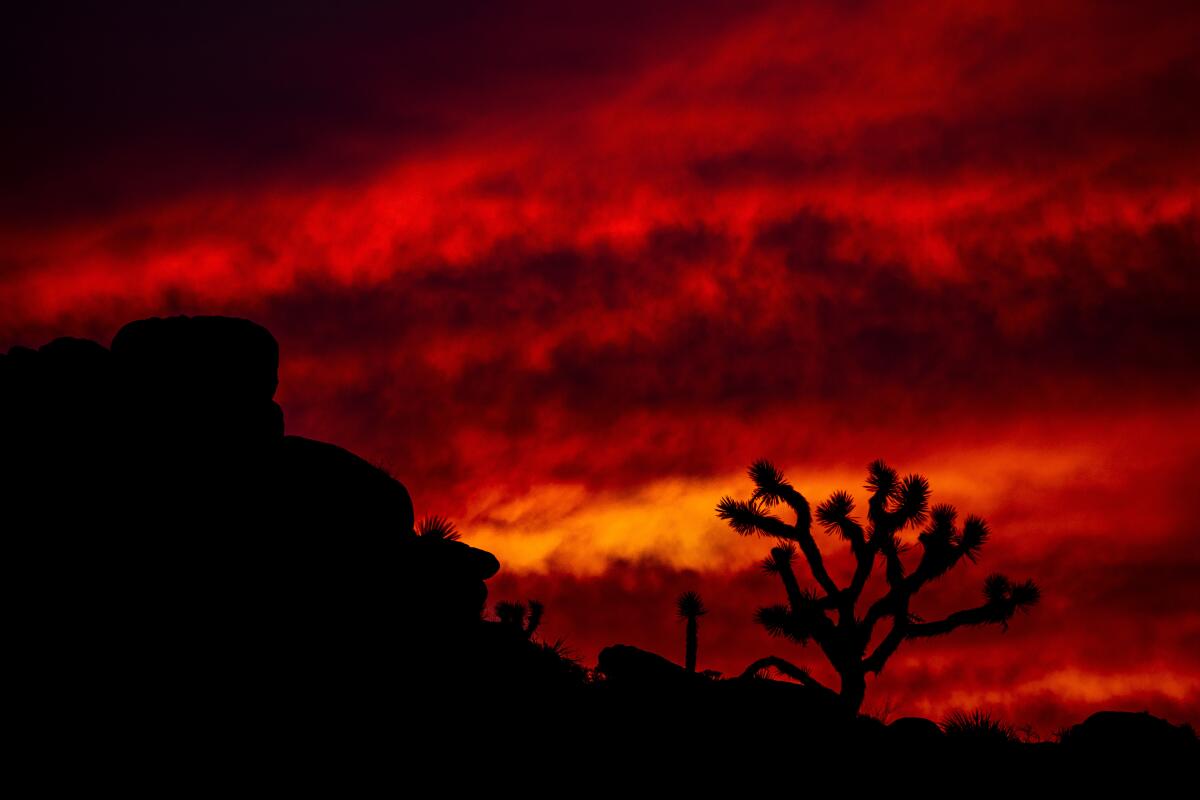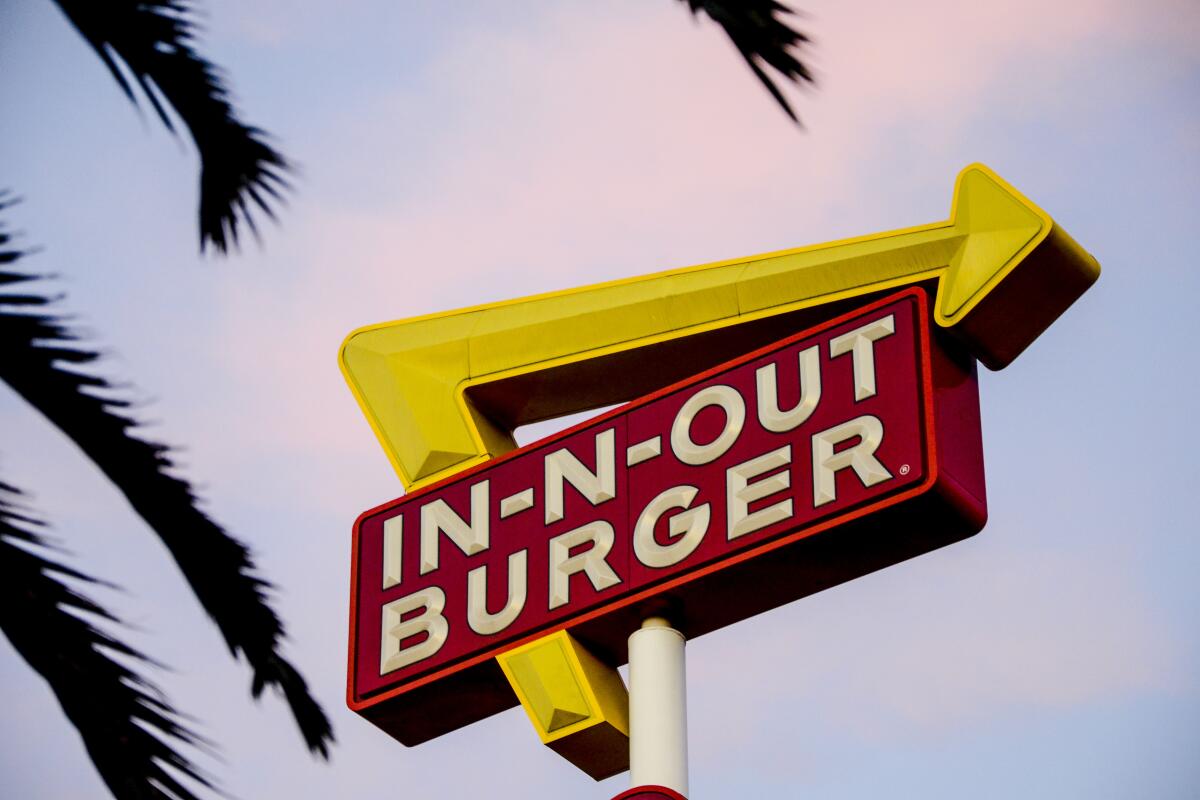Grace Danico/For The Times; Animations by Tomasz Czajka, Li Anne Liew
The 101 best California experiences
Hey, California people: Imagine an iceberg.
There’s the tip, and then there’s the best part: the 87% that’s hidden below the waterline.
OK, maybe it’s not so great if you’re the Titanic. But to me, after decades spent up and down California reporting on travel, the arts and the outdoors, the unseen 87% represents immense possibilities. It’s where the gold is, beyond the selfie spots, the mouse ears, the Golden Gate Bridge and the postcard vista from the Tunnel View parking lot in Yosemite.
Right now, many of us are itching to explore. We’re looking for new places and new ways of seeing old places.
That’s why I’m offering up my guide to the 101 best California experiences, made of the most resonant spots I’ve found across the state — including many I’ve come across in the last few months. A hike through Sequoia National Park’s biggest trees, now flanked by last year’s ashes and this spring’s flowers. A taste of the 626 Night Market. The eerie shapes in San Luis Obispo’s Poly Canyon. A bowl of ice cream in Strathmore. The wordless grace of Bob Baker’s marionettes. On this list, which is numbered but not ranked, there are no theme parks (but plenty of kid-friendly destinations), not many museums (because the best are easy to find), no made-for-Instagram “pop-up experiences.” It’s a peek into my travel notebook through the Golden State, a place that’s easily glimpsed and poorly understood.
So take this list, listen to the experts as the pandemic ebbs and flows, and go when you can. Use our checklist (black and white version here) to check off the things you’ve done, the destinations you’ve explored. And let us know what would have been on your list, and maybe we’ll get there in the months ahead. If these pages help push you to see anyplace or meet anyone new in the vast backyard we share, that’s a win.
Can we start summer now?
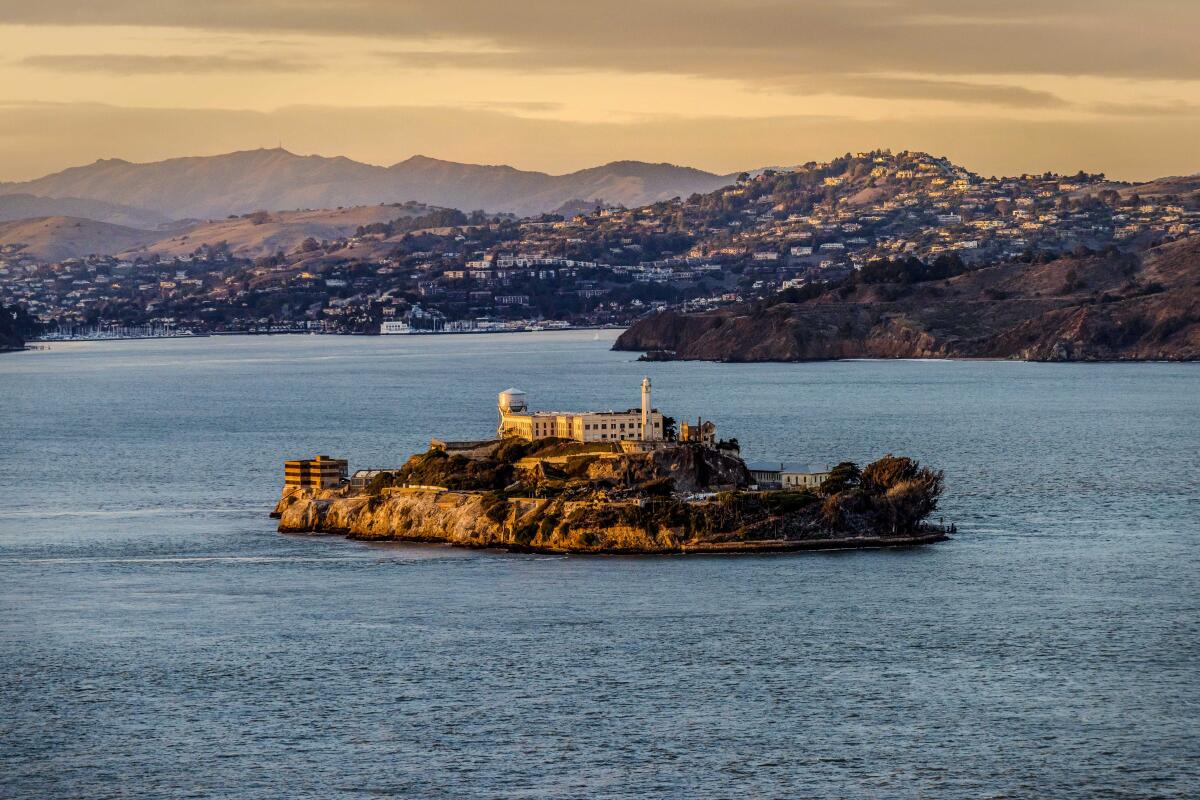
1. Escape to Alcatraz
When you reach the island aboard the 15-minute Alcatraz Cruises ferry from San Francisco’s Pier 33, one of the first things you see is graffiti from 1969-71, when Native American protesters occupied the island. The National Park Service opened the site, including the cellhouse, to the public in 1973. A current exhibition, “The Big Lockup,” examines the culture of incarceration in the U.S., where some 2.3 million Americans are behind bars. Tour prices start at $41 for adults, $25 for children (ages 5-11). Night tours are slightly pricier.
Bonus tip: For decades Alcatraz has been a tough ticket, with tours selling out weeks in advance. But now, with tourism to San Francisco still down dramatically, booking an Alcatraz visit is easy. If you’ve never done it (I never got around to it until 2017), this might be the time.
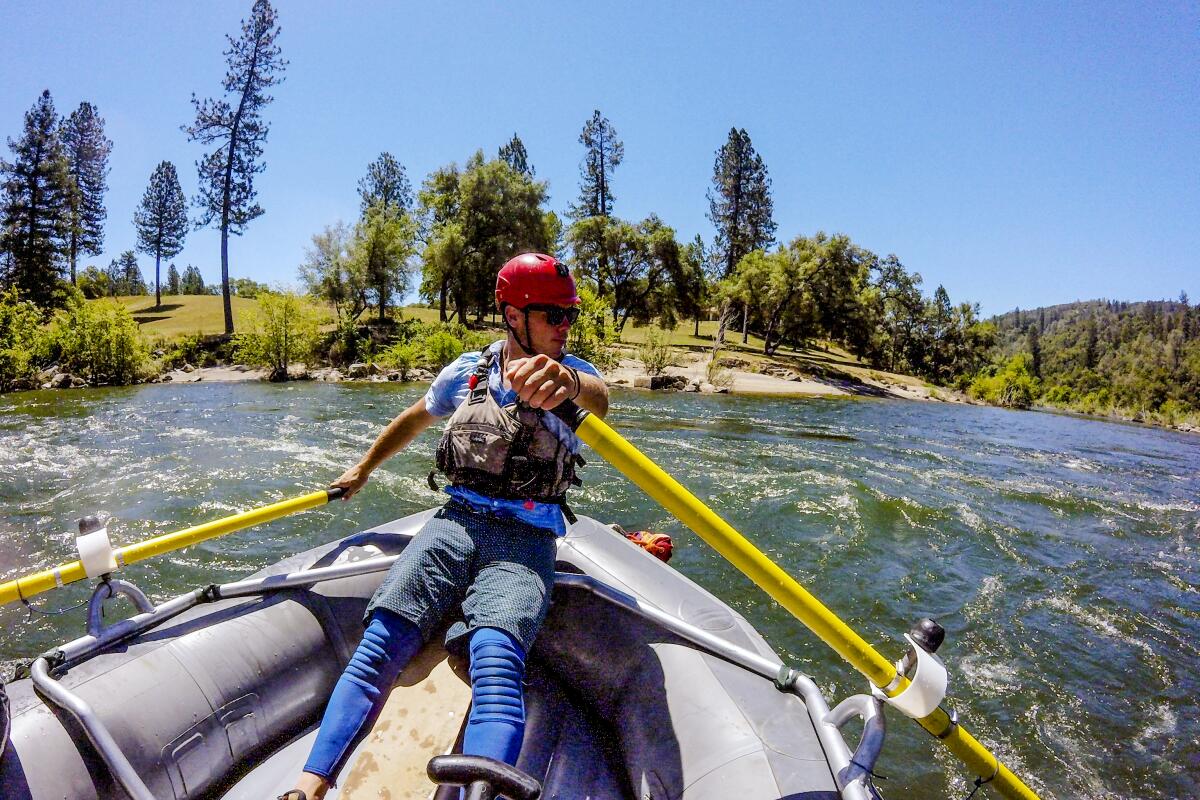
2. Raft the American River
Family-friendly river floats typically begin north of Placerville, below the Chili Bar Reservoir. One-day floats usually cover 10 miles. (Since there’s a dam upstream, water releases are steady and predictable.)
Once you are more experienced, there’s whiter water — Class IV — waiting along the middle and north forks of the American. Half-day and all-day rafting trips typically cost $120-$190 per person. Some companies offer two-day, 20-mile trips with a night of camping.
Bonus tip: Marshall Gold Discovery State Historic Park, where the Gold Rush began, is less than a mile from many of Coloma’s river outfitters along California 49. Placerville, handy to the river, is the nearest town with a selection of restaurants along its Main Street. I liked Heyday Cafe.
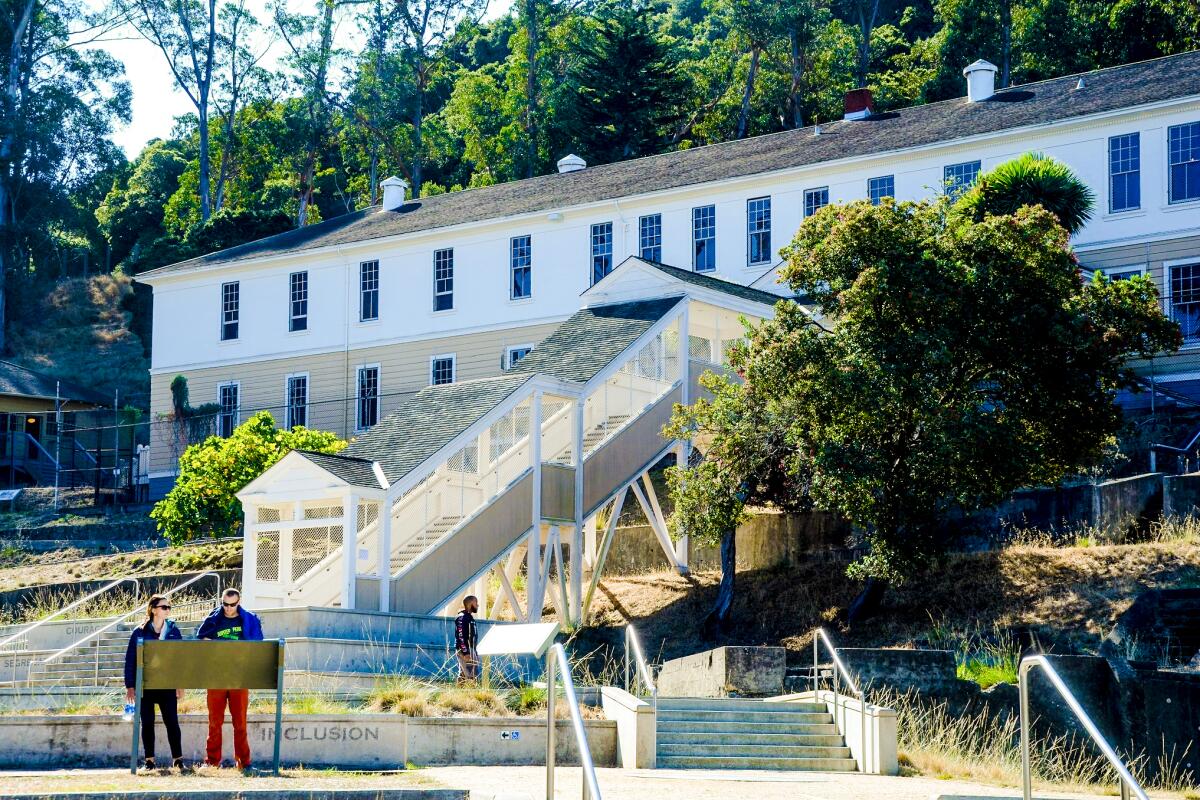
3. Ferry to Angel Island, where immigrants waited
But from 1910 to 1940, it had another identity entirely. This was the U.S. entry point for about half a million Asian immigrants, including 175,000 from China, who typically spent weeks or months locked in barracks before being allowed to enter. Some etched poetry on walls in the Immigration Station and barracks, a 1.5-mile walk from the Ayala Cove ferry landing. You can walk through the barracks (a.k.a. the Detention Barracks Museum, open Wednesday through Sunday), though guided tours have not yet resumed. In the same compound, you can also visit the fledgling Angel Island Immigration Museum, housed in the island’s old hospital and open on weekends from 11 a.m. to 3:30 p.m.
Bonus tip: Instead of lining up at the Ferry Building in San Francisco, think about driving out to Tiburon — a handsome, upscale, waterfront town of 9,200 — and catching a 10-minute Angel Island Ferry ride from its downtown.
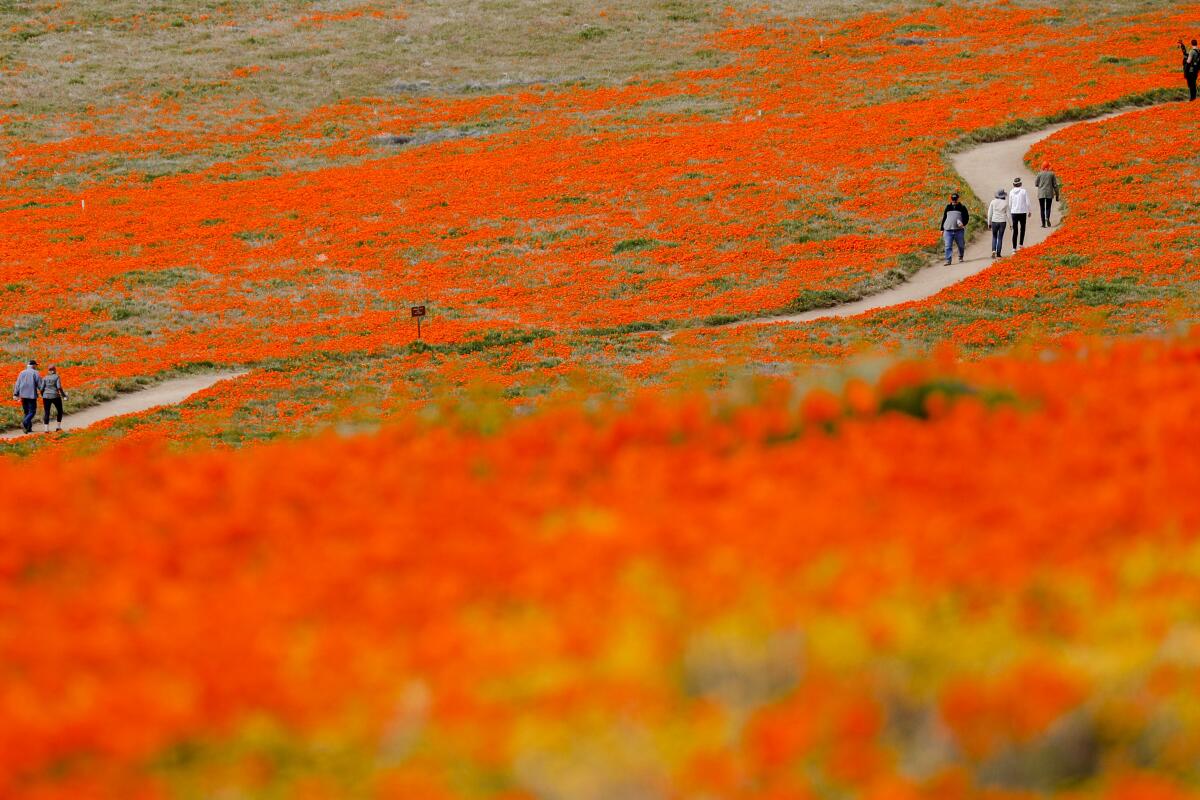
4. Enter a world of poppies in Antelope Valley
Bonus tip: In years like 2019, when a superbloom attracted thousands of visitors, the reserve’s parking lot isn’t nearly big enough. In milder years like 2022, it’s not so bad. Bear in mind that many poppies bloom on roadside slopes outside the reserve. If you can do so safely, legally park on a shoulder along or near Lancaster Road and you might save $10.
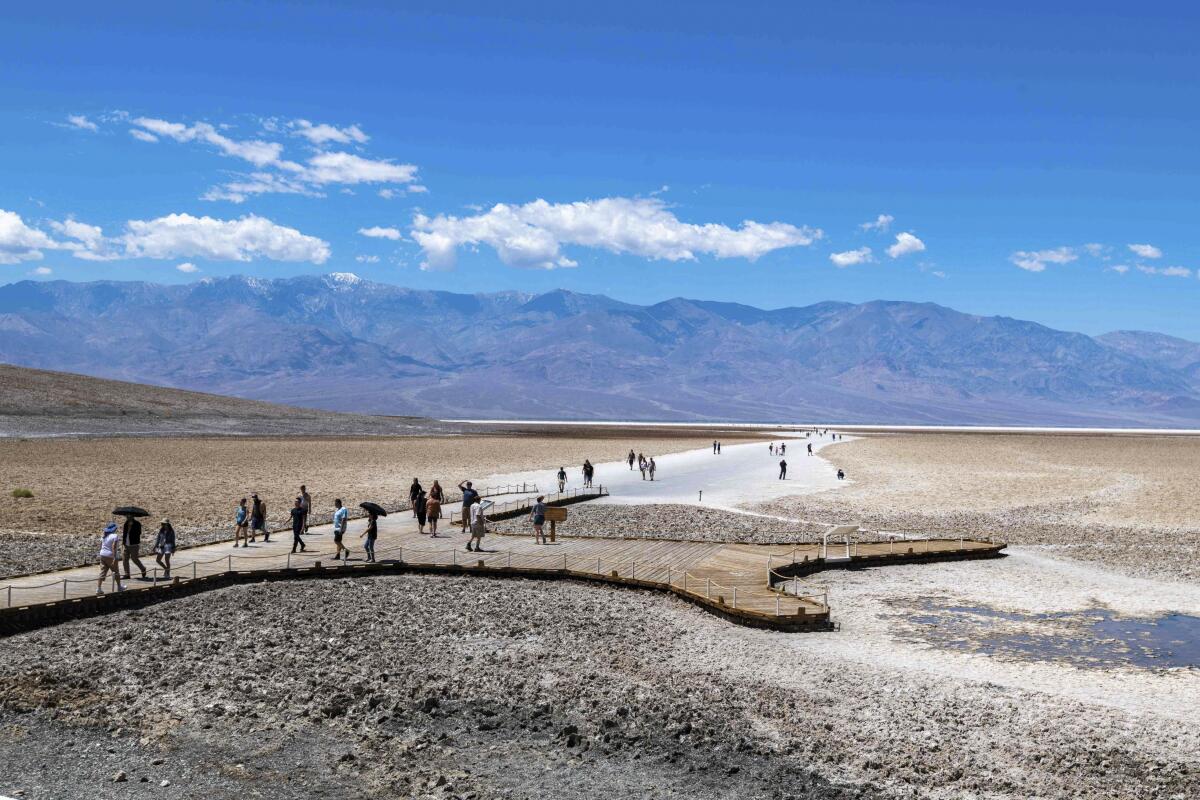
5. Crunch the crusty plains of Badwater in Death Valley
And Badwater Basin, a crusty old lake bed between forbidding mountains, isn’t just Death Valley’s low point. It’s the lowest, driest and often hottest point in North America, 282 feet below sea level. It’s especially vivid and perplexing just after sunset when there’s a prominent moon — because how can there be a moon in the sky, when you seem to be standing on its surface already? The salty valley floor crunches underfoot. Also, don’t miss the Mesquite Flat Sand Dunes or Zabriskie Point, both sunrise hot spots. (Scotty’s Castle, another longtime favorite, will be closed for repairs until at least April 2023.) If you’re ready to splurge, the Oasis at Death Valley resort’s Inn at Death Valley has 88 rooms and casitas and a spring-fed swimming pool that’s always 87 degrees.
Bonus tip: If you’d rather rattle your bones on a rugged road, take a four-wheel-drive vehicle with high clearance on the 26-mile journey to the Racetrack, another dry lake bed, where wind and low temperatures combine to mysteriously scoot rocks across the vast, white plain. It’s terrific and an eerie photo op.
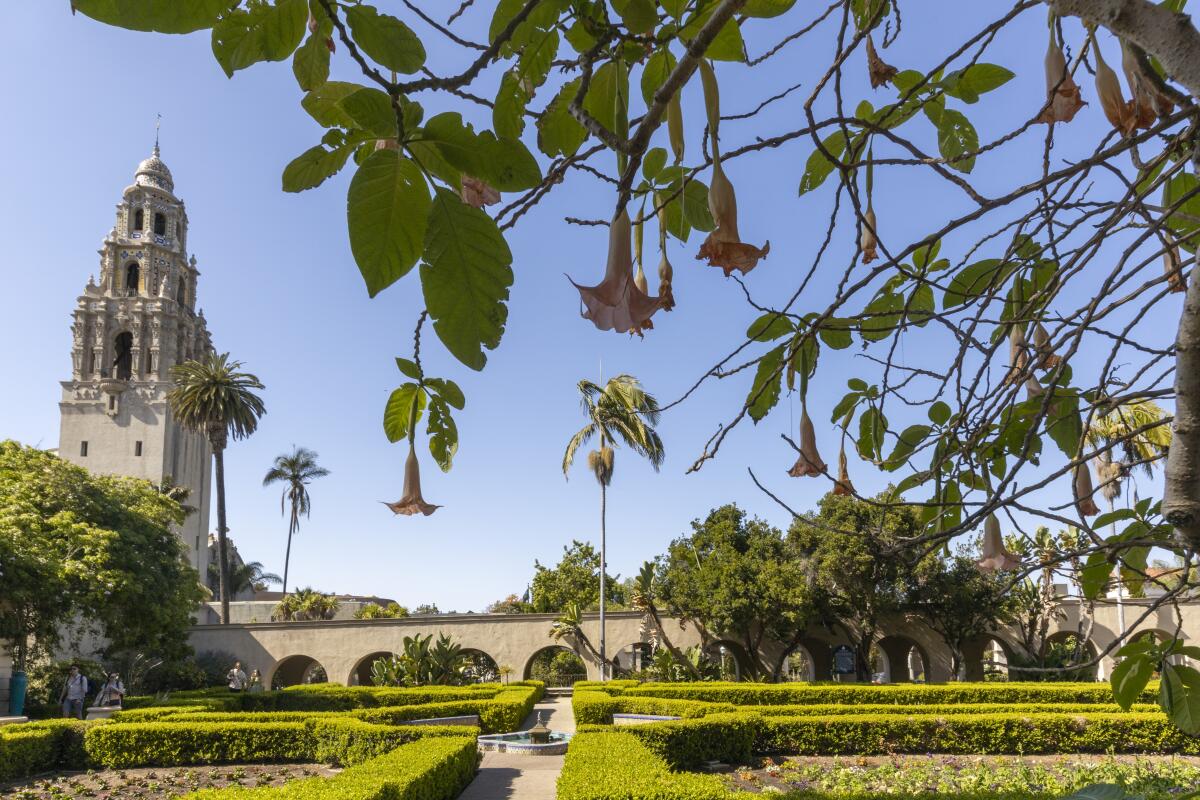
6. Flop by the lily pond in Balboa Park
But wait a minute. Consider that the zoo is less than 10% of Balboa Park, which covers 1,200 acres. The park also is home to about 20 museums and cultural organizations featuring fine art, photography, global folk art, natural history, science, flight and more, plus a new Comic-Con Museum. The Old Globe theater complex includes three venues. To feel the park’s full embrace — at no cost — flop on the lawn at the big lily pond by the Botanical Building. The building’s interior is closed for repairs, but you can enjoy the koi in the pond and stroll up the Prado. Try lunch at the Prado restaurant.
Bonus tip: The miniature landscapes in the San Diego Model Railroad Museum will knock you out.
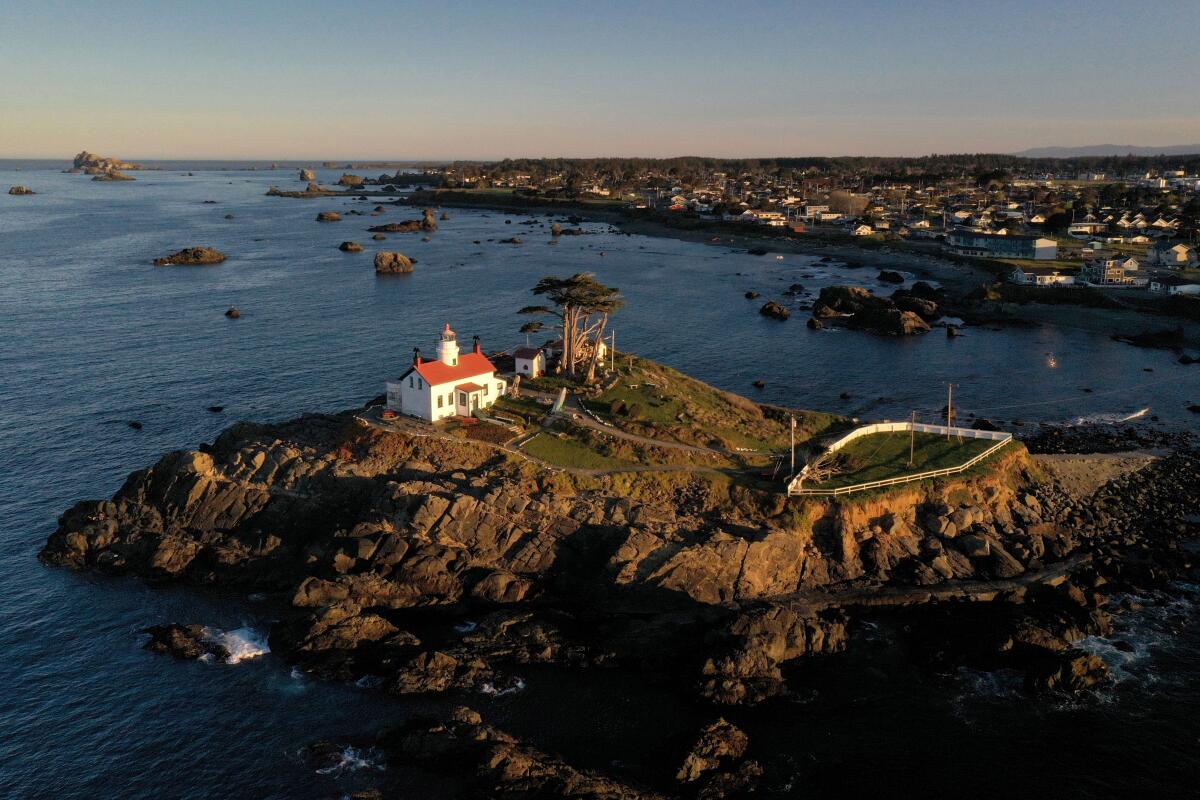
7. Walk to Battery Point’s lighthouse at low tide
Bonus tip: Sixteen miles south of Crescent City waits a classic roadside attraction: the Trees of Mystery, which includes trails through a redwood forest, an elevated canopy walk, a gondola and a 49-foot-high Paul Bunyan standing out front with his 35-foot blue ox, Babe. Don’t be surprised when Mr. Bunyan says hello — there’s a hidden sound system and live narrator helping the big man make small talk.
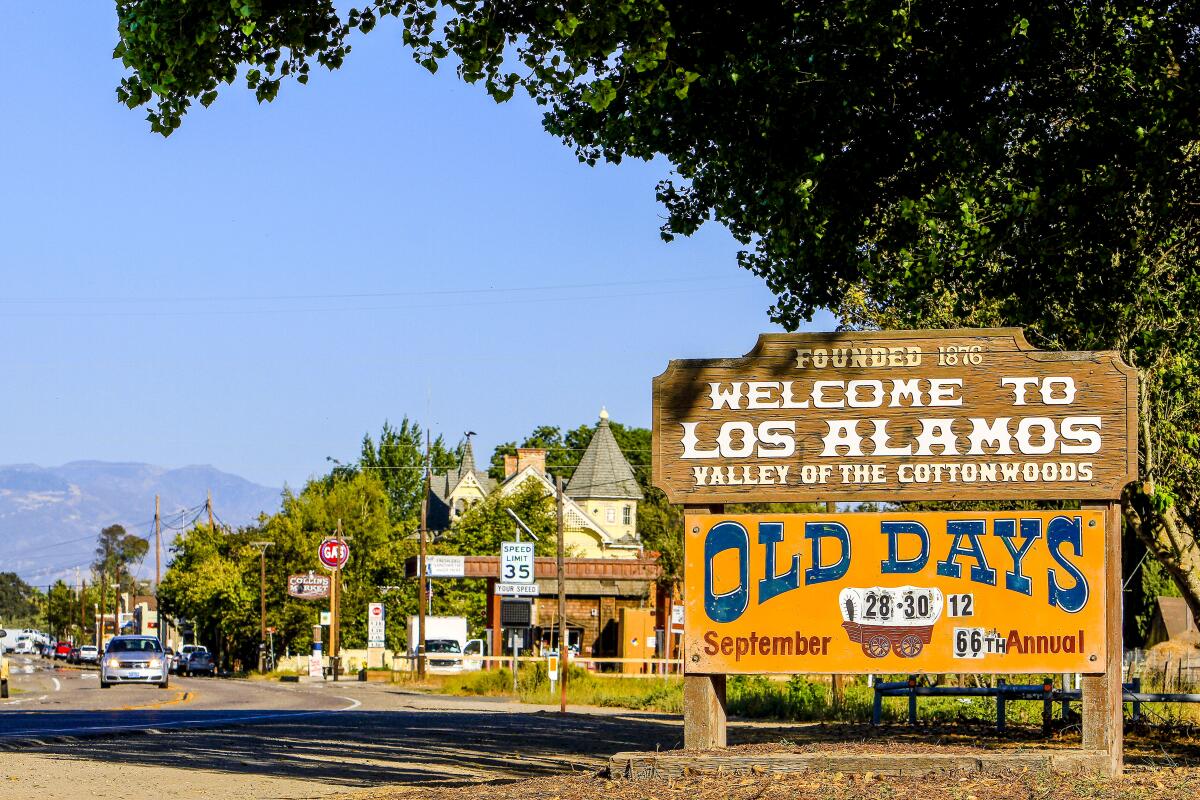
8. Eat well on Bell Street, Los Alamos
Bell Street, the town’s main drag, has an Old West feel, several stylish restaurants, a handful of tasting rooms and a few antique shops. Bell’s Restaurant, whose bistro fare won a Michelin star last year, offers a $75 prix fixe dinner menu, Thursdays through Mondays. (It also does lunch on those days.) Bob’s Well Bread Bakery and Plenty on Bell are popular for breakfast and lunch; Full of Life Flatbread does big dinner business. The menu at Pico (that’s the building with the “GENERAL STORE” sign out front) includes salmon tartare with seaweed and hanger steak with house chimichurri.
You could stay at a trendy motel (Alamo Motel) or a Victorian bed-and-breakfast with elaborately themed rooms (Victorian Mansion). If you’re splurging, the Skyview Los Alamos may be the answer.
Bonus tip: Several restaurants in town also rent cottages through Airbnb, including Bob’s Well Bread Bakery, Bodega Wine and Beer Garden and Pico.
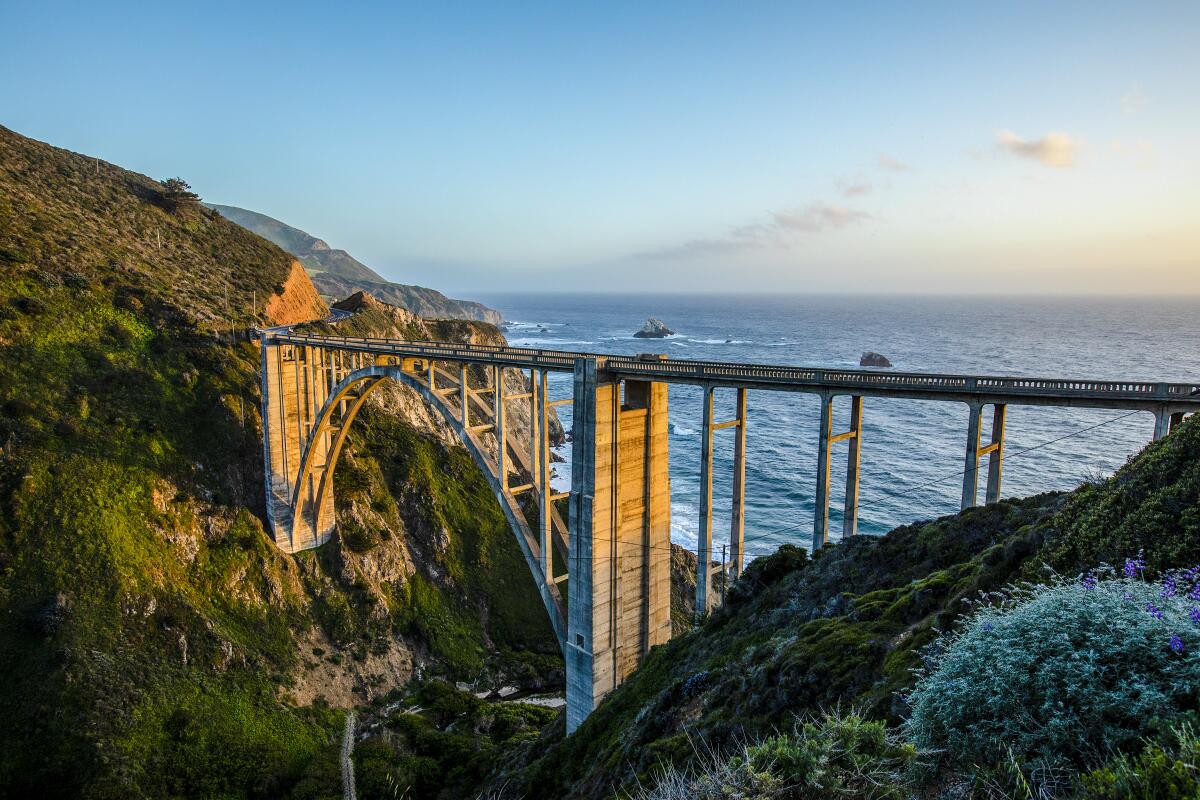
9. Munch a burger with Big Sur at your feet
At this clifftop compound of two restaurants and a gift shop, diners since 1949 have gaped at the surf and rocks 800 feet below. Nepenthe restaurant does lunch and dinner indoors and out, including its celebrated Ambrosia burgers and vegetarian burgers. Café Kevah, on a terrace, does breakfast and lunch.
Once you’re full of calories, there’s plenty of hiking. In Julia Pfeiffer Burns State Park, you’ll find the half-mile trail overlooking McWay Falls. In Andrew Molera State Park, the Creamery Meadow Trail will take you across the Big Sur River. At Bixby Creek Bridge, you’ll find a familiar view and distracted drivers jockeying for parking spots.
Overnights can be challenging, because affordably priced public campgrounds often book up months in advance. At the private Ventana Campground, summer sites start at $80. At Big Sur Campground and Cabins, campsites this summer are fetching $190 a night and cabins are priced at $430 and more. If your pockets are even deeper than that, the Post Ranch Inn and Ventana Big Sur (where $1,000 a night is routine) stand ready.
Bonus tip: Be warned that mudslides (and sometimes fires) often force California 1 to close, so check its status on the Caltrans website before any journey.
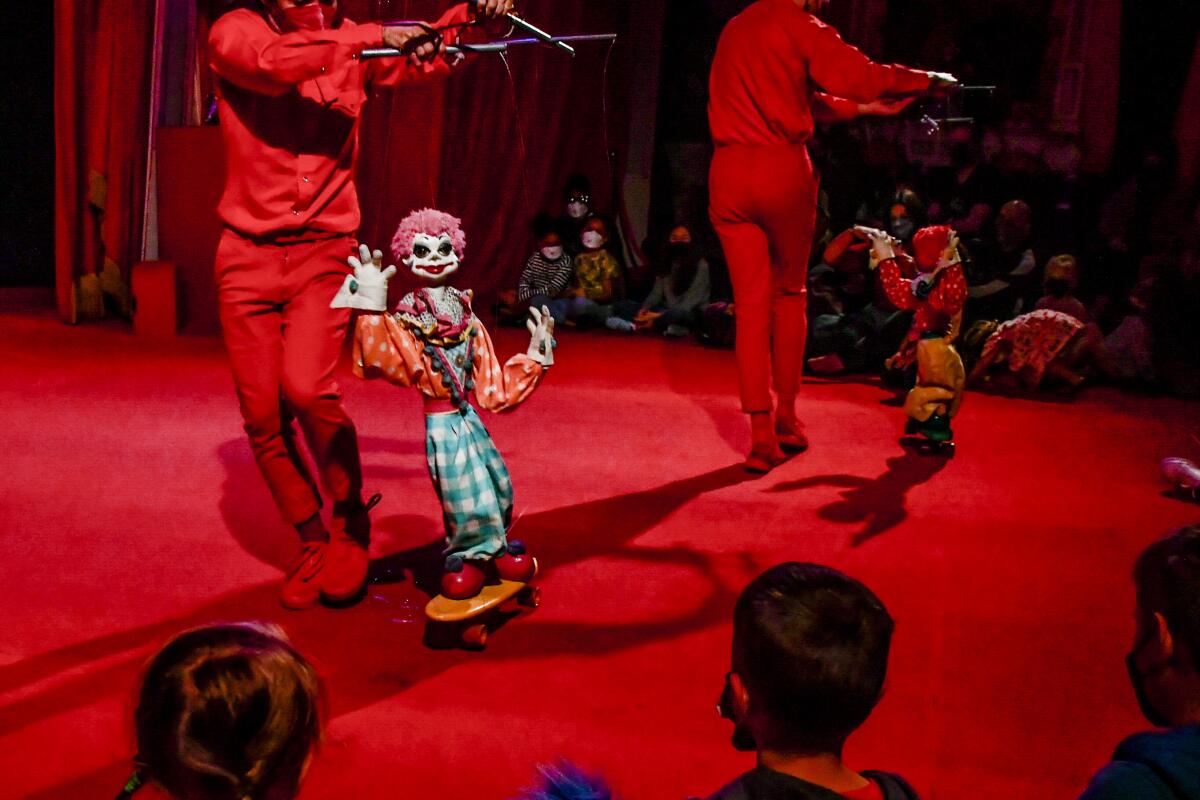
10. Let Bob Baker’s people pull your heartstrings
Bob Baker founded the theater in 1963 with partner Alton Wood, created thousands of marionettes and ran the outfit for decades in a rustic cinderblock-walled space near the edge of downtown Los Angeles. Legions of pint-sized Angelenos passed through, many of whom are now grandparents.
Now comes a new chapter. Since Baker’s death in 2014 at age 90, the troupe has moved to a splendid (and very red) space on York Avenue at the border of Highland Park and Eagle Rock.
The venue holds fewer than 100 people and most kids sit “criss-cross applesauce” style on the carpet in front. Weekend shows (“Something to Crow About” is a perennial) typically begin with jaunty organ intro music by Mr. Ed Torres, followed by about an hourlong presentation that features 100 or more marionettes, which waltz madly, sing operatically, bat eyelashes and operate right at a kid’s eye level. One Saturday per month, there’s a Sabados Animados cartoon morning. At the end of the regular shows (don’t tell the kids) there’s surprise ice cream. Tickets $22 for adults and children, advance reservations required.
Bonus tip: This stretch of York includes plenty of treats for grown-ups. The Highland Cafe oozes cool (avocado toast, $10), the York serves gastropub fare and the Pop-Hop sells books and offers arts workshops.
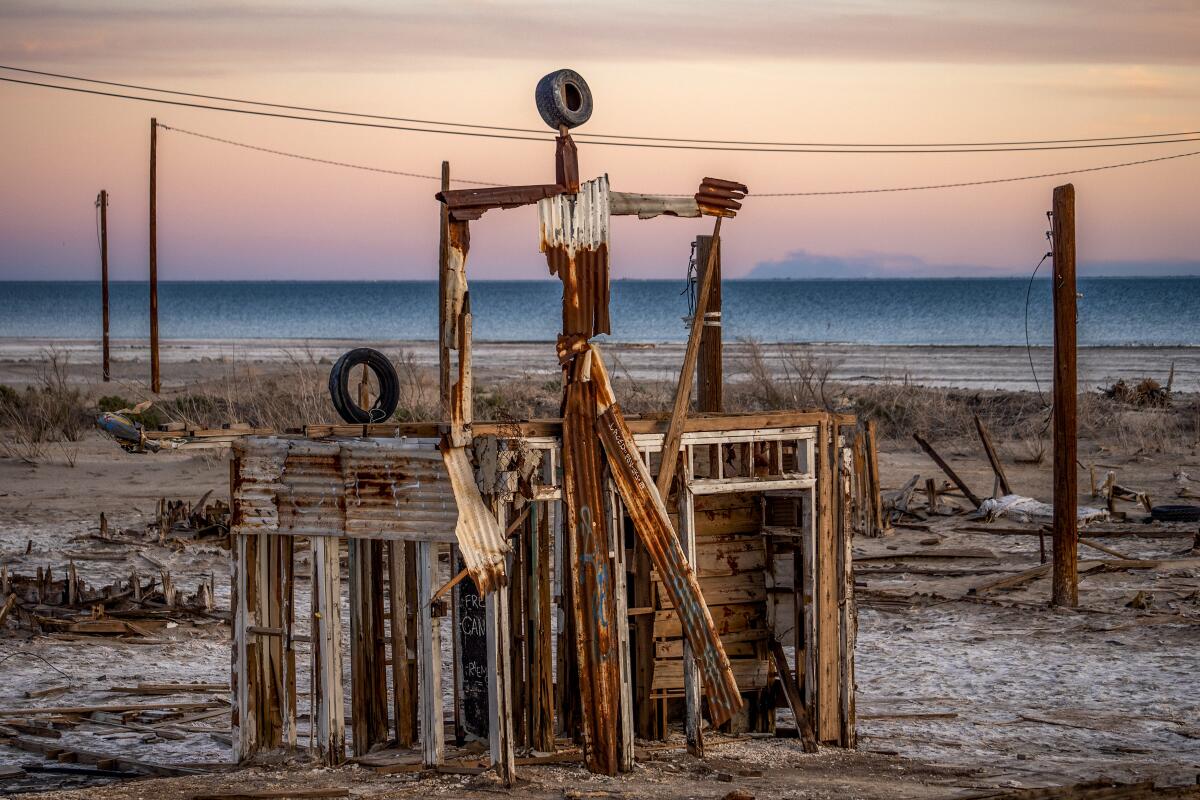
11. Anticipate the apocalypse at Bombay Beach, where art and nature collide
This was a mainstream vacation destination 70 years ago, when the sea (created by an irrigation canal mishap in 1905) was healthier. Now it’s a grid of 32 square blocks with perhaps 300 residents. It has a single bar/restaurant, the Ski Inn (usually open 10 a.m. to 2 a.m.), a market and more than 20 Airbnb units, but not everyone will want to spend the night.
It’s edgy but beloved. Especially by migrating birds, frugal retirees and a gaggle of artists. There’s even a Bombay Beach Biennale (which denotes the January-March spell when many part-time residents converge to stage events, make things and build community). Don’t miss the plane standing on its nose at 1st and H (“Lodestar” by Randy Polumbo) or the painted televisions at 4th and H. Near sunset, cross the 5-foot berm between the community and the seashore (5th and E) to behold the most dramatically sited sculptures and installations, baking and crumbling amid the miles of gritty sand, salty water and empty sky. Anyone intrigued by the rebel spirit and raw creativity at nearby Salvation Mountain and Slab City will be right at home at Bombay Beach.
Bonus tip: Drive through town again once the sun is down, because several installations are lighted after dark.
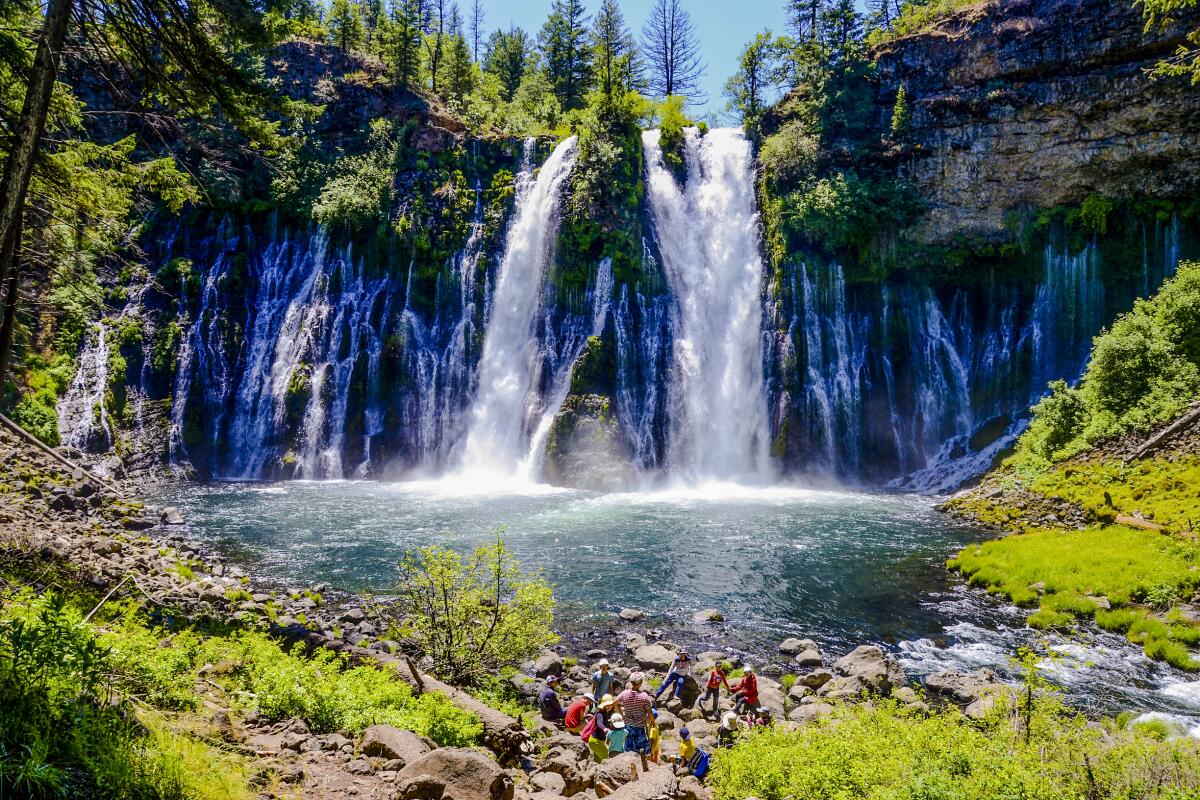
12. Soak up the mist from Burney Falls
Bonus tip: For more falling water, continue to McCloud Falls, a series of three cascades about 45 miles northwest of Burney Falls along California 89.

13. Grab pole position on a San Francisco cable car
The cable cars cover three routes: Powell-Hyde, Powell-Mason and California Street. As a newbie, you want Powell-Hyde, beginning at Powell and Market streets (where there’s often a queue, along with buskers and panhandlers). Over hills and around corners you’ll ride to Fisherman’s Wharf. The brakes will squeal. Somebody over 50 will make a Rice-A-Roni joke. From the top, spy twisting Lombard Street and Coit Tower to the east, Alcatraz in the bay ahead.
On arrival, grab Irish coffee at the Buena Vista on Beach Street or venture into the tourist extravaganza that is Fisherman’s Wharf. Fare is $8 one-way in advance (which is a poor value) or $13 for a one-day Muni Visitor Passport through the MuniMobile app. That will give you a day of travel on cable cars, historic streetcars and other Muni and Muni Metro transit. For a mellower ride with fewer tourists and great views down to the Bay Bridge, try the California Street line.
Bonus tip: For the fuller story on how your thrill ride traces back to 1873 and a man named Andrew Hallidie, head to the Cable Car Museum (it’s free) in the old Washington-Mason powerhouse and car barn on Nob Hill.
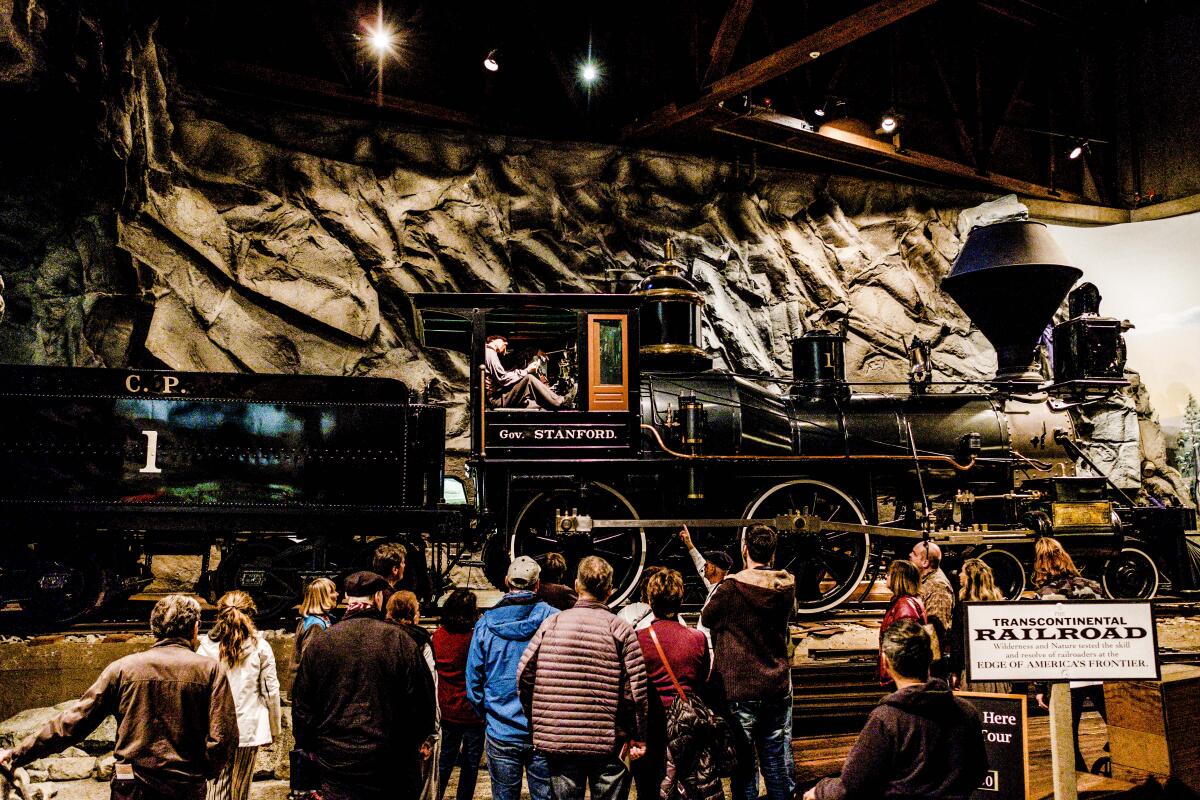
14. Inspect cabooses at the state railroad museum
The rail museum, open daily, includes sleeping cars, dining cars, cabooses and exhibits covering subjects from the harsh lives of exploited Chinese rail workers to the luxurious accommodations of high-end railroad photographers Lucius Beebe and Charles Clegg. On weekends, there are 50-minute excursion rides along the Sacramento River (adult tickets $15-$25). Adult admission is $12.
Bonus tip: The 4.2-mile Sacramento River Bike Trail runs right past the museum, and Amtrak’s Sacramento Valley Station is a five-minute walk away.
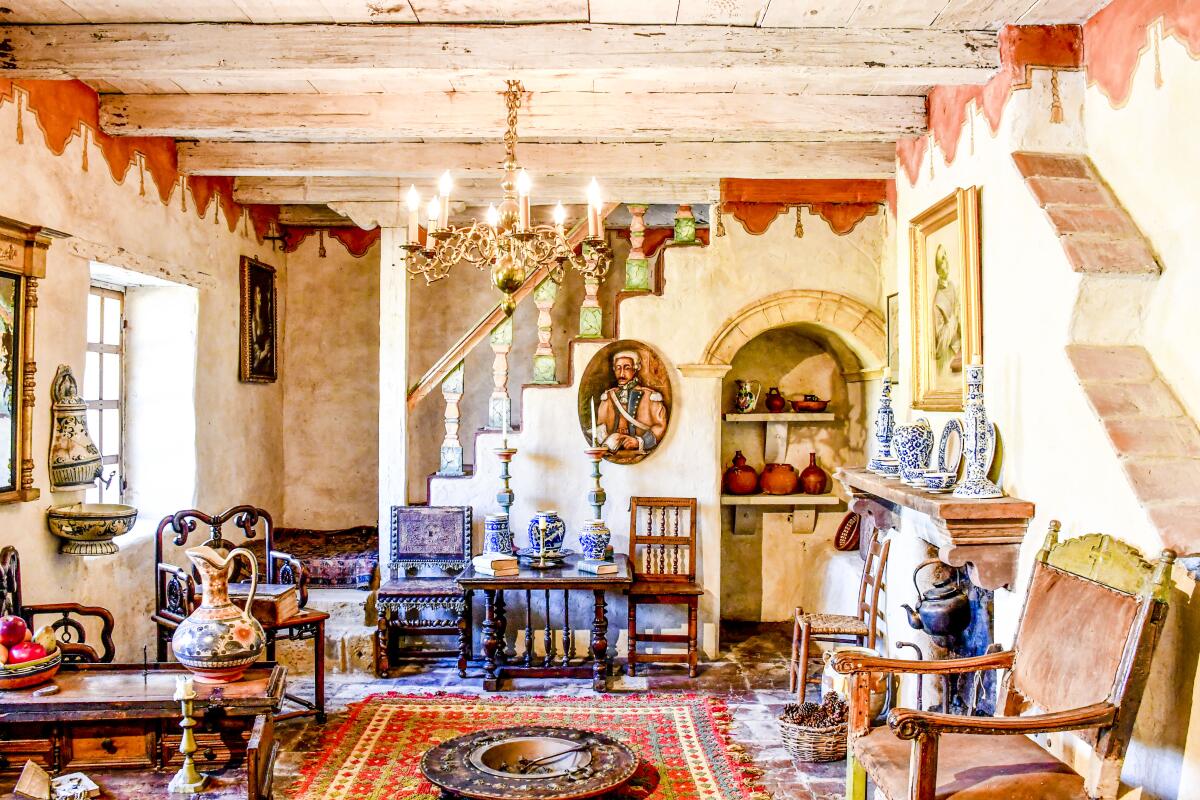
15. See how California Christianity and colonization began at the Carmel Mission
The Carmel Mission, officially San Carlos Borromeo de Carmel Mission, includes a basilica, museums and a courtyard, still home to an active parish. Check out a reconstruction of the cell where Serra is said to have died in 1784. The Spanish missionaries brought Christianity, literacy, Mediterranean architecture and a new economy, but at great cost. Many historians now focus on how native Californians were exploited and violently repressed throughout the system’s rise and fall under Spain, Mexico and then the U.S. Many of these Indigenous people are buried in the mission cemetery.
Bonus tip: The first of the missions (founded 1769) still functions in San Diego; the last (1823) is part of a state historic park in Sonoma. The most-visited one might be Orange County’s Mission San Juan Capistrano, which has ruins, gardens and its own Amtrak stop. The prettiest might be Santa Barbara (big, pink facade). The kid-friendliest might be the one at La Purísima State Historic Park near Lompoc, which includes paddocks full of horses and livestock.
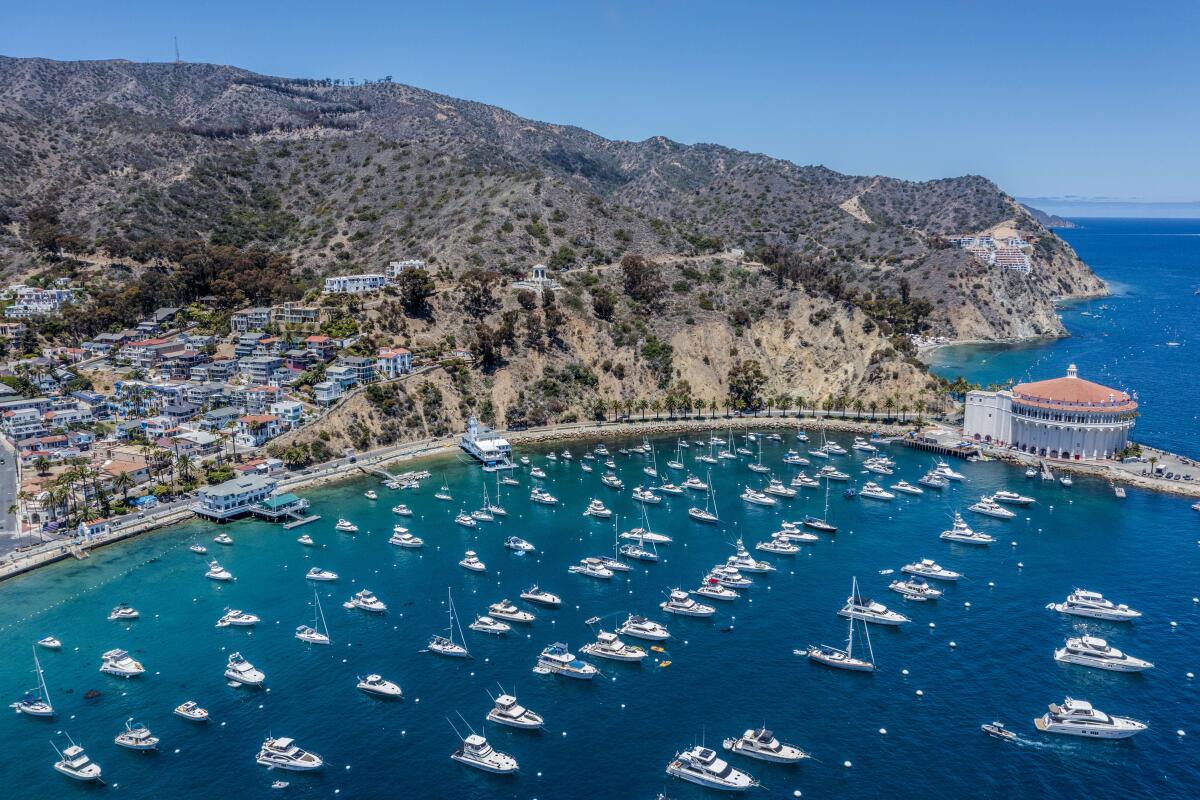
16. Sail to Catalina Island (and watch for dolphins)
Bonus tip: There’s hiking and camping near Two Harbors and beyond, including a 38.5-mile, four-day adventure known as the Trans-Catalina Trail. You begin in Avalon and end at Two Harbors, the island’s second port. On your way, beware of bison.
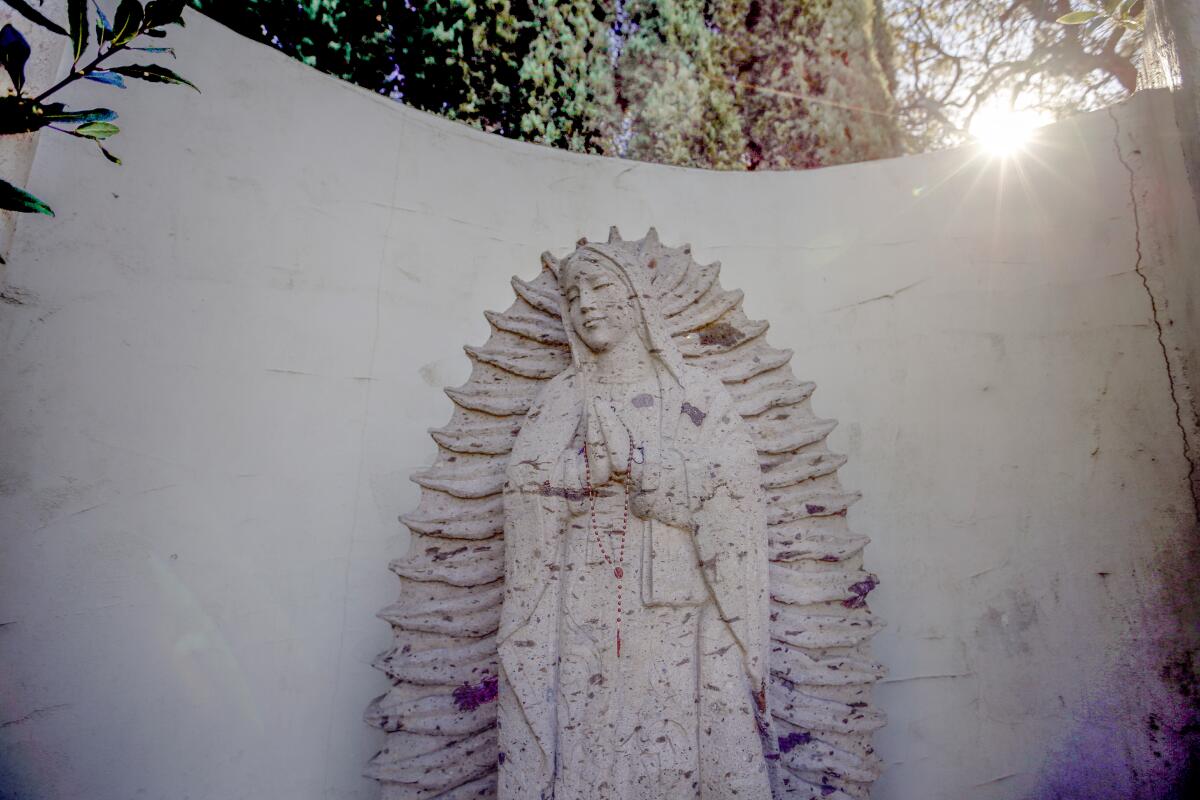
17. Find César Chávez’s legacy tucked into the Tehachapis
Chávez, who was born in Yuma, Ariz., might be the most influential labor leader in California history. The national monument’s visitor center, part of a 187-acre compound managed by the Chávez Foundation, includes biographical videos, a re-creation of his office, a memorial garden and exhibits detailing the many causes he pursued. Admission is free.
For breakfast or lunch, try the Keene Cafe half a mile west of the monument on Woodford-Tehachapi Road. Or pause in Tehachapi, about 11 miles southeast of the monument, for a stroll and a snack at Kohnen’s Country Bakery.
Bonus tip: Just 3.2 miles east of Keene, you can see a marvel of railway engineering that draws fans from around the world. From a roadside overlook, you can see the Tehachapi Loop, a 3,800-foot section of railroad track built by Southern Pacific engineers and Chinese immigrant laborers in the 1870s and still used by dozens of freight trains daily. Employing an array of bridges and tunnels, the route makes an elegant spiral as it climbs at a 2.2% grade. Any train 4,000 feet or longer will briefly pass over its own rear cars in the tunnel 77 feet below.
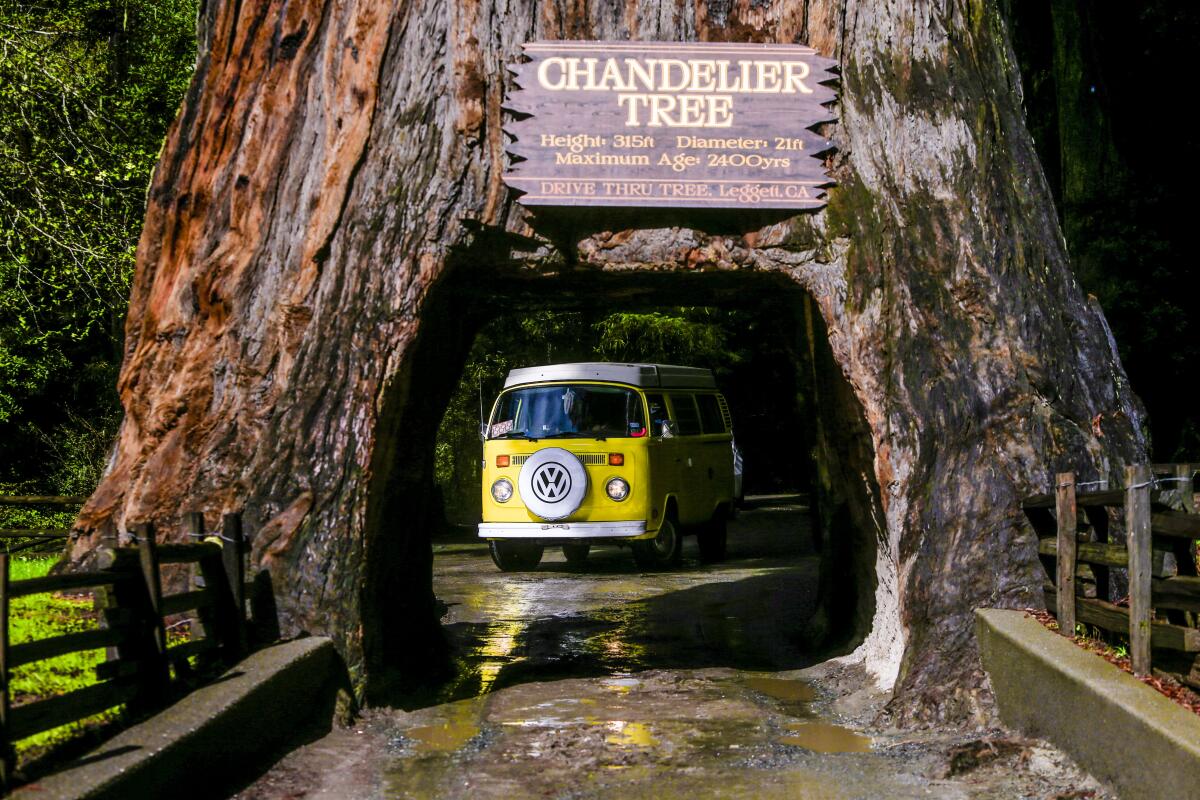
18. Roll slowly through California’s foremost drive-through tree
Then go deeper. About 75 miles farther north on U.S. 101, near Garberville, you’ll reach the 31-mile-long Avenue of the Giants. At Humboldt Redwoods State Park, stop to inspect the magnificent corpse of the Dyerville Giant, once thought to be the world’s tallest tree at 370 feet.
Bonus tip: Tuck in your mirrors.
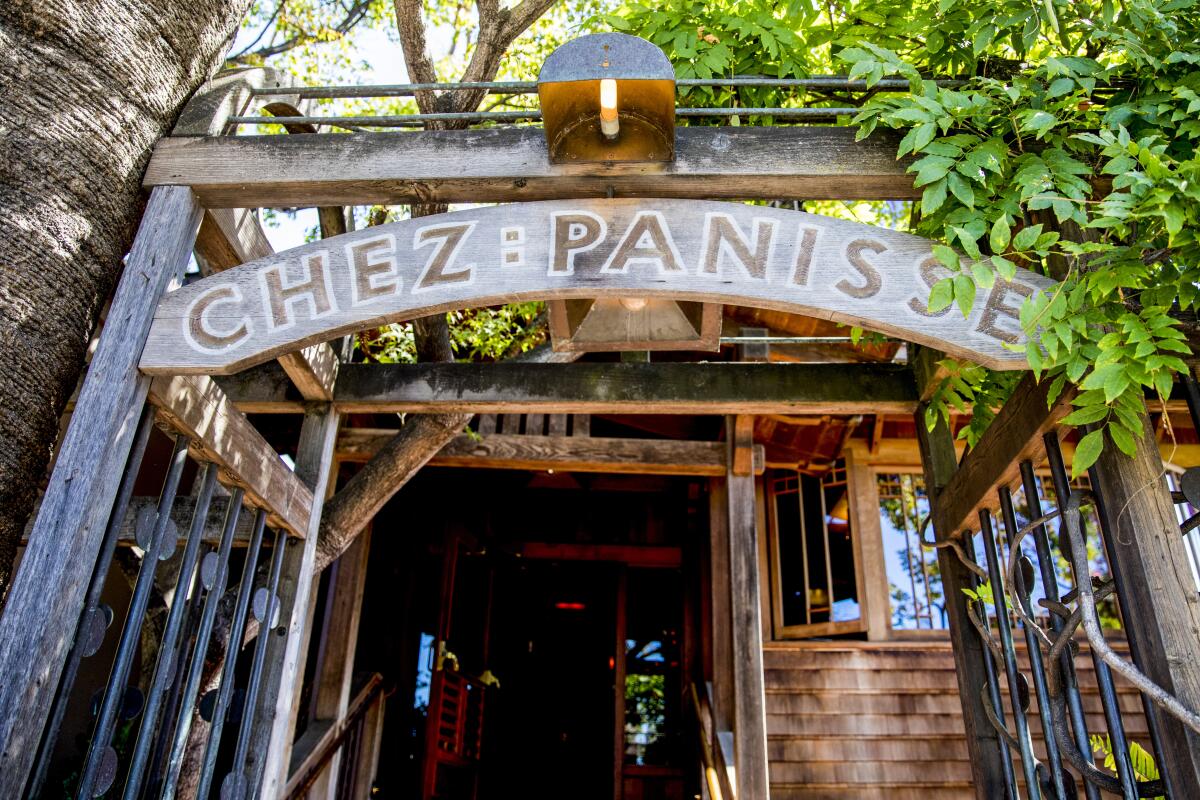
19. Sample something fresh in the dining room where California cuisine took off
Half a century later, Chez Panisse is still popular — so popular that its high-toned downstairs restaurant can charge $175 per person for a four-course set-menu dinner (before taxes, tip and beverages) and still book up weeks ahead. After offering takeout meals through the pandemic, the restaurant and more casual upstairs cafe both reopened for dinner in March, with the cafe expected to reopen for lunch soon. The menu, seasonally tuned, changes daily in the cafe, weekly in the restaurant. Reservations are accepted up to a month in advance. The restaurant and cafe close on Sundays and Mondays.
Bonus tip: This stretch of Shattuck Avenue, known as the “gourmet ghetto,” also includes the Cheese Board Collective, just across the street from Chez Panisse and founded in the same year. It’s a worker-owned co-op that’s become an empire, with a bakery and cheese shop (both open Tuesdays through Saturdays), along with a pizzeria that serves pizzas and salads Thursdays through Saturdays.
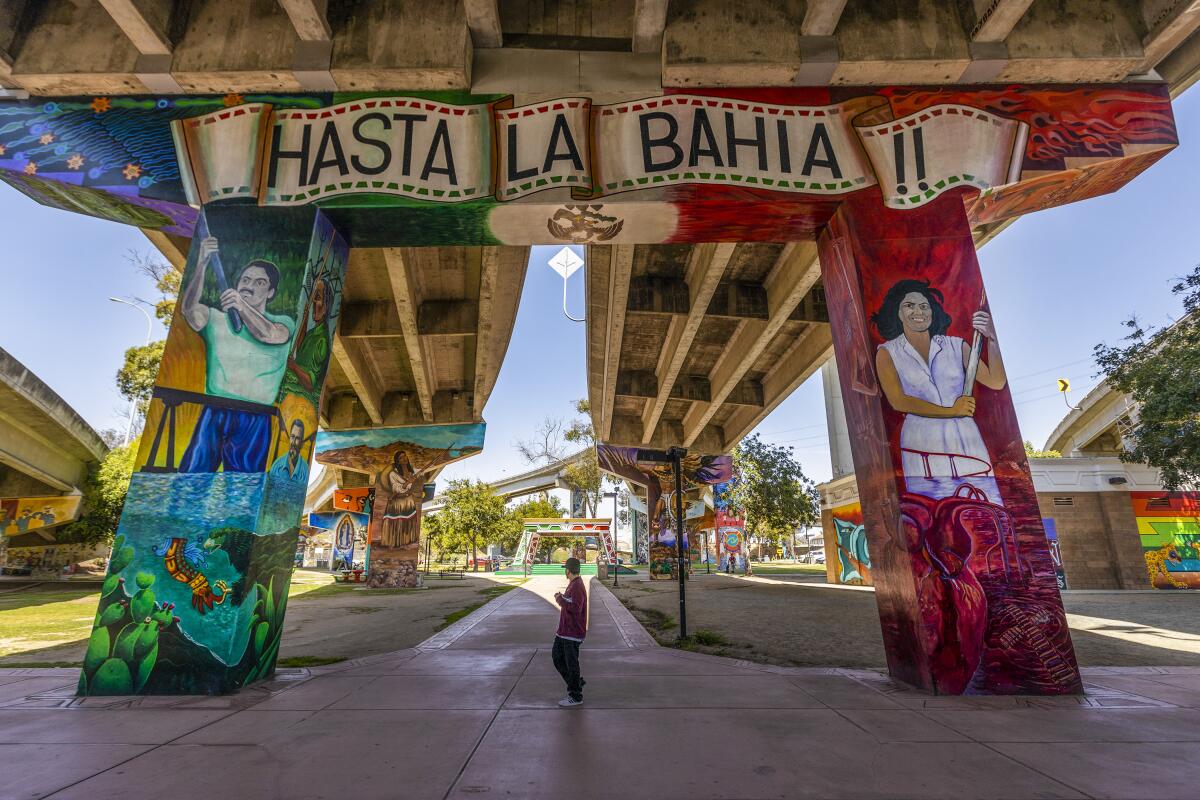
20. Gape at the murals of a movement — on the underbelly of a bridge
Then in 1970, when the California Highway Patrol started building an office where a park was expected, the largely Mexican American neighborhood rose up, occupied the site for 12 days and at last got a 7-acre park built. Soon after came the murals, followed by restaurants, galleries and the barrio’s designation as a cultural district. Now there are about 80 murals, some celebrating Mexican icons Pancho Villa and Frida Kahlo. In 2017, federal officials added the park to the National Register of Historic Places, crediting artists Salvador Torres, Mario Torero, Victor Ochoa and others.
Bonus tip: Within two blocks, you can get flautas at Las 4 Milpas, tacos at Salud!, beer at Border X Brewing or coffee at Por Vida Barrio Logan, all along Logan Avenue.

21. Catch the dawn of a new era in Chinatown
So get yourself to Chinatown’s Portsmouth Square, where Brannan flashed his nugget and lots of locals now play cards and ride skateboards. Walk among the dangling lanterns of Grant Avenue — the oldest street in the city — and Stockton Street, where markets are filled with Asian produce and browsing Chinese seniors. Pause beneath the brightly painted balconies of Waverly Place. This might be the most densely populated neighborhood in California.
For a taste of its possible future, check out the China Live food bar-and-retail complex on Broadway (opened in 2017), which often gets called “the Eataly of Chinese food.” Drop in on Mister Jiu’s on Waverly Place (opened 2016) or Empress by Boon (opened 2021, with wraparound views of the city and bay).
Bonus tip: The tiny Golden Gate Fortune Cookies factory (on Ross Alley since 1962) and the Chinatown Kite Shop (on Grant Avenue since 1969), prime stops for families with young children, are hanging in there. Also, neighborhood organizations have been staging lion and dragon dances every Saturday and Sunday at 3 p.m.
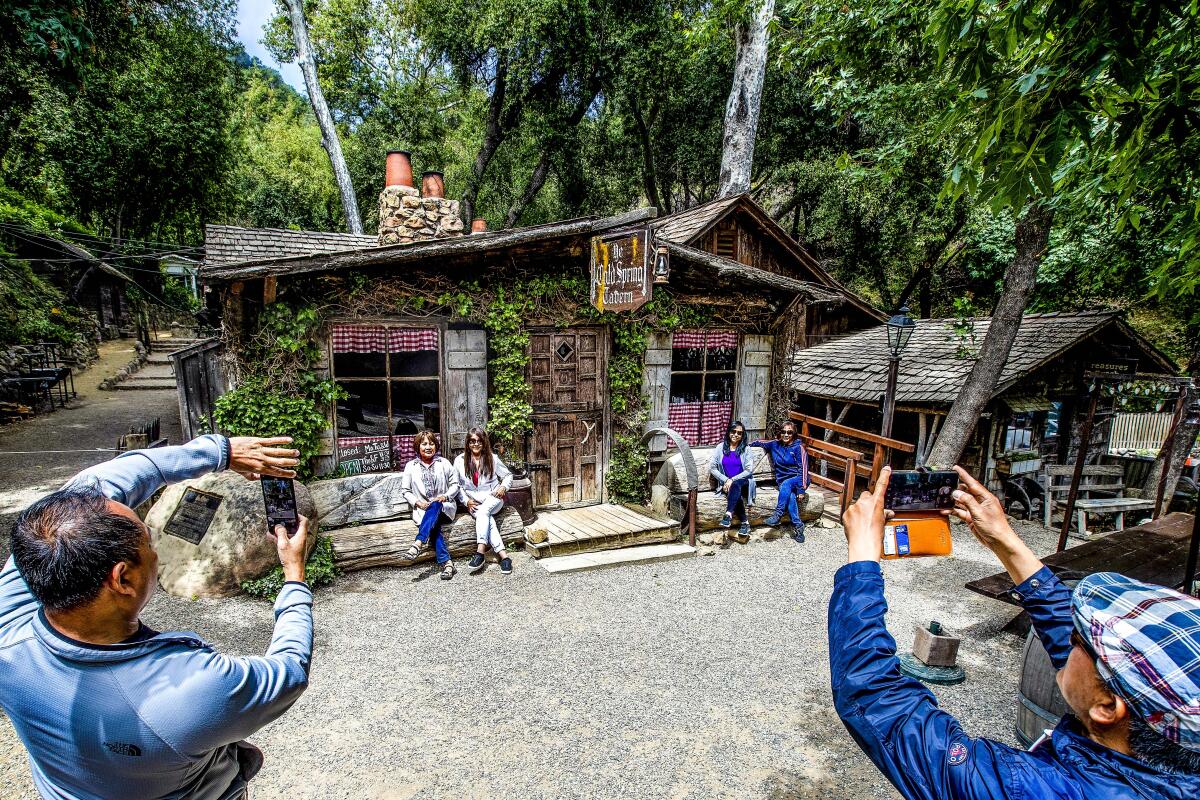
22. Spoon chili at the Cold Spring Tavern
OK, no one is making stagecoach stops at all. But still, the Cold Spring Tavern is a special spot, tucked along the roadside on San Marcos Pass above Santa Barbara, where it has been uniting bikers and dressed-down upper-crusters for decades. Built in the 1880s, it’s heated in part by four stone fireplaces. Lunch options include three distinct flavors of chili, all time-tested (and yes, you can order a sampler).
The fanciest part of the property is its dimly lit restaurant interior, where venison and rabbit often turn up on the menu and dinner is served on Fridays and Saturdays (reservations required). The tavern’s Log Cabin Bar, a rustic indoor-outdoor operation, features live music and tri-tip sandwiches on Saturday and Sunday afternoons.
Bonus tip: Acoustic blues specialists Tom Ball and Kenny Sultan, who have the Sunday music slot most weeks, have been playing the Cold Spring for more than three decades.
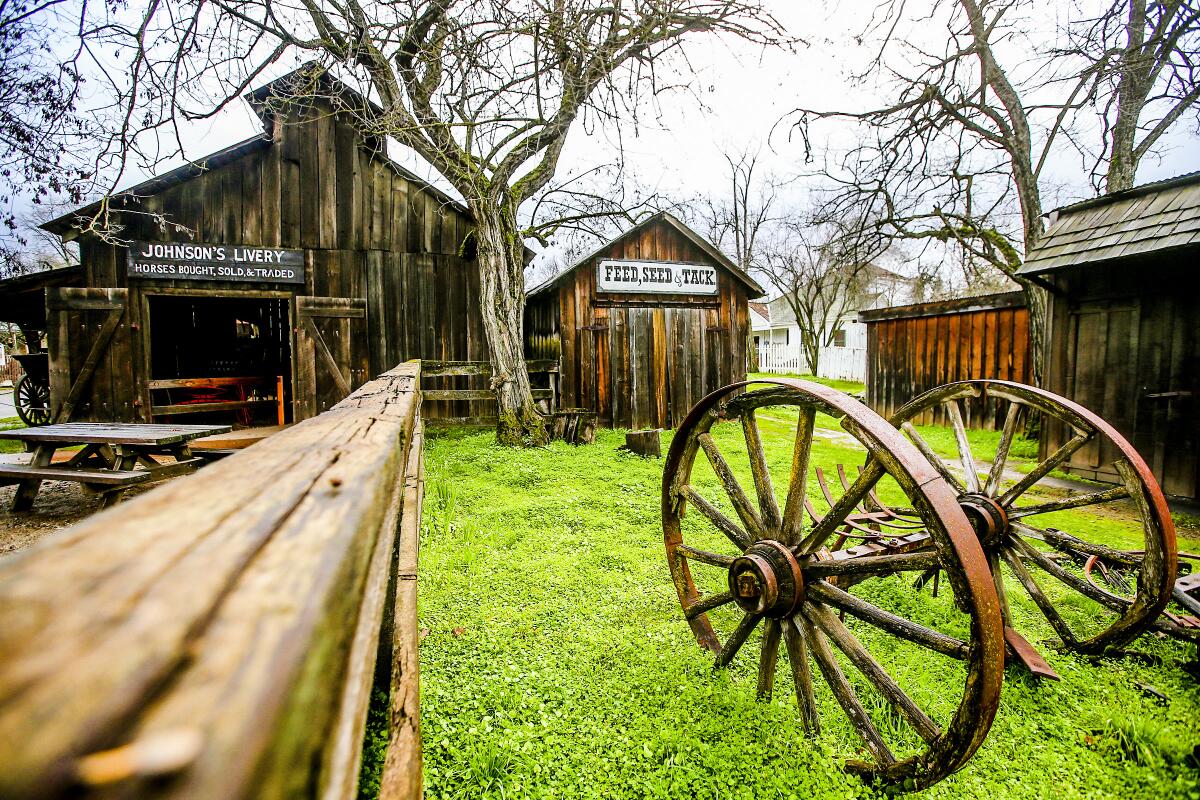
23. Chase the gold rush in a town time forgot
Bonus tip: The towns of Murphys and Angels Camp — both of which claim visits by Mark Twain when he was still Samuel Clemens — are each within 15 miles of Columbia. Murphys is a lively wine-country village whose main street has a hotel dating to the 1850s. Angels Camp is where Clemens/Twain heard a story in a bar that he spun into “The Celebrated Jumping Frog of Calaveras County,” his first literary success as a writer.
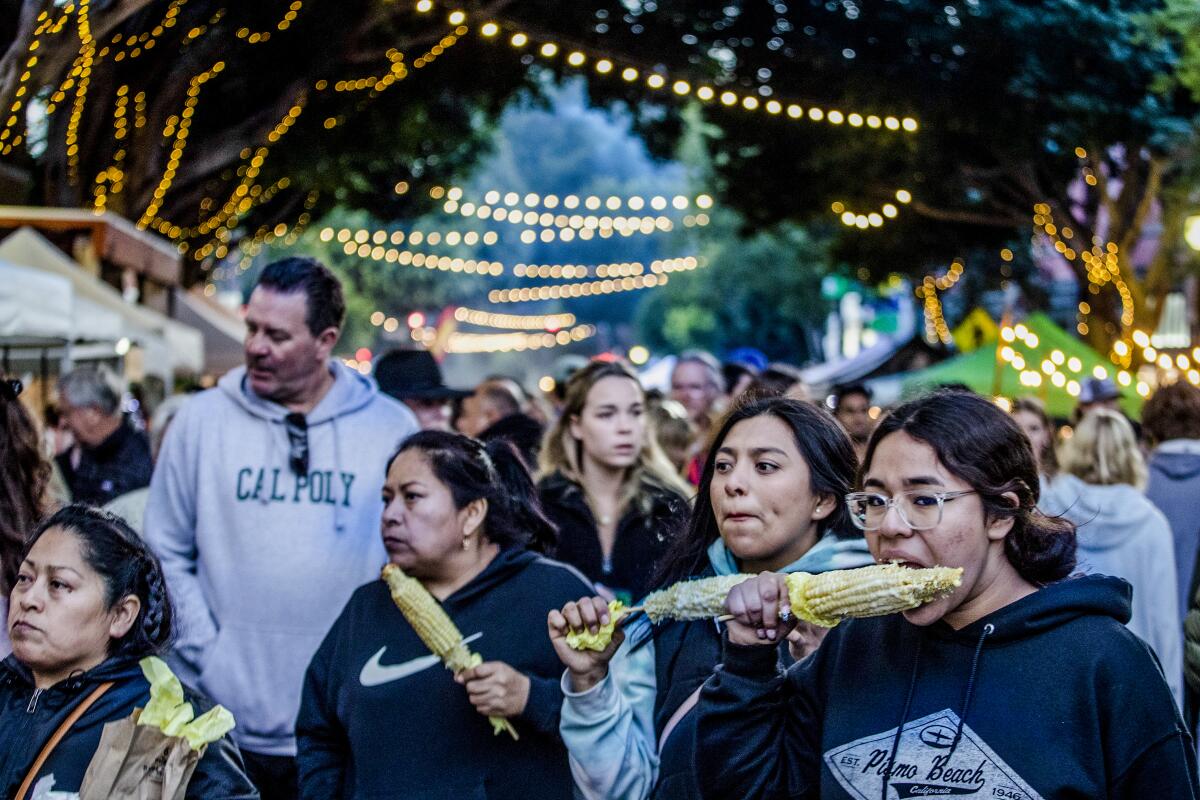
24. Nibble and sip at SLO’s farmers market
At full strength, the market fills five blocks with close to 100 vendors, including produce, street food, assorted artisans and live music. You can get ribs here, and pulled pork, corn on the cob, kombucha, soap, tamales, home loans (yes, a lender has a booth) and that particular Central California secular sacrament (a crescent-shaped bit of beef, grilled over red oak) that we call tri-tip. Bring the family (but not your dog). And be reassured: The lines may be long for barbecue from F. McLintocks Saloon and cold-brew boba tea from Sequel Cold Brew Tea, but they move fast.
Bonus tip: This market isn’t on campus but Cal Poly students are a key part of it, making up an estimated 60% or more of the workers and a large chunk of the browsers. For even more proof that they’re a big constituency here, have a look, and maybe a selfie, at downtown’s Bubblegum Alley (it’s just what it sounds like) between Garden and Broad streets along Higuera.
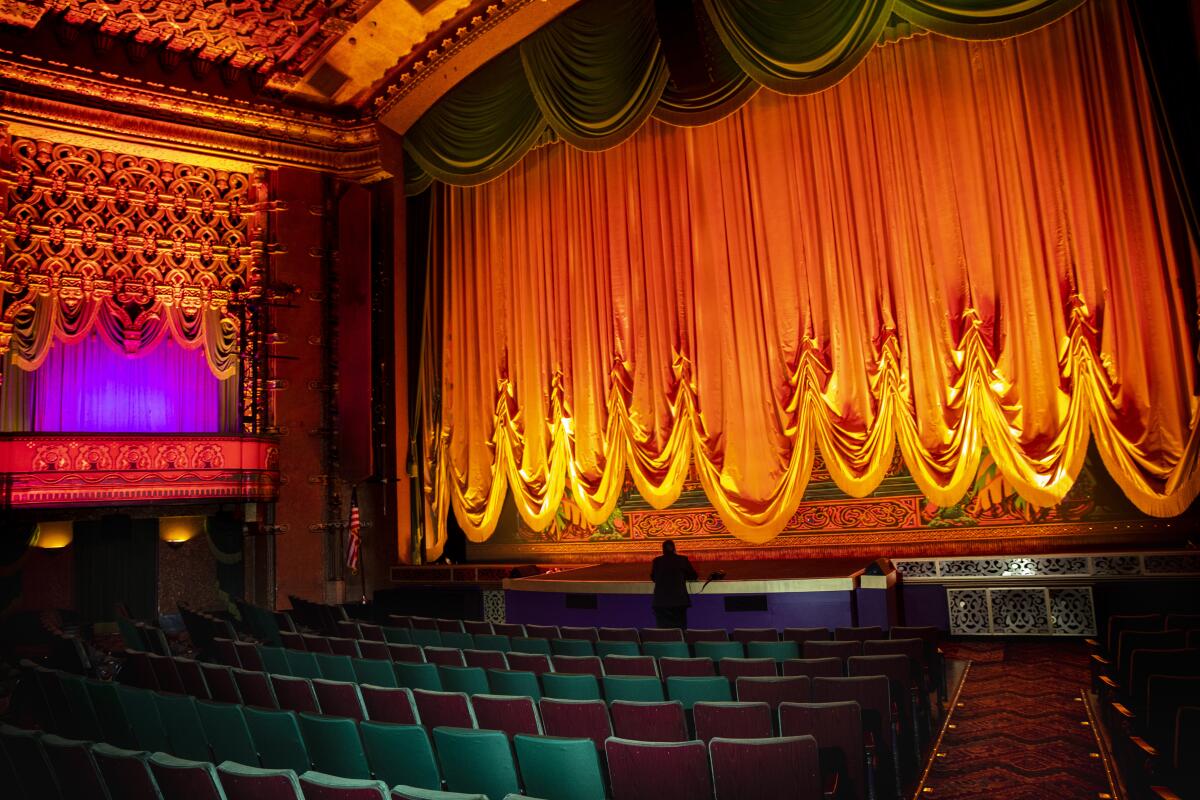
25. Connect your kid to Hollywood at Disney’s El Capitan Theatre
Just across the street are the TCL Chinese Theatre (formerly known as Grauman’s); the Dolby Theatre (home to the Oscars); and the mall at Hollywood & Highland (now being rebranded as Ovation Hollywood). Underfoot you’ll find stars from the Hollywood Walk of Fame.
See the Hollywood Roosevelt hotel about a block to the west? That’s where the first Academy Awards ceremony was held in 1929. Leading upstairs from the lobby is a tiled staircase where Shirley Temple tap-danced with Bill “Bojangles” Robinson in “The Little Colonel” (1935).
Bonus tip: If you want to strike a blow against misery on the boulevard, local efforts include My Friend’s Place, which serves homeless youths, and the Hollywood Sunset Free Clinic.

26. Stand high above Lake Tahoe’s Emerald Bay
Whatever the season, the views from Emerald Bay Overlook, the rocks next to the main parking lot and Eagle Falls Vista Point (all on the slopes above the bay) are wrap-around wonderlands of lake and forest, with tiny Fannette Island and its stone teahouse ruins completing the scene. It’s one of my two favorite views on the lake (the other is the stony shallows of Sand Harbor Beach on the North Shore’s Nevada side). In warmer months there’s camping. Closer to the water’s edge (at the end of a fairly steep one-mile trail) is Vikingsholm Castle, a Scandinavian-style mansion from the 1920s. There also are kayaking options. And if neither the lake, mountains nor mansion does it for you, my condolences. Maybe it’s time to play the slots in Stateline, 14 miles east across the Nevada border.
Bonus tip: It’s a 72-mile drive around the lake — highly recommended. For a bite or drink (or an overnight) on the western shore, try Sunnyside Lodge, 17 miles north of Emerald Bay.
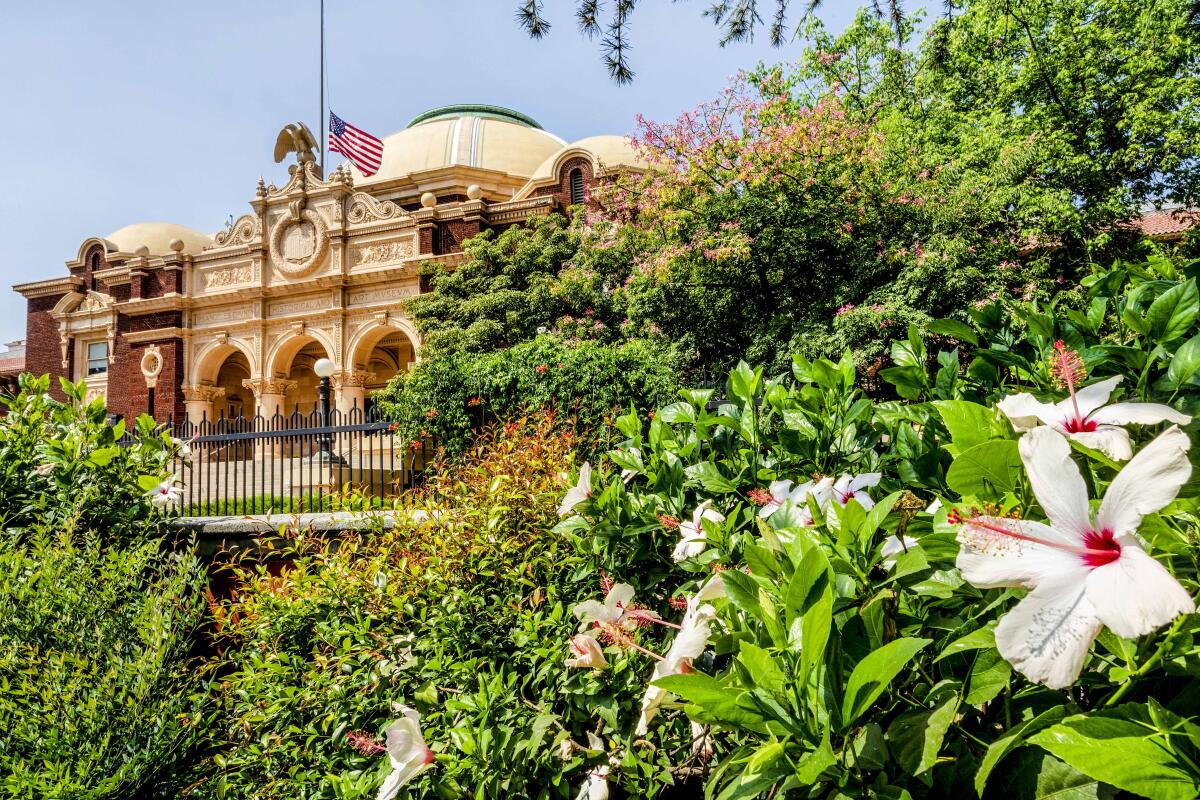
27. Smell roses, inspect insects and enjoy Endeavour at Exposition Park
Oh, and there’s sport here too: The Los Angeles Memorial Coliseum is the only venue anywhere to host two Summer Olympics (1932 and 1984) and Banc of California Stadium is the site of L.A. Football Club soccer and many a pop concert.
Bonus tip: More than 300 Kobe Bryant murals have sprung up throughout Southern California since the 2020 helicopter crash that killed him and his daughter Gianna. Check out this mural map and you’ll find that Exposition Park is surrounded by them.
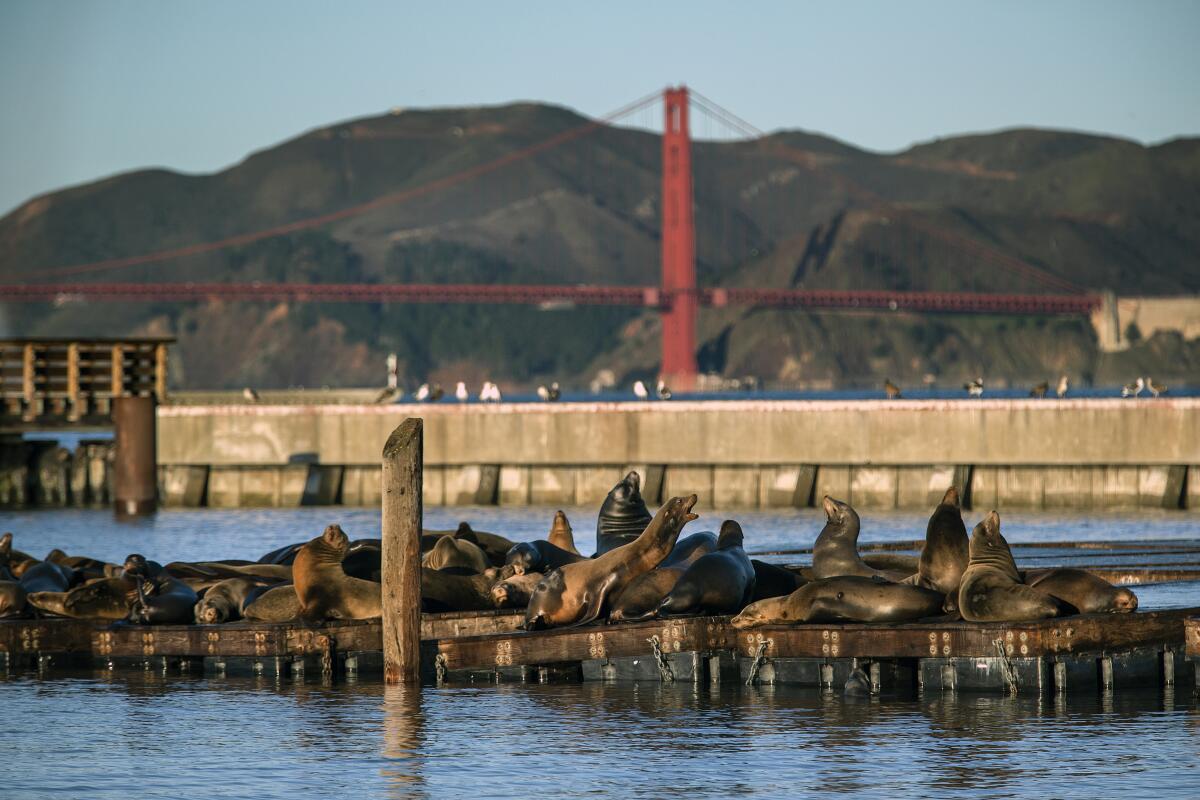
28. Cover the Ferry Building and waterfront in San Francisco
Bonus tip: If you rent a bike at Blazing Saddles, Sports Basement or San Francisco Bike Rentals ($25-$75 daily), you can pedal to Golden Gate views at Crissy Field, the Warming Hut and Fort Point. Many visitors ride across the bridge to Sausalito (1.7 miles) and catch a ferry back, but I prefer the bike ride to Fort Point and back: no cars roaring past, less wind and more pleasant places to stop.
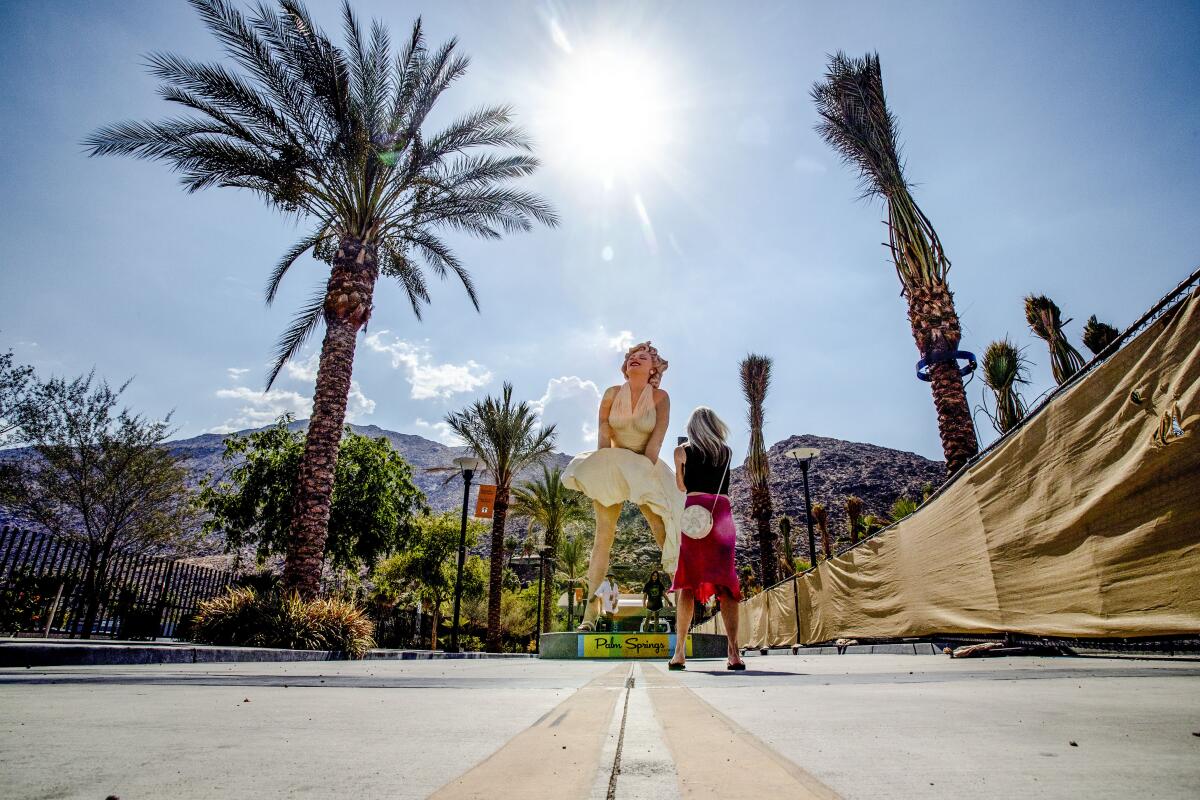
29. Spot Marilyn mooning the Palm Springs Art Museum
If you’re not so fond of this work by Seward Johnson, get in line behind Los Angeles Times art critic Christopher Knight, who calls it “adolescent sculptural trash.” Or stride ride past Marilyn to the Palm Springs Art Museum (open Thursday through Sunday), which has placed a few outdoor works of its own. One of them (also selfie fodder) is a 1968 Chevy Malibu balanced on its nose above a reflecting pool. (It’s called “History of Suspended Time (A monument for the impossible),” by Gonzalo Lebrija.)
Bonus tip: The Palm Springs Art Museum also has a 4-acre Faye Sarkowsky Sculpture Garden in Palm Desert and an Architecture and Design Center, headquartered in a converted 1961 bank building on South Palm Canyon Drive. The design center store is in the old vault.
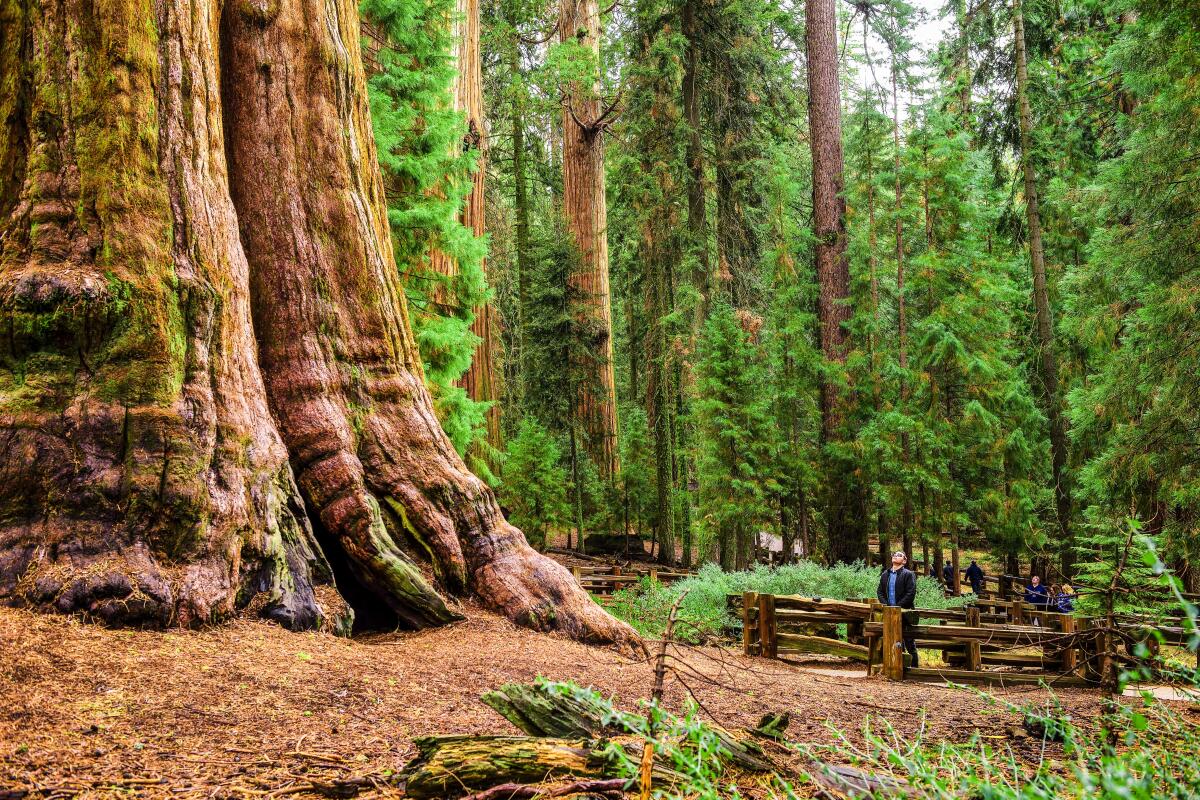
30. Salute General Sherman and Sequoia’s other big trees
The awe is simple. This is an epic living thing, about 2,200 years old. The frustration is because its stature resists capture. And the relief is because it lives at all.
Sequioa and Kings Canyon parks have been menaced by six major fires in the last seven years, including the KNP Complex fire and Windy fire, both sparked by lightning in September. On the way in, you’ll see thousands of blackened trees, interspersed with early regrowth. And you may remember that firefighters wrapped Gen. Sherman in fire-resistant material that looked like aluminum foil.
To reach the general, head north via highways 99 and 65, pass the gateway town of Three Rivers, then enter Sequoia National Park and follow Generals Highway (weather permitting) to the Giant Forest. Take your selfie. Then spend time on the nearby Big Trees or Moro Rock trails, which usually have a better trees-to-people ratio.
Back in the car, if you stay on Generals Highway bearing north, it will take you deeper into fire-damaged areas (beginning just north of the still-closed Lodgepole Visitor Center) and eventually deliver you to the Grant Grove area of Kings Canyon National Park, another haven of surviving sequoias. (The highway opened for the season on March 18.)
Bonus tip: In Three Rivers, you can get a good burger at Buckaroo Diner, a cold beer at the Gateway Restaurant or a rustic room or cabin at the Buckeye Tree Lodge.
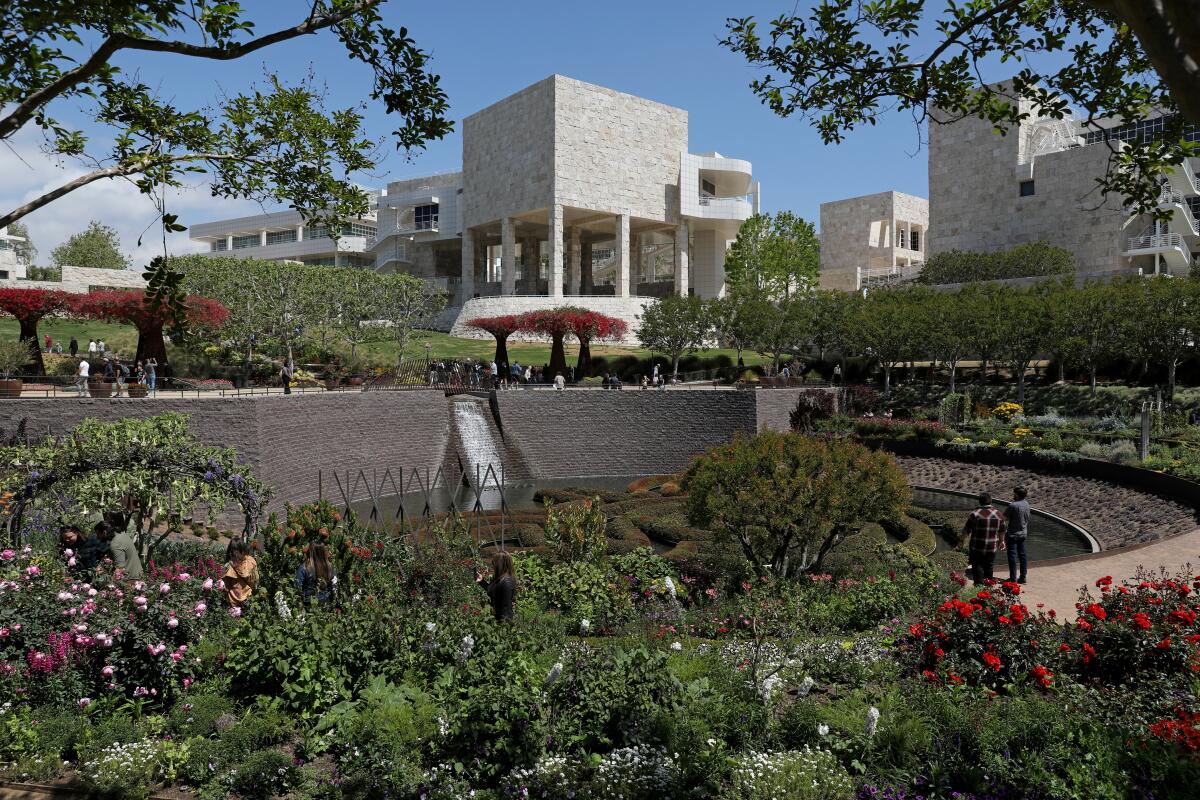
31. Ascend to the Getty
Even by Los Angeles standards, the Getty Center in Brentwood is a young landmark (completed in 1997). But this 110-acre hilltop museum campus of bright, spare buildings is backed by a $9.2-billion endowment. And it gives us access to Van Gogh’s “Irises,” Cézanne’s “Still Life With Apples” and David Hockney’s “Pearblossom Highway” photocollage, along with thousands of other paintings and sculptures, a renowned photography collection, a boldly modern garden and a set of fairly spectacular views toward the Pacific.
Admission is free but parking is $20, and you must reserve a timed-entry spot. (It’s closed on Mondays.) Take the tram up the hill and head for the West Pavilion, which houses photography and Impressionists. Check out the cactus garden, which seems to float in the sky. And spare a few minutes to read up on the strange life of the notoriously tight-fisted oilman who endowed this place even though he left California in 1951 and never returned.
Bonus tip: If antiquities are more your style, spend a day at the Getty Villa in Pacific Palisades, which specializes in ancient Greek, Roman and Etruscan art and is closed Tuesdays.
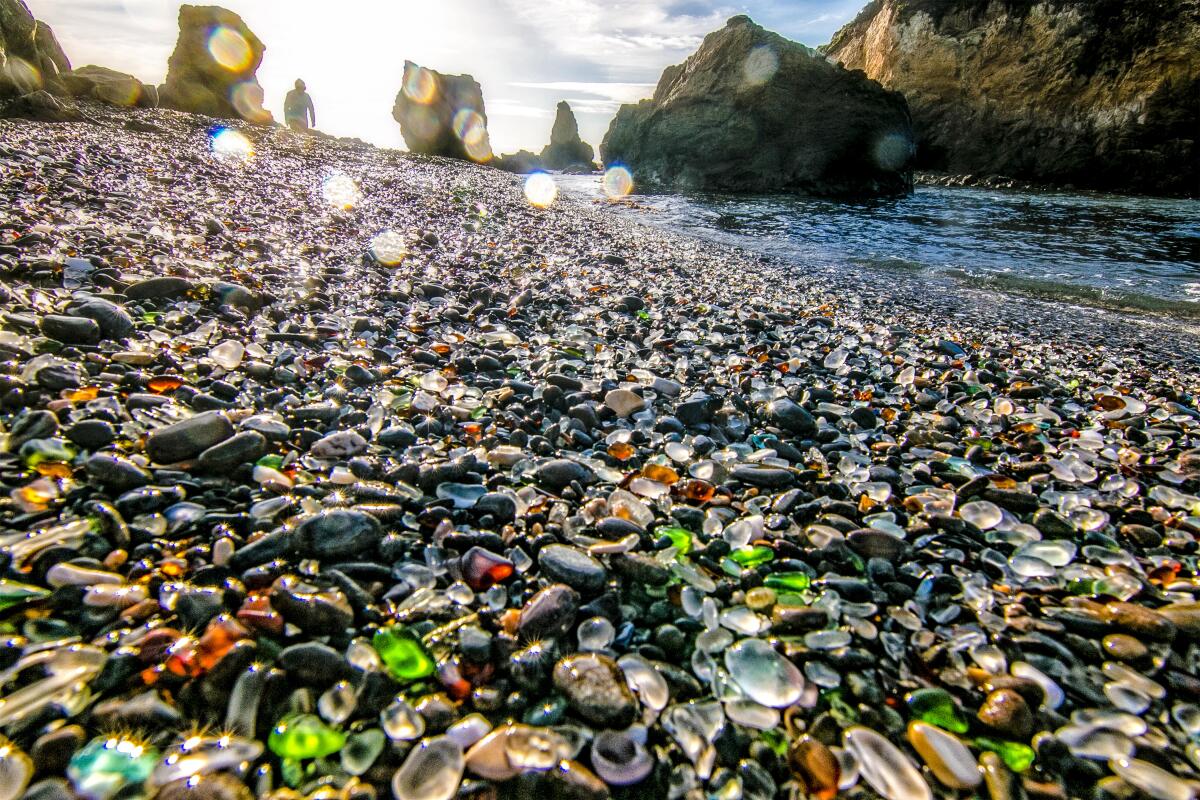
32. Trace the line between junk and nature at Glass Beach
Families comb the shore and snap photos. It’s a lesson in planetary healing. And it’s a catch-and-release situation: Parks officials forbid visitors from carrying away a natural resource. The best-known Glass Beach is at the west end of West Elm Street. Others are slightly north in MacKerricher State Park.
Bonus tip: Speaking of gems in the rough, the city’s Noyo Harbor has some new energy lately. For an upscale overnight, try the Noyo Harbor Inn, built in the 1860s, reopened in 2017 after a big rehab. For fresh food on the water, try the Noyo River Grill (opened in 2018) or the neighboring Princess Seafood restaurant (Friday-Monday lunch, opened in 2021). The Princess menu features sablefish and Dungeness crab caught by an all-woman crew on a 42-foot boat whose name is ... Princess. Live music on weekends, too.
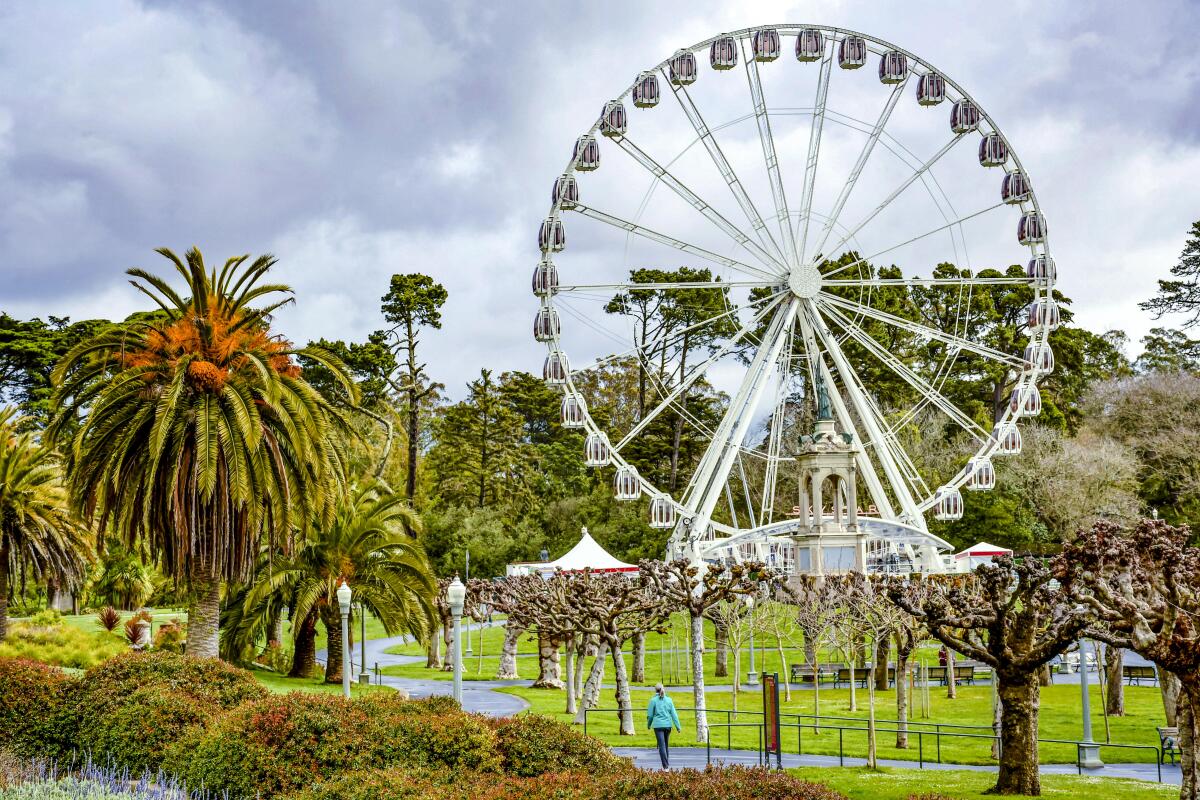
33. Hover over Golden Gate Park in a semi-secret museum tower
But the bold, angular de Young building also has something else: Upstairs at the east end of the building, you’ll find its 144-foot-high Hamon Observation tower with glass walls and staggering wraparound views. Though adult admission to the museum is $15, you can head up to the tower for nothing. (The museum is closed on Mondays, though.)
Then head out again and go look for the bison paddock and the golf course. Or just wander the park’s network of paths and car-free roads among all the other walkers, runners, skaters, cyclists and Segway riders.
Bonus tip: It’s hard to imagine the green park expanse as sand dunes, but that was the lay of the land when park construction began in the 1870s. Look closely at many rocks and you’ll realize they’re colored concrete, placed at the direction of pioneering park superintendent John McLaren, who also devised fake lakes and fake waterfalls.
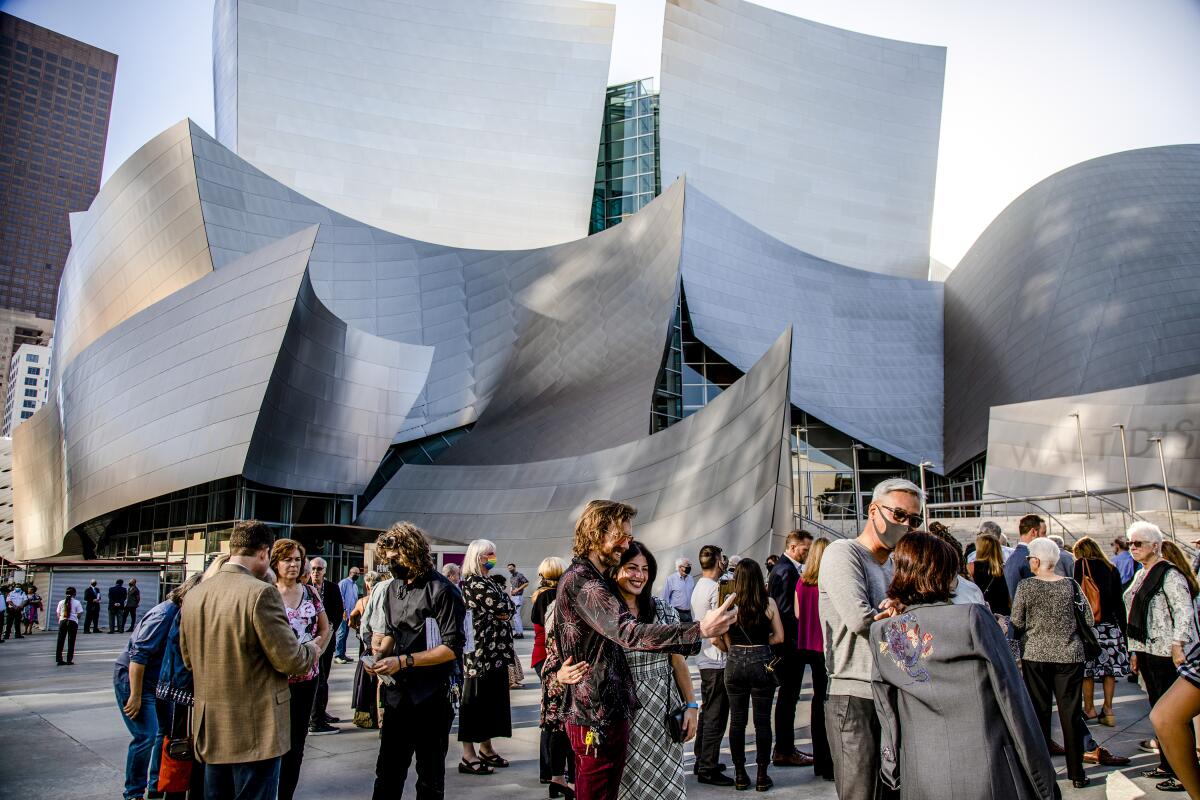
34. Savor the arts on Grand Avenue in DTLA
There are so many more arts organizations close at hand, including the Music Center and Center Theatre Group, the Museum of Contemporary Art and the Colburn School (for performing arts), you could easily spend three days and nights exploring this territory. And now there’s something else. Across the street from Disney Hall, a pair of mixed-used skyscrapers known as the Grand L.A. (also designed by Gehry, but more angular) will open in coming weeks and months with apartments, retail, restaurants and a swanky hotel, the 28-story Conrad Los Angeles (which is taking bookings for stays beginning June 1). If the idea of parking in this ever-denser district alarms you (as it does me), take a Metro train to the Civic Center/Grand Park station at South Hill and West 1st streets.
Bonus tip: Don’t forget the green bit. Between jolts of culture, recharge at Grand Park, a 12-acre rectangle of grass and foliage (and a playground) that flows from Grand Avenue down Bunker Hill to Spring Street. There’s a fountain and Starbucks near the top, City Hall at the bottom.
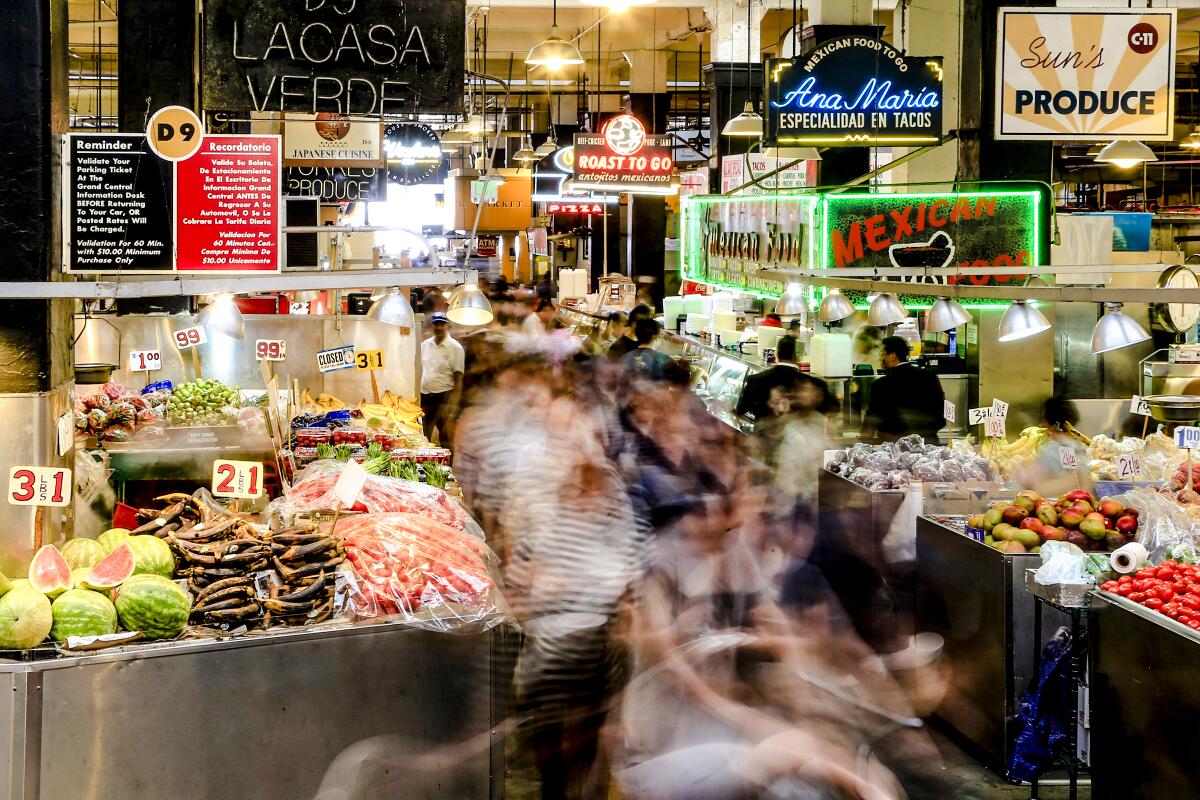
35. Nosh and schmooze at Grand Central Market
Bonus tip: Across Hill Street, you’ll find the Angels Flight Railway, a funicular that dates to 1901. Its two orange cars charge $1 for a short, steep ride (298 feet) to California Plaza atop Bunker Hill.
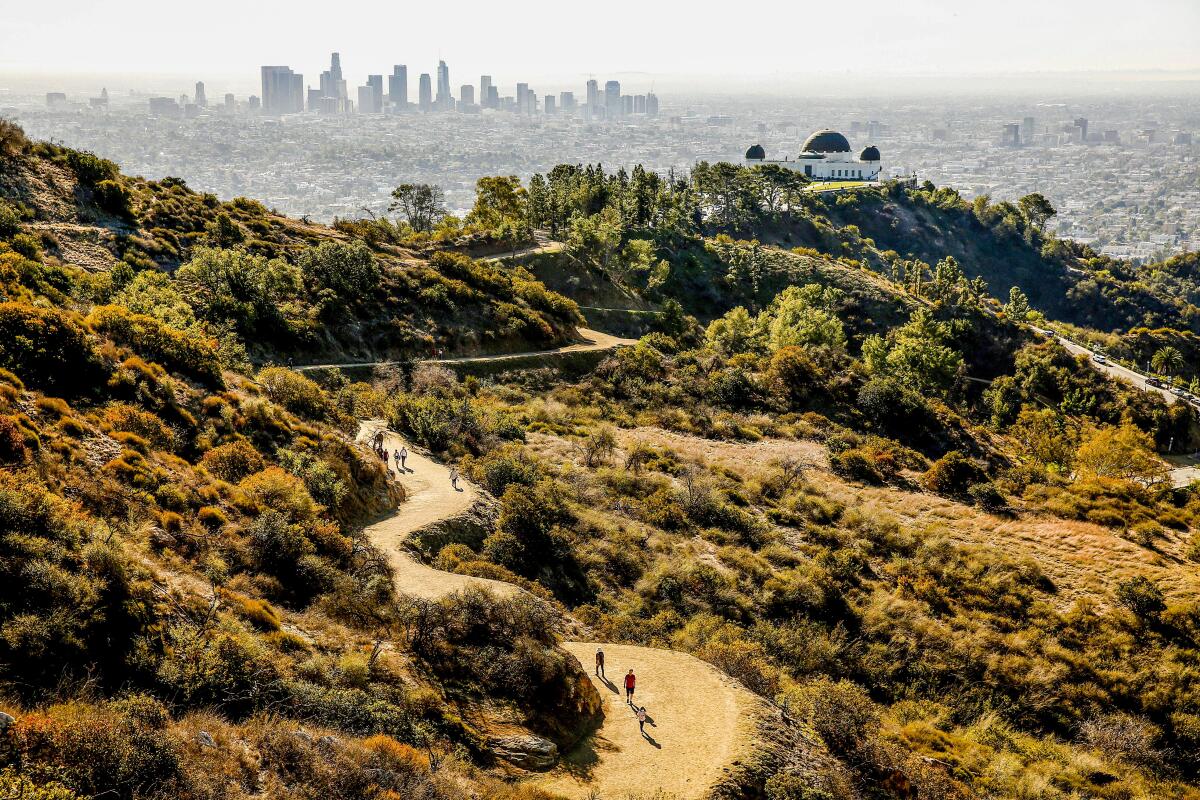
36. Spy sun, moon and stars at Griffith Observatory
Since 1935, Angelenos have embraced Griffith Observatory as “the hood ornament of Los Angeles,” in the words of observatory director E.C. Krupp. It’s the architectural star of 4,210-acre Griffith Park, with three green copper domes, a startling amount of subterranean space (thanks to a major expansion completed in 2006) and parking — well, the parking isn’t pretty. The lot fills fast, as does nearby curbside parking (metered at $4 hourly). You might want to catch a DASH bus from the Greek Theater or the Metro station at Sunset and Vermont. Or hike up from the Greek Theatre parking lot.
Bonus tip: Hike from the observatory’s Charlie Turner Trailhead to the Tom LaBonge Panorama atop Mt. Hollywood, a roughly 2.6-mile round-trip journey with big views of the Hollywood Hills and San Fernando Valley. And be sure to read up on the philanthropist-felon who made all this possible, Griffith J. Griffith.
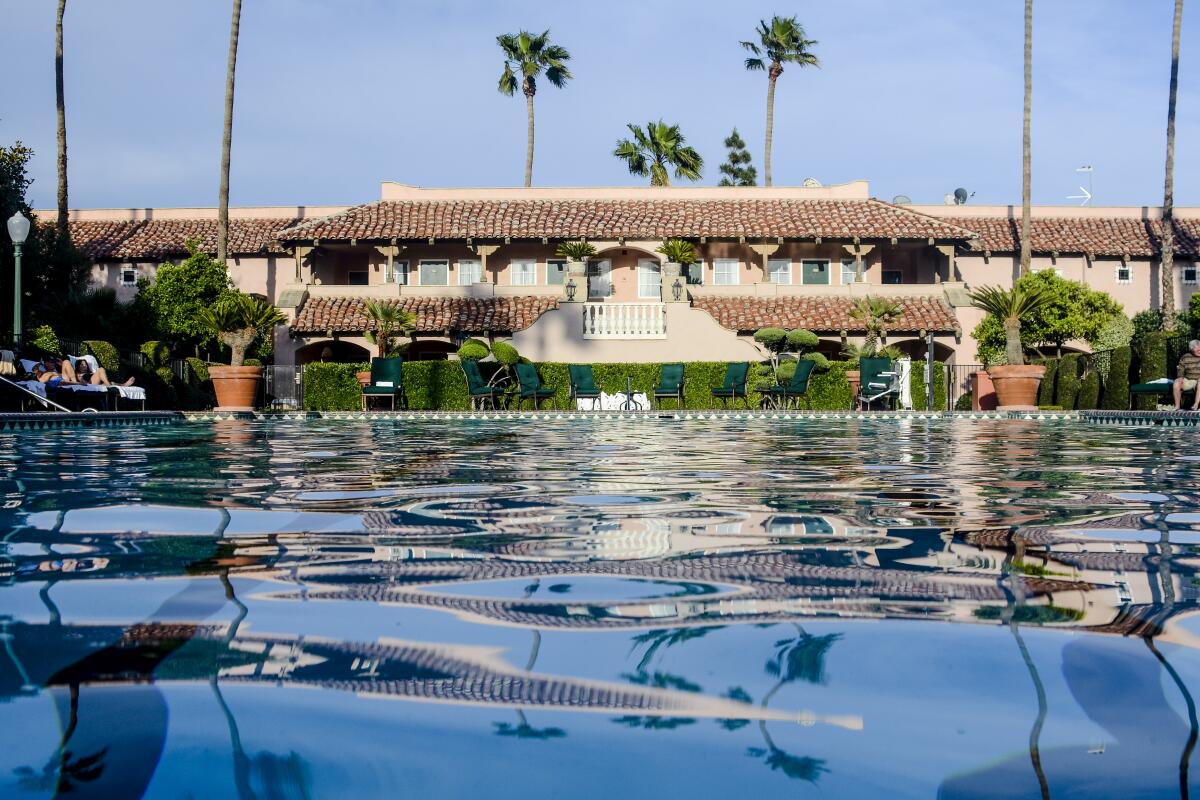
37. Refuel (or dodge taxes) at Harris Ranch
Thus Harris Ranch, which is neither scenic nor historic and stands in Coalinga, has become indispensable to California travel. The ranch dates to the 1930s but didn’t become relevant to travelers until 1977. That’s when the Harrises, already busy with cattle and crops, opened a burger stand to serve Central Valley drivers on the just-completed Interstate 5.
Then the burger stand became a steakhouse. And hotel. Now, though they sold their beef operation in 2018, the Harris people have a diversified roadside citadel. Its Ranch Kitchen, Prime Steakhouse and Horseshoe Lounge seat more than 450 people. There’s a bakery and a boutique. The hotel has 153 rooms and an Olympic-style pool. The gas station is neighbored by Harris Ranch Express BBQ.
Full disclosure: You may catch a whiff of the neighboring feedyards. (In fact, author Michael Pollan says the ranch led him to change the way he eats.) Still, if you find yourself hungry or sleepy or desperate for a clean bathroom between San Francisco and Los Angeles, this place may be your refuge.
Bonus tip: Fresno County is one of the few California jurisdictions that charge no hotel room tax, and Harris Ranch Inn charges none of the half-hidden resort fees increasingly common at vacation hotels. As a result, a $169 room at the Harris Ranch Inn front desk will actually cost you $169. Breathtaking.
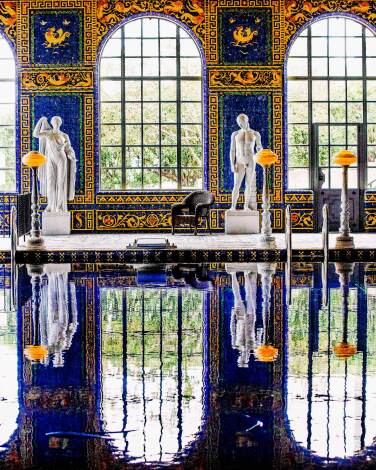
38. Count rooms and whisper ‘Rosebud’ at Hearst Castle
There are 165 rooms in Hearst Castle, which was designed by Julia Morgan according to the whims of newspaper magnate William Randolph Hearst (who died in 1951). Now owned and operated by the state park system, the castle closed in 2020 because of the pandemic, then suffered storm damage to the road between the visitor center and the castle. Repairs kept the castle closed until just this month.
Returning visitors will find the castle is still surrounded by three guest houses, one elaborate tiled indoor pool, another pool outdoors, all on 127 hilltop acres of gardens and grounds and the occasional roaming zebra.
The rooms are festooned with hundreds of artworks and artifacts Hearst collected abroad. And if this all seems vaguely familiar, it’s because writer-director-actor Orson Welles was thinking about Hearst when he made the 1941 movie “Citizen Kane.”
Five different public tours are offered (some wheelchair-accessible, some not), plus evening tours in spring and fall. Tickets start at $30 per adult, $15 for children ages 5 to 12.
Bonus tip: If you’re not spending the night in Cambria, as many travelers do, the Cavalier Oceanfront Resort, fronting the ocean in San Simeon, is a good option.
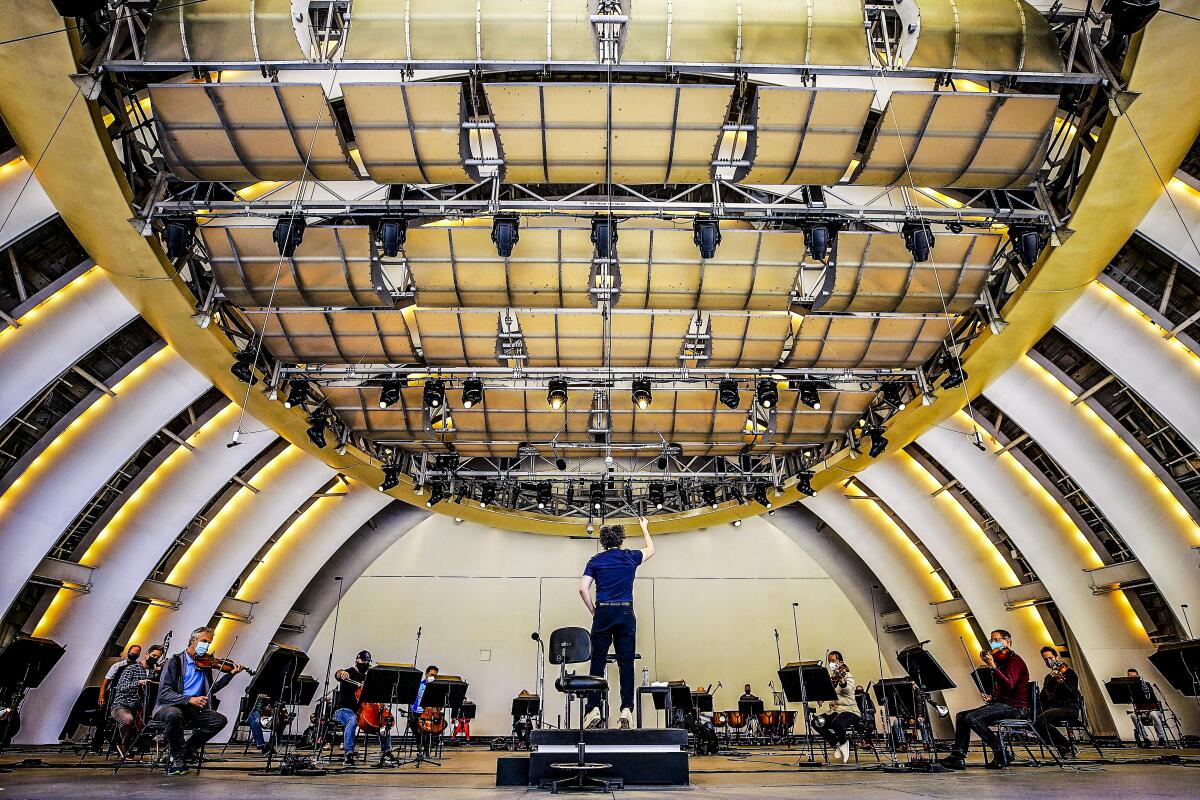
40. Pack a picnic for the Hollywood Bowl
Or maybe it’s just the picnics. Most venues would scream bloody murder if you tried this, but at the county-owned bowl, the tradition is that you’re allowed to bring your own food into most shows. If the Phil is playing, you can bring wine and beer. Note that bringing in alcohol is forbidden at some shows.
Aaron Copland, Deep Purple, Igor Stravinsky, Ella Fitzgerald and the Beatles have played here. There’s a jazz festival and a mariachi festival every summer and around July 4 there are a few fireworks shows (this year featuring Steve Martin and Martin Short). The 2022 “Sound of Music” sing-along will be Sept. 17.
The venue holds about 18,000 and parking is as messy as you’d suspect. (Try to get dropped off at Lot B or use a shuttle bus.)
And speaking of beloved traditions: Some morning rehearsals at the bowl are open to the public, typically on summer Tuesdays and Thursdays between 9 a.m. and 12 p.m. (seating on side benches in Section D). Rehearsals were closed because of COVID in 2021, but the hope is to open in summer 2022. For the latest information, email [email protected] or call (323) 850-2000 (the “hold” music is Holst).
Bonus tip: There are two other summer outdoor music venues in these hills: the Greek Theater (capacity: about 5,900) in Griffith Park; and the Ford Amphitheater (capacity: about 1,200) at Cahuenga Pass.
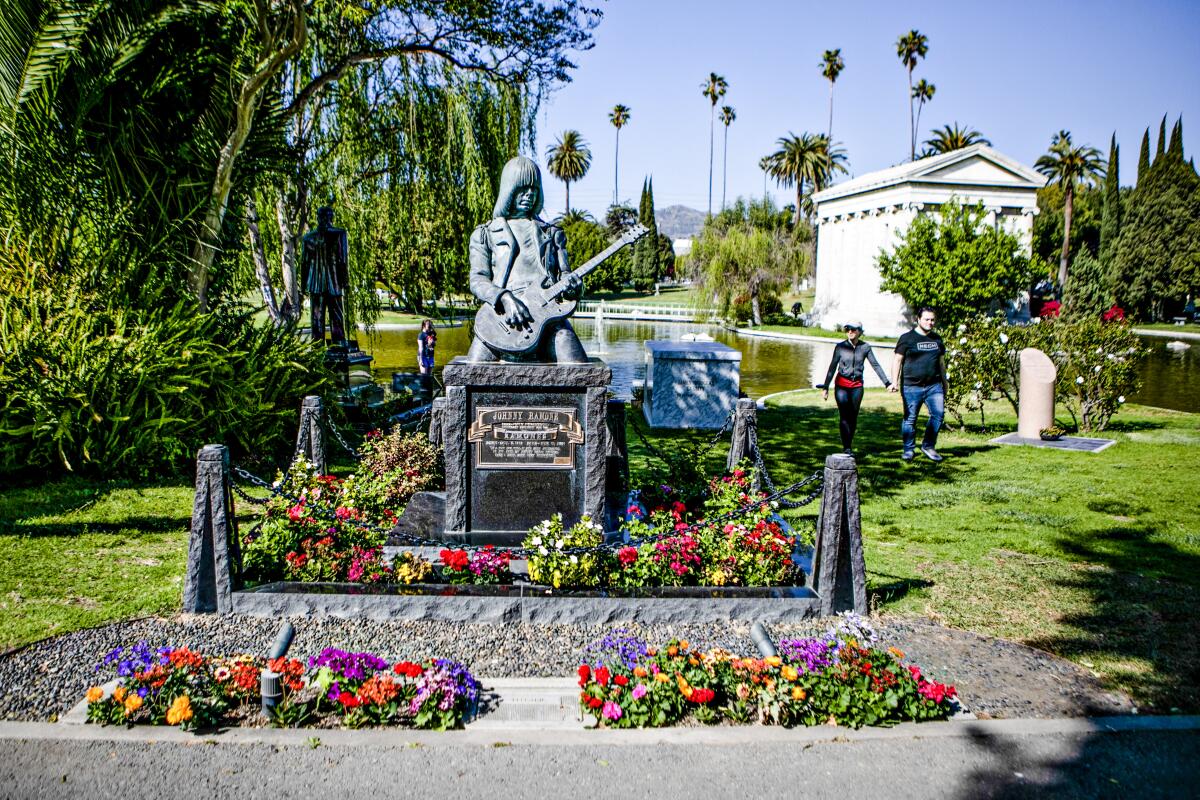
41. Stretch out below (and above) the stars at Hollywood Forever Cemetery
Devoted seekers of celebrity graves could head from here to the sprawling Forest Lawn in Glendale (where Michael Jackson and Elizabeth Taylor are) or Pierce Brothers Westwood Village Memorial Park (where Marilyn Monroe is). But for most of us, this is plenty.
Bonus tip: The cemetery’s Day of the Dead celebration, a spectacle for more than 20 years, features hordes of costumed visitors, live bands, Aztec dancers and ofrendas (altars) honoring departed loved ones. If you think Southern California lacks fall color, you’ve never seen Hollywood Forever festooned with Día de Los Muertos finery.
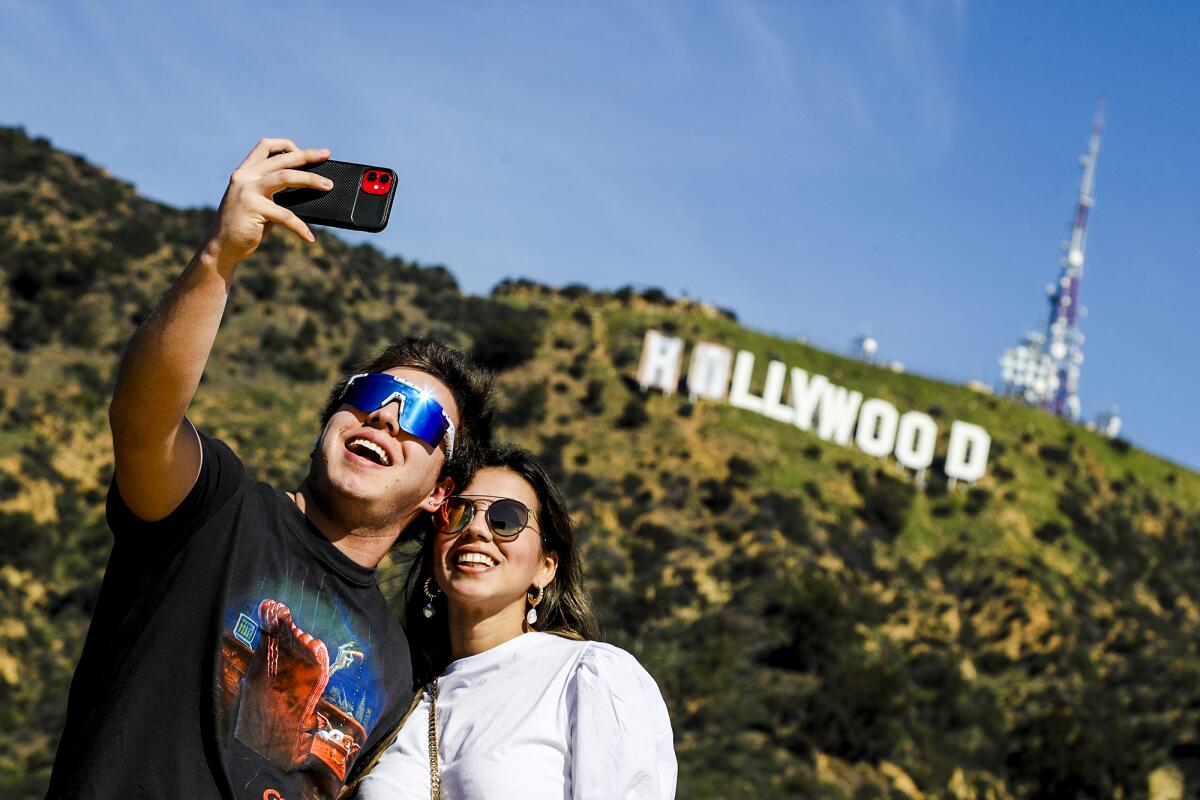
42. See the Hollywood sign in myriad ways
I recommend the down-below option: Lake Hollywood Park at 3160 Canyon Lake Drive. It’s a grassy, dog-friendly spot with a kids’ play area and plenty of room to lay out a picnic and snap a thousand selfies with those famous letters looming above to the northeast. Unlike the residential streets all around (where homeowners make repelling sign-seekers a top priority), it’s got ample parking along the curb.
Still, a lot of people want that view from above. So here are two other options: The shortest hiking route to the summit, the Burbank Peak Trail (2.8 miles round-trip), is steep and rocky and requires parking in a neighborhood where sign-seekers are scorned. The route I’d rather take is a longer, gentler, wilder, five-hour journey. You start at Griffith Observatory (the Charlie Turner Trailhead) and do an 8.8-mile round trip on wider, flatter trails with stops atop Mt. Hollywood and Mt. Lee and views of Lake Hollywood, the Los Angeles Basin and the San Fernando Valley.
Bonus tip: Like to ride? Take a two-hour, $125 evening horseback ride in the Hollywood Hills with Sunset Ranch at the north end of Beachwood Drive. (There are daytime rides too.) You won’t get all the way up to the sign, but hey, you’re on horseback in Hollywood. You’re winning.
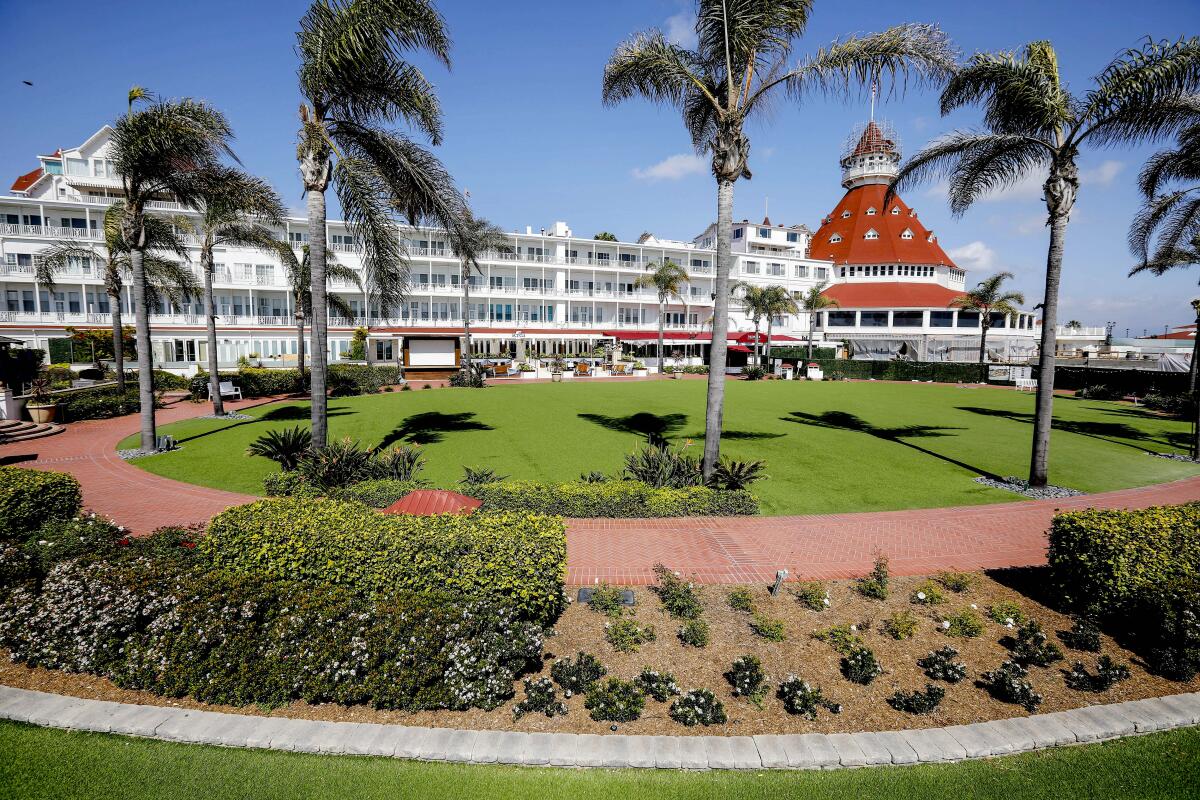
43. Wiggle your toes in the white sand at the Hotel del Coronado
So maybe you’ll just pop in for a meal, a drink or ice cream at one of the several restaurants on-site. (Or in December, you could skate on the temporary ice rink while gazing at the Pacific. That’s a pretty California thing to do.) There’s also the simplest, cheapest option: Stake out a spot on the wide, sandy beach next to the hotel — one of the kid-friendliest beaches anywhere. And if you spot a large group of really fit guys doing weird exercises along the shore, those will likely be Navy SEALs, whose training base is nearby.
Bonus tip: For more Coronado fun, head to the north end of Coronado’s B Avenue (about 1.5 miles from the Del) and browse around the Coronado Ferry Landing, which has shops and eateries. You could splurge on a meal at Il Fornaio or the even fancier Peohe’s. Or just take a 15-minute ferry ride to downtown San Diego and back, $7 each way.
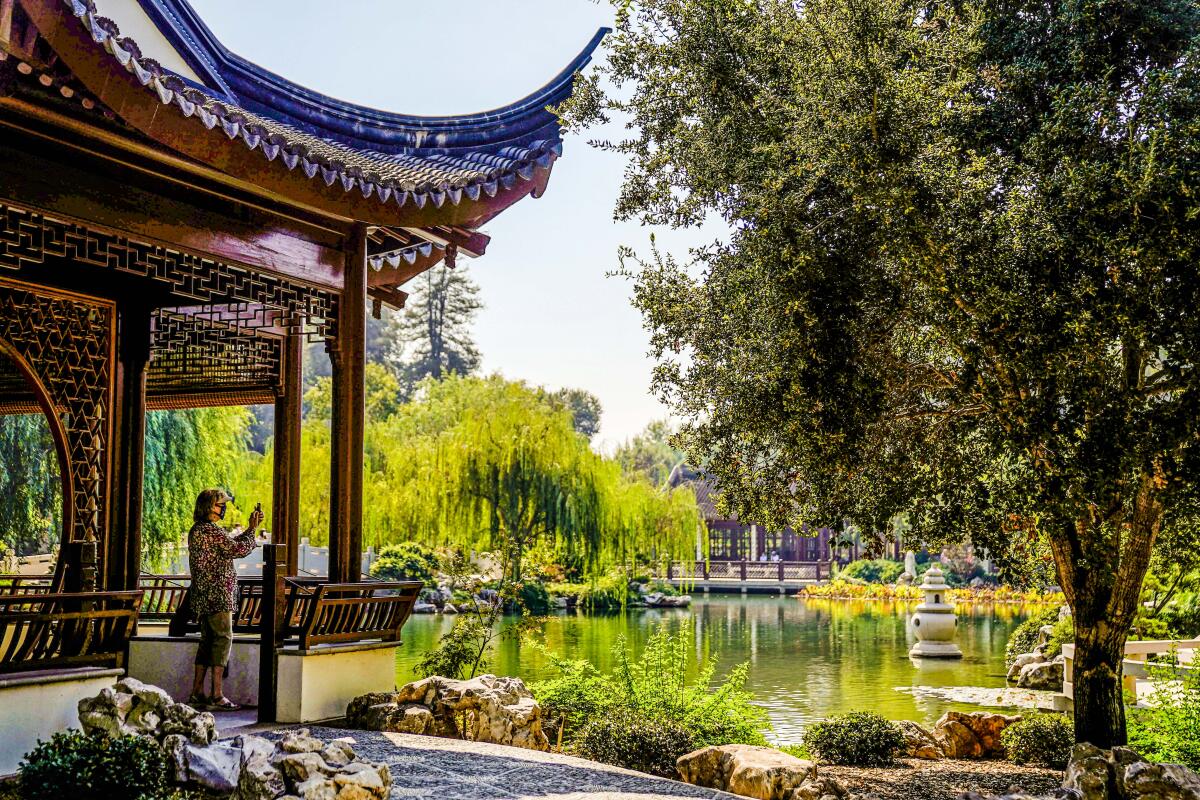
44. Surround yourself with blossoms, books and a Blue Boy at the Huntington
Meanwhile indoors, the museum and library, underwritten by a railroad fortune, have been diversifying energetically. “Blue Boy,” Thomas Gainsborough’s emblematic 18th century portrait of a rich British kid, returned in May from London’s National Gallery, and now shares a gallery with a specially commissioned “Portrait of a Young Gentleman” by American artist Kehinde Wiley (who painted Barack Obama’s presidential portrait). Some of the museum’s American galleries are closed (as is the Rose Garden Tea Room until late 2022), but the installation “Borderlands” is open, showing how artists grapple with political and personal boundaries. Adult admission is $25-$29 for nonmembers.
Also, if you’re visiting in May or June, you can enjoy a little bonus botany by hunting for blooming violet jacaranda trees on the streets near the Huntington. (Just don’t park under those trees — the sap is a nightmare.)
Bonus tip: A lot of visitors run out of steam before visiting the Huntington’s library displays, but they’re remarkable. The library holds more than 11 million items and is rapidly acquiring personal archives (recent additions include the late Eve Babitz and living Pico Iyer). Its Exhibition Hall displays include a 15th century manuscript of Chaucer’s “Canterbury Tales” and a typed draft of Octavia E. Butler’s “Parable of the Sower” (1993).

46. Roam Coachella Valley canyons under native palms
In Andreas Canyon, you follow a path along the year-round Andreas Creek, which is lined by Washingtonia filifera, the California fan palm. This is a genuine oasis, reached by an easy hike — a 1.2-mile round trip.
In Palm Canyon, a few miles away, the looping (and more demanding) 2.7-mile Victor Trail drops into a shady, boulder-strewn fold in the desert hills where more native palms congregate, then returns along a higher ridge. There’s a “trading post” gift shop at the trailhead.
Those canyons, along with Murray Canyon and Tahquitz Canyon (which has a 60-foot seasonal waterfall), are all part of the Indian Canyons network of open space managed (and named) by Agua Caliente leaders.
Bring a good map and plenty of water. Adult admission is $12; open daily Oct. 1 through July 4; on Fridays, Saturdays and Sundays in summer. No pets allowed.
Bonus tip: Keep an eye out for rattlesnakes underfoot and desert bighorn sheep on the slopes above.
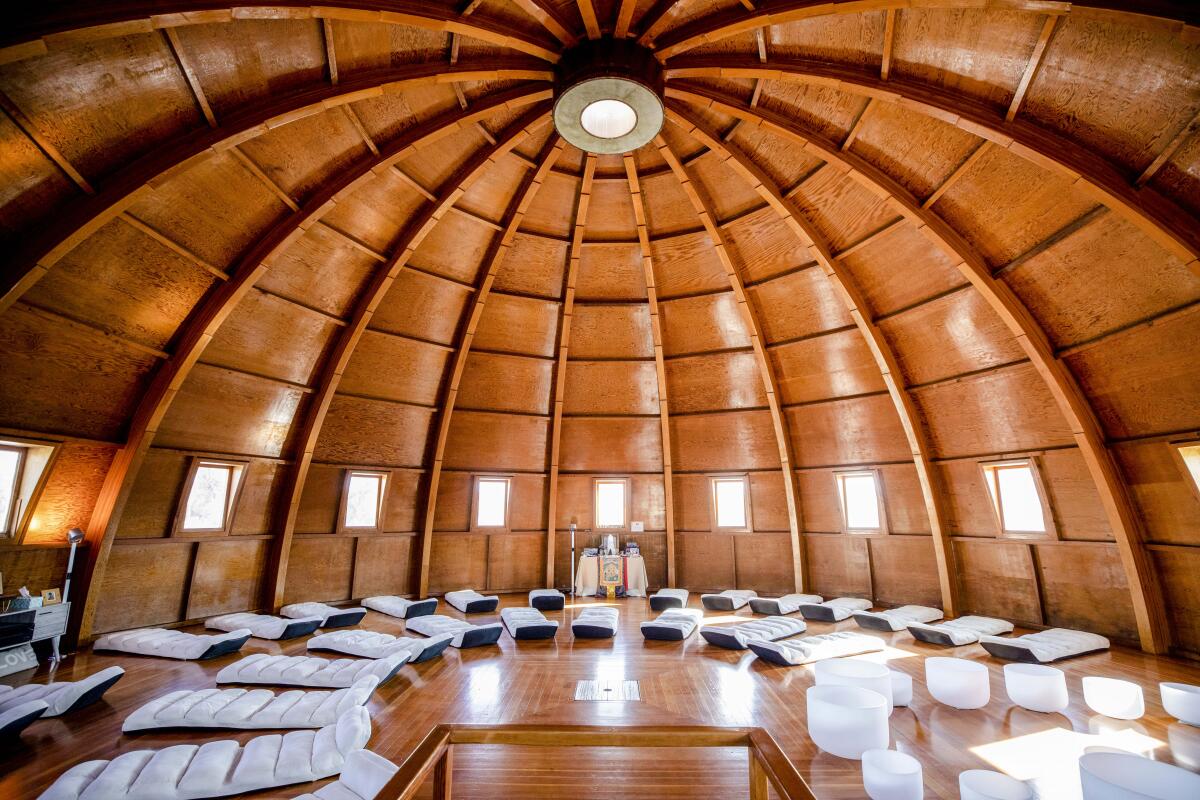
47. Bathe in sound at the Integratron
But times and ownership change. Now family-owned, the Integratron is mostly about sound baths, offered to private and public groups by appointment only. A typical group bath includes up to 28 people, lasts an hour and starts with your host telling Van Tassel’s tale. Then the mallets come out, and the host taps at 20-quartz crystal “singing bowls” that can sound like church bells, elegant feedback or a planetary dial tone.
The Integratron offers group sound baths Thursdays-Sundays at $50 per person (age 14 and older). Private sound baths are $1,300 and up.
Bonus tip: No soap, water or disrobing is involved but you do have to take off your shoes and turn off your phone.
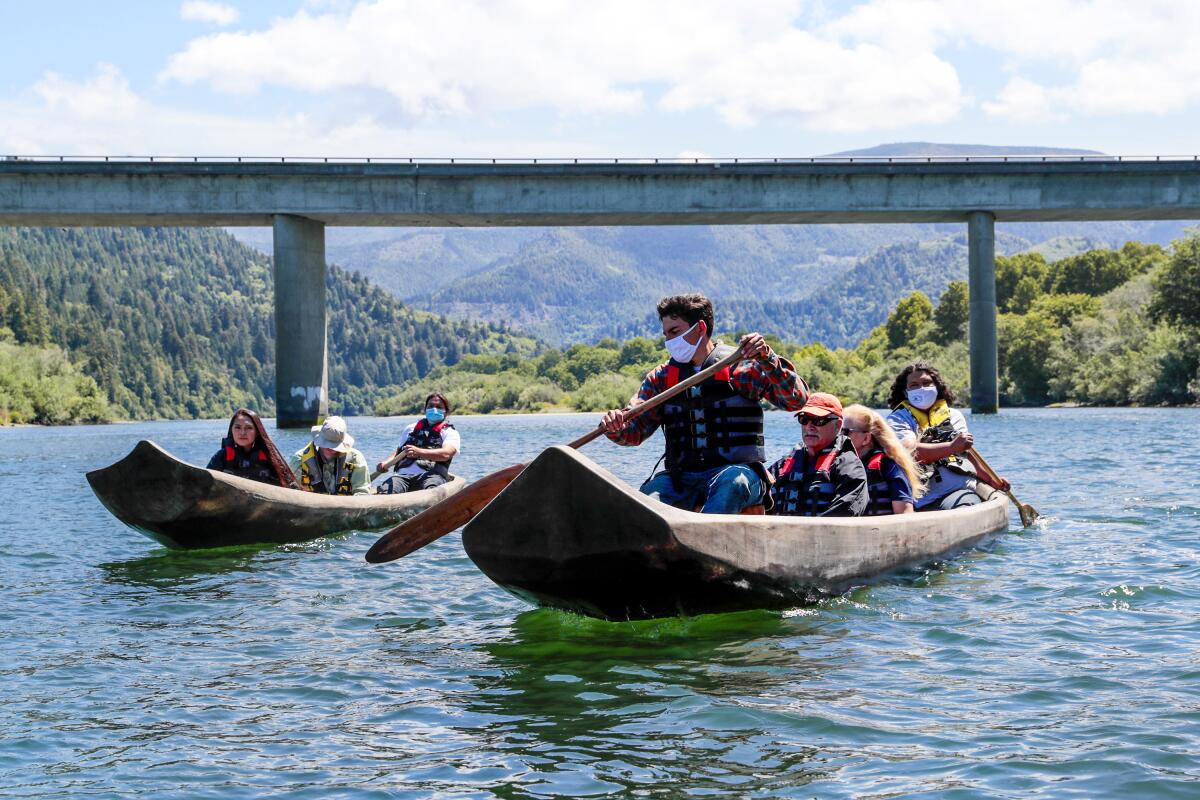
48. Paddle the Klamath in a Yurok dugout canoe
Bonus tip: Klamath River Overlook, at the end of Requa Road in Klamath, offers the region’s best view of the river from up high. From that overlook, you can hike a steep trail (a mile down and back) that takes you toward the water. After that, head for the south side of the river at the end of Klamath Beach Road. That’s Klamath Beach, where at low tide you can walk past traditional Yurok sweat houses to a sand spit where the river and sea meet, anglers cast between rock formations and seals play in the current.
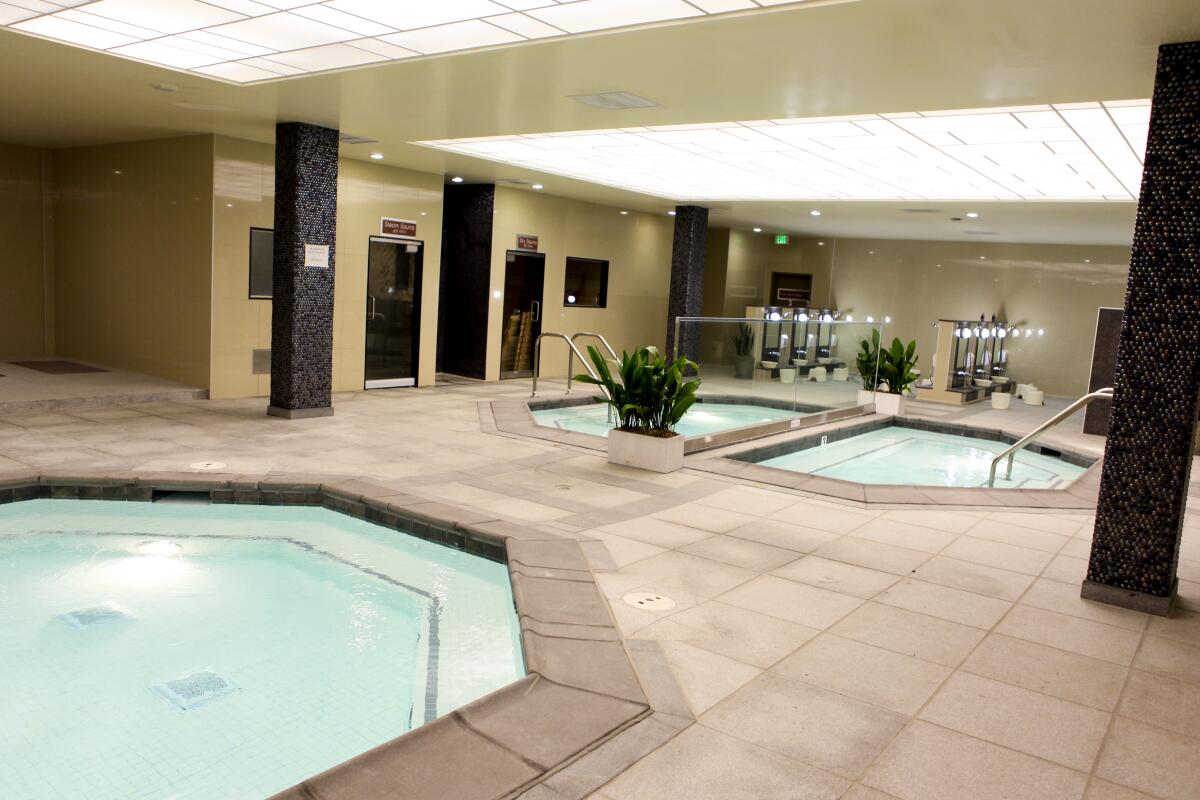
49. Sweat in a Koreatown spa
The spas in and near that neighborhood offer baths; saunas involving salt, clay, jade and ice; facials; manicures and pedicures; massages; and more. Body scrub? Sure. You’ll feel clean and tender as a piece of lumber that’s just been planed and sanded. A 30-minute session usually costs about $50.
Every spa does things its own way, but nudity in gender-segregated areas is a common feature. Co-ed and family areas are known as jimjilbang, and there’s usually a food option. The Crystal Spa (open daily, $30 a day) serves men, women and children over age 10. The Olympic Spa (closed Wednesdays) serves only women 18 and over. Aroma Spa & Sports includes yoga, aerobics, an Olympic-style swimming pool and a driving range. Wi Spa, a few blocks east of Koreatown on Wilshire, invites families and has a gym, restaurant, computer area, kid zone, an area for sleeping on the floor and a rooftop terrace with shade and misters. (It’s also open around the clock, charging nonmembers $30 per adult.)
Bonus tip: Koreatown, which begins about four blocks west of Wi Spa, was born in the 1970s as Korean immigrants moved in along Olympic and Wilshire boulevards between Vermont and Western avenues. The multiplication of restaurants and bars has transformed it into perhaps the city’s busiest nightlife zone, with heavy participation by college students and 20-somethings. Among restaurants, one dinner favorite is Sun Nong Dan. (If there are at least two of you, get the galbi jjim, short ribs in a spicy stew.) Among bars, you’ll get an old-school feel from the nautically themed H.M.S. Bounty, which dates to 1962. But for noraebang, or Korean-style karaoke, you’ll need to head elsewhere, maybe (if you’re sticking with an old-school theme) Cafe Brass Monkey.
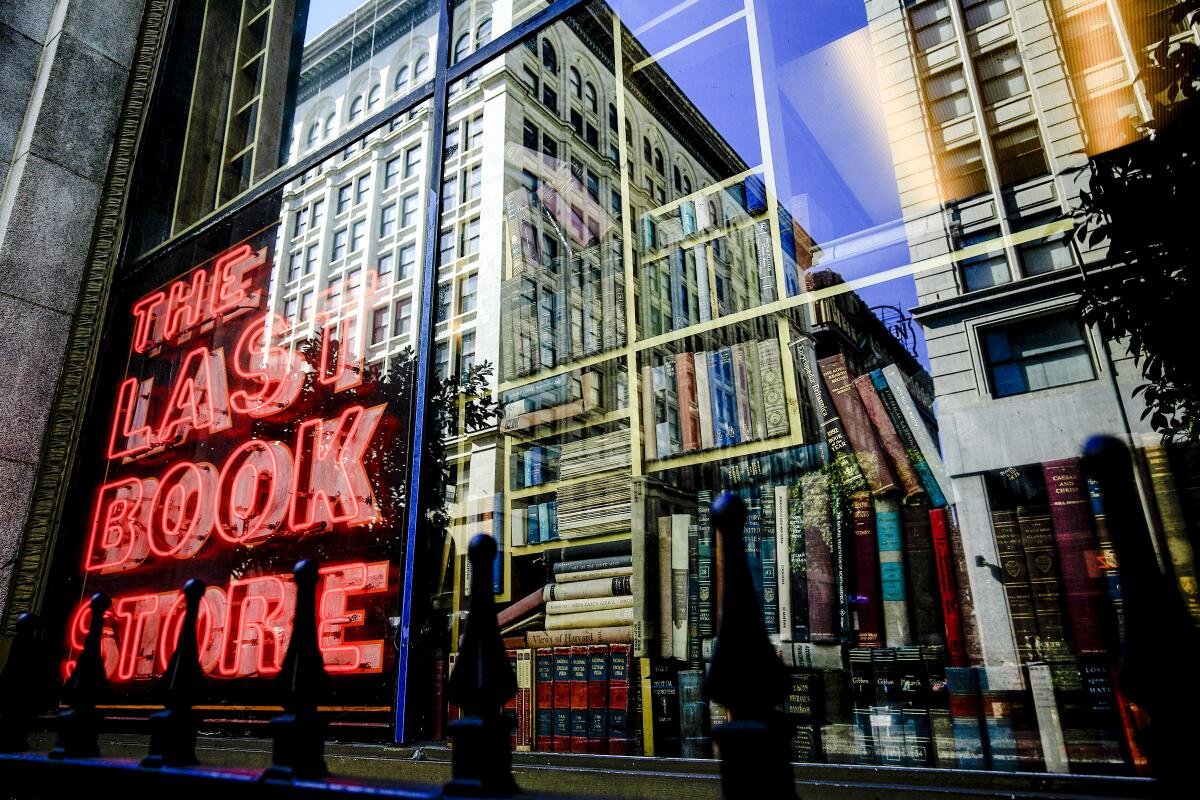
50. Lose yourself in L.A.’s best book nook
The Last Bookstore opened in 2005 as booksellers were faltering across the land, then expanded into this 22,000-square-foot space in 2011. The ground floor beckons with aisle after aisle of new and used books; used vinyl, CDs and DVDs; an annex for art and rare books; and a stage for readings and other performances. The 25-foot-tall white columns, circa 1915, suggest you may be sifting through the ruins of a lost civilization. The suspended artworks hint at acts of magic in progress.
And then there’s the upstairs mezzanine, including the Horror Vault and the Labyrinth, where used books sometimes are arranged by subject, sometimes arrayed sculpturally. Don’t miss the tunnel. Around the periphery, studio spaces harbor artists and artisans. If literature is dead, don’t tell this place’s 103,000 Instagram followers.
Bonus tip: This isn’t actually the last bookstore downtown. Hennessey + Ingalls peddles art and architecture books in the Arts District and Kinokuniya endures in Little Tokyo. And the Central Library (with its amazing mural-lined rotunda and stained-glass globe) is just four blocks away at 630 W. Fifth St.

51. Dine over water on the Malibu Pier
Bonus tip: For a beach experience that’s more Gidget and less Gucci, think about Paradise Cove, eight miles west of the pier. The Paradise operation includes a sequestered beach with a lively restaurant, beach-gear rentals, lifeguards, reclining seats on the sand and servers fetching burgers and rum drinks. Be sure to spend more than $30 in the restaurant and less than four hours at the cove. After that, your free parking expires and you could owe as much as $50.
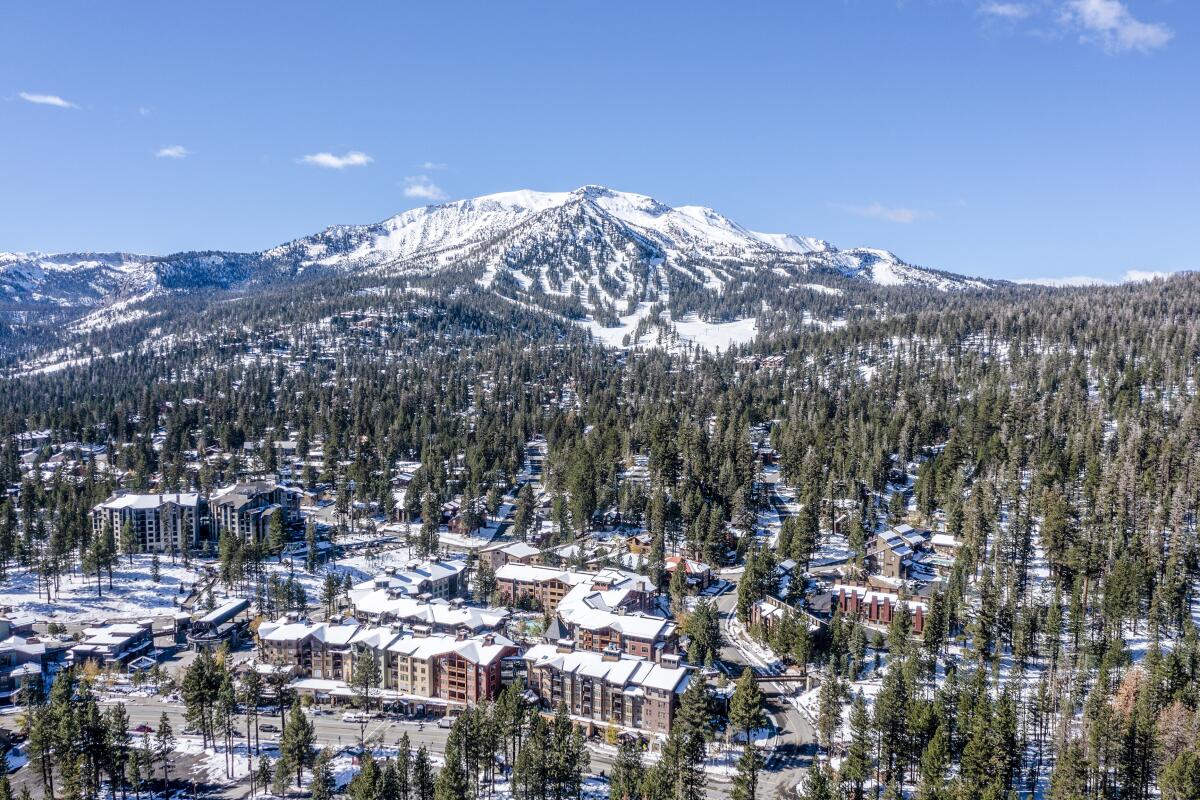
52. Hurtle down Mammoth Mountain
Bonus tip: To break up the 300-mile L.A.-to-Mammoth drive up the Owens Valley, detour into the rugged Alabama Hills near Lone Pine, where dozens of movies and TV shows have been shot, including the first “Lone Ranger” film in 1938. Check out Lone Pine’s Museum of Western Film History, which has maps of filming locations. Farther up the road you’ll hit Bishop, the best place for a bite or overnight between Los Angeles and Mammoth.
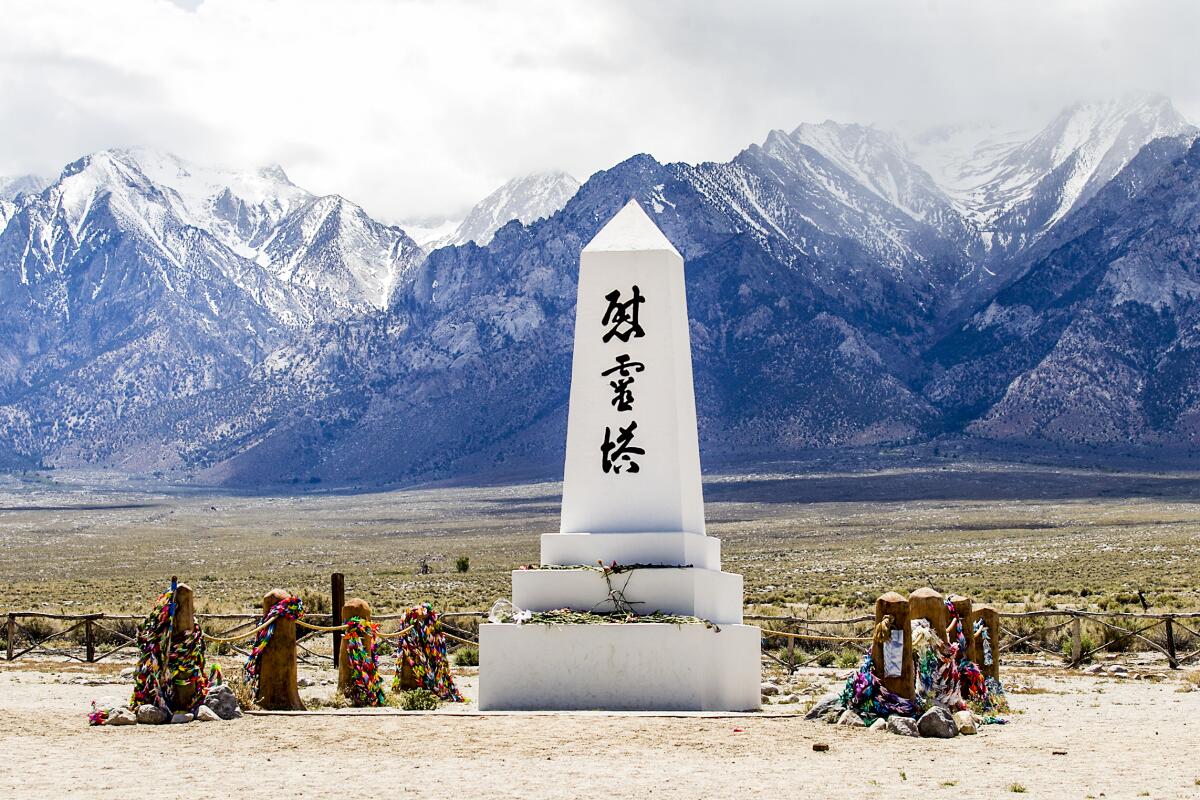
53. Never forget what happened at Manzanar
Drive the camp’s three-mile periphery, between Lone Pine and Independence, and pause at the cemetery, where a tall monument is etched with Japanese characters. There’s a visitor center, theater, museum and reconstructed barracks, where exhibits explain how families lost property, converted fruit crates into camp furniture and debated whether their mess hall should serve Japanese or American dishes. Don’t miss the 1988 news clip of President Reagan declaring the incarcerations “a mistake” and offering compensation for survivors of the camps.
Bonus tip: At least 10 white Americans were convicted of spying for Japan in that era. But NPS research found that no person of Japanese ancestry living in the United States was ever convicted of any serious act of espionage or sabotage during the war.
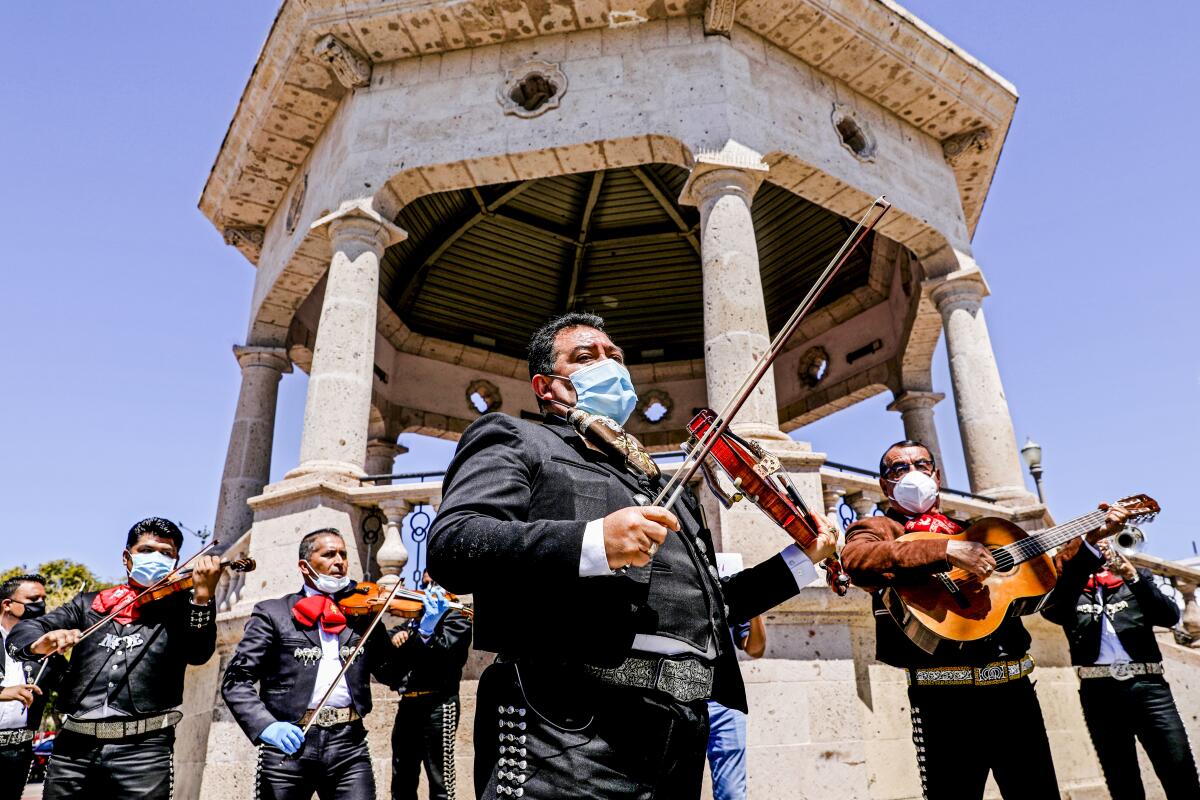
54. Let loose a grito in L.A.’s Mariachi Plaza
To the west, there’s the historic Boyle Hotel, once a hangout for wayward musicians, now the ground-floor site of a La Monarca Bakery & Cafe and the Libros Schmibros Lending Library. On the east side of the plaza rises a bandstand.
Bonus tip: On a warm day, head for the northwest corner of the plaza, near Boyle Avenue, where the J & F ice cream shop stands. Check out the guys playing cards on the wooden benches, the statue of Mexican singer Lucha Reyes, the umbrella-shaded tables. If there’s music you can yelp along with, let out a grito or two. Then maybe get a banana smoothie from Minnie Villa, owner of J & F for the last 11 years.
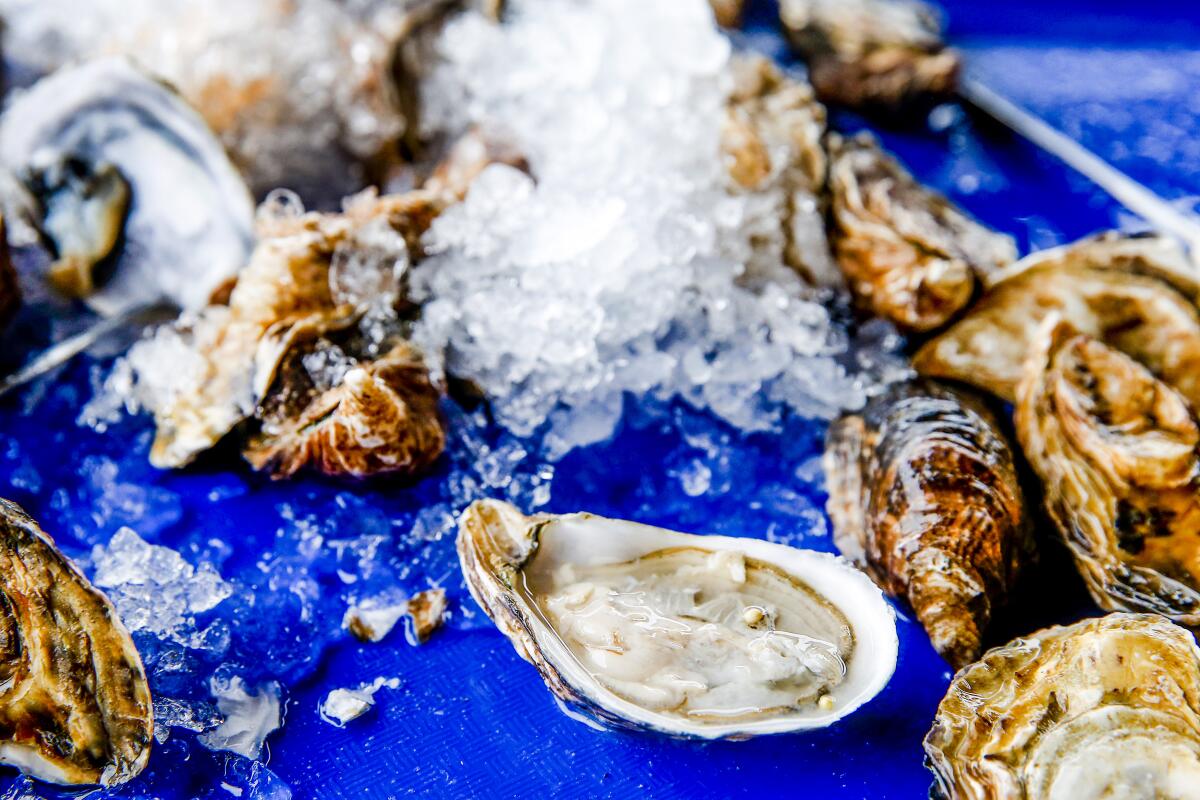
55. Gulp the great oysters of Tomales Bay
Show up around opening at 11 a.m. (to beat the crowds) and get six tangy oysters on ice with lemon and mignonette sauce ($22). The store also sells crab, shrimp, salmon, herring, New England clam chowder and chorizo fish stew.
Bonus tip: Beneath long, narrow Tomales Bay lies a bit of the 800-mile-long San Andreas Fault, the great quake risk that runs from the Salton Sea to Mendocino County. Once your belly is full of oysters, walk the nearby Point Reyes National Seashore’s 0.6-mile Earthquake Trail, which starts near the Bear Valley Visitor Center.
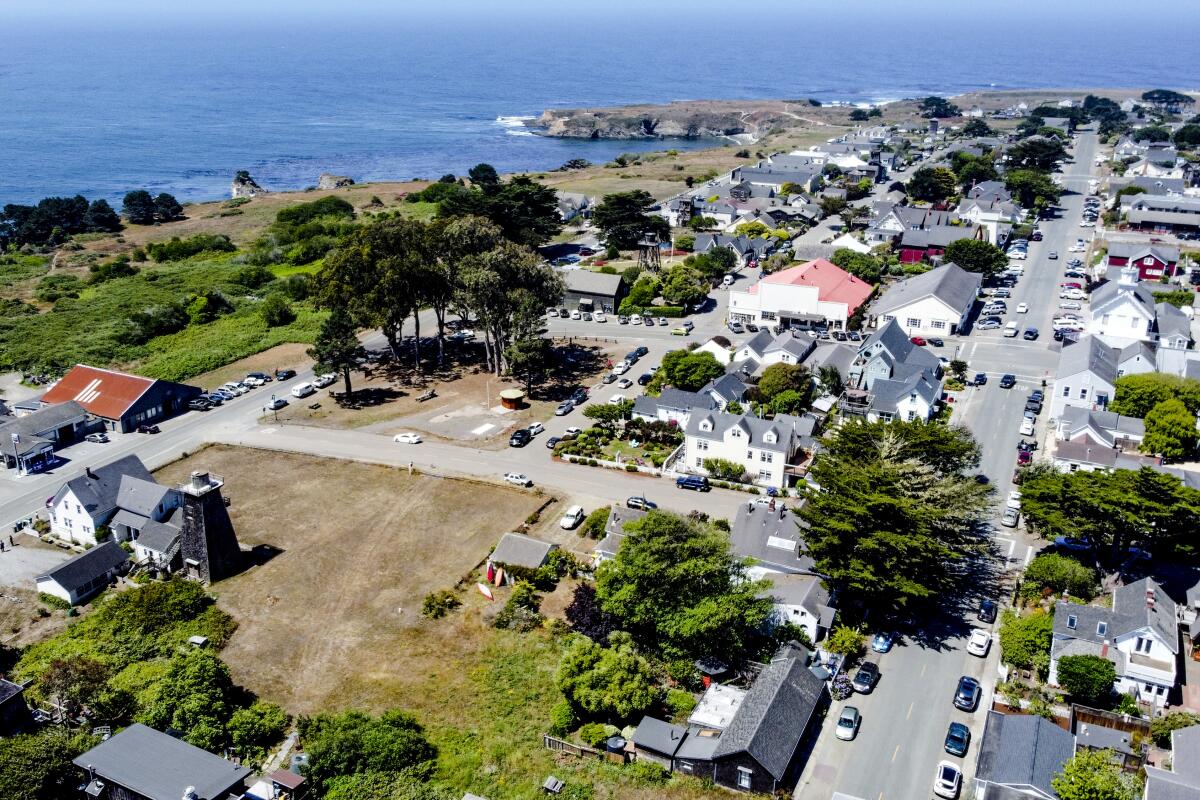
56. Stroll between headlands and Mendocino’s Main Street
Once you’ve taken measure of Mendocino’s mild side, head for the wild side: Mendocino Headlands State Park, which basically surrounds the village, and the Point Mendocino Trail with its views of rocky headlands, the driftwood on Portuguese Beach and Big River, emptying into the sea at Big River Beach.
Bonus tip: For decades, Cafe Beaujolais has been a favorite spot for special dinners, but the meal I loved most on my last visit was a vegetarian Southern dinner at Fog Eater Cafe, which opened in 2019.

57. Tour Europe while never leaving Riverside’s Mission Inn
There’s plenty of spectacle throughout the year too. Book dinner at the Mission Inn Restaurant (main dishes $21-$54) and you may land at a patio table, surrounded by domes, towers, arches and buttresses. (Overnight stays start at $229.) While you’re there, raise a glass to hotel owner Duane Roberts, a local boy who made his first fortune selling frozen burritos.
Bonus tip: The Cheech Marin Center for Chicano Art & Culture — the Cheech, for short — is due to open next door on June 18. The center, to be run by the Riverside Art Museum, will show off actor-comedian-collector Marin’s works by artists including Patssi Valdez, Sandy Rodriguez, Carlos Almaraz, Frank Romero and Gilbert “Magú” Luján.
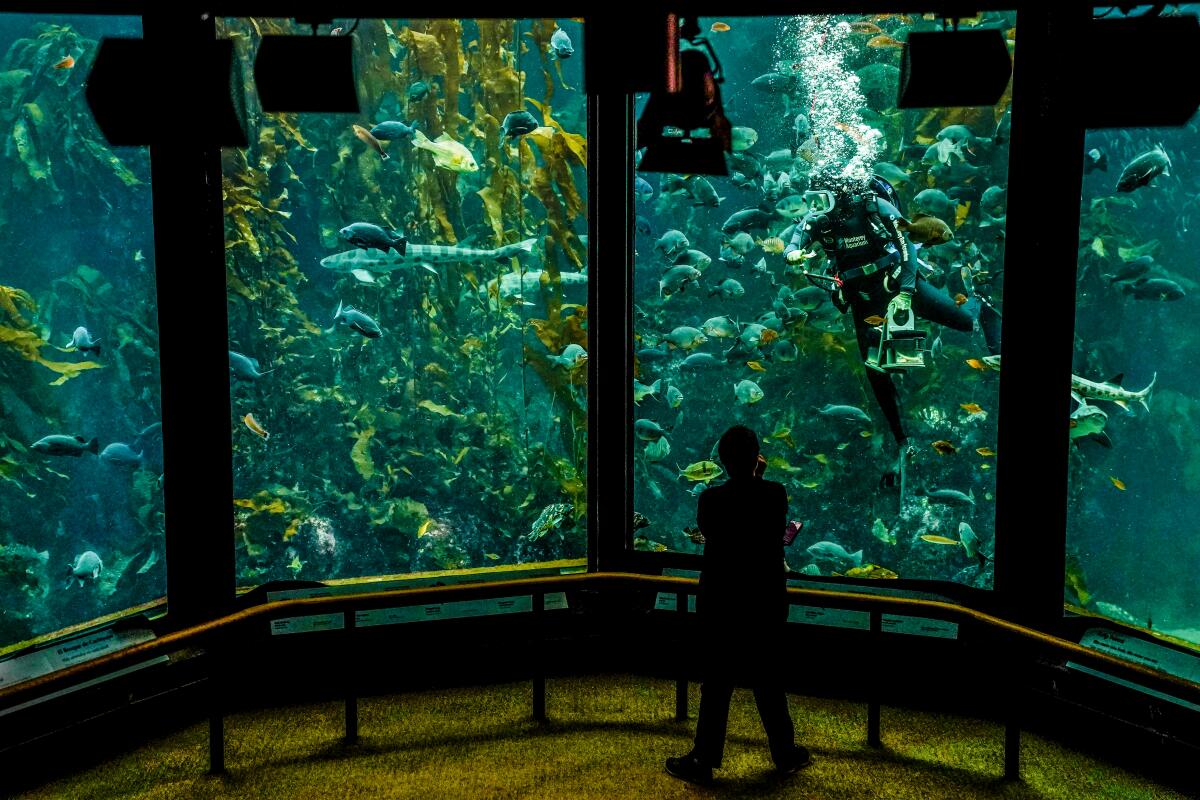
58. Cozy up to a sea angel at Monterey Bay Aquarium
Outside the aquarium, this ultra-touristy neighborhood was once the gritty home and lab of Ed Ricketts, celebrated marine biologist and friend of John Steinbeck, who fictionalized him in “Cannery Row.” Ricketts also is the scientist/philosopher/hero of Steinbeck’s nonfictional “The Log From the Sea of Cortez.”
Bonus tip: Rent a bike from Adventures by the Sea and pedal along Ocean View Boulevard toward Lovers Point and Asilomar State Beach in Pacific Grove. Or just drive to Lovers Point Park in Pacific Grove. This is the California of gnarled cypress trees, jutting rocks, hanging fog and irresistible otters. The 17-Mile Drive at Pebble Beach, perhaps this area’s most heavily promoted attraction since the 1880s, is nearby too.

59. Cruise Moonstone Beach Drive in Cambria
North of the boardwalk, Leffingwell Landing Park begins, offering more trails and coastal views. To the south, you’ll find a rugged coast at the 437-acre Fiscalini Ranch Preserve, where there are more pine cones than surf breaks.
The city’s east and west villages sit a bit inland, and Main Street includes art galleries and boutiques but no chain stores. Sample the eclectic menu at Robin’s Restaurant (a mainstay for more than 25 years), slurp chowder at the Sea Chest Oyster Bar or dig into olallieberry pie at Linn’s Restaurant (which has been around for more than 30 years). Be warned, however, that Cambria has been struggling with water shortages since long before the current drought. If you go, be quick in the shower and frugal with the faucet.
Bonus tip: The Cambria Pines Lodge has been a summertime travelers’ favorite stop for decades, but not everyone realizes what happens there in winter: a monthlong Christmas market, designed to mimic European seasonal marketplaces and strewn with about 2 million lights.

60. Walk or paddle in Morro Rock’s shadow
Some can be climbed for nice views (including Black Hill and Cerro Cabrillo in Morro Bay State Park), but not this sister. Admire this great, rounded boulder from the Morro Bay embarcadero or Morro Rock Beach at the end of Coleman Drive (where there’s a parking lot). Or from the dunes. Or a kayak. Morro Bay State Park, which includes a stretch of shoreline south of the rock, offers many options.
Morro Bay’s waterfront galleries and shops are nice for a few hours’ browsing, and there are watercraft rentals. At local eateries, keep an eye out for Morro Bay oysters. Or go with a quick Mexican bite from the locally beloved Taco Temple on North Main Street.
Bonus tip: Morro Rock usually is a dark landmark in a sunny landscape. But not at sunrise. Get to the water’s edge early and you’ll see it handsomely lighted from the east, the surrounding waters shaded.
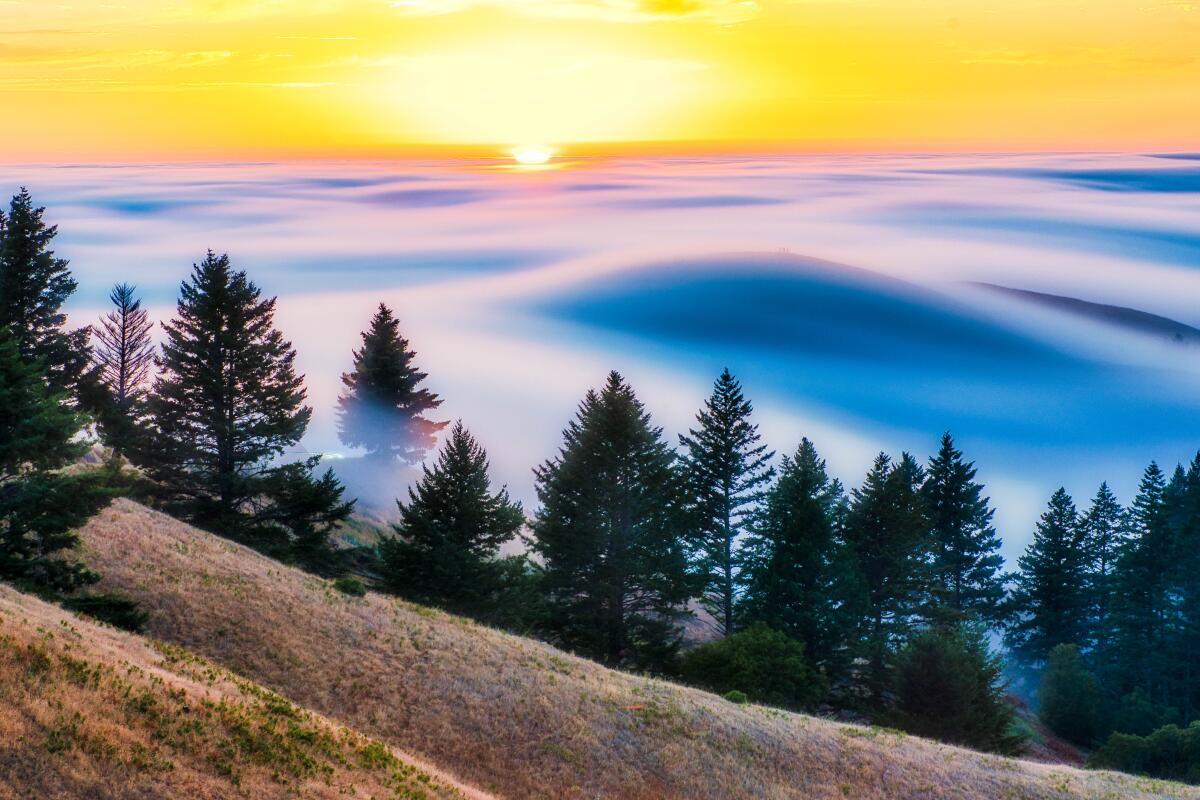
61. Meander Mt. Tam
Bonus tip: If you hike or ride Dias Ridge, you’ll end at Muir Beach by the Pelican Inn, a facsimile of a 16th century English pub with seven snug guest rooms ($244 per night and up, modern plumbing) and a menu full of beers, ales and hearty British dishes. If Shakespeare had found this place, he’d never have gone home to Stratford and there’d be a mountain-biking sequence in “The Tempest.”
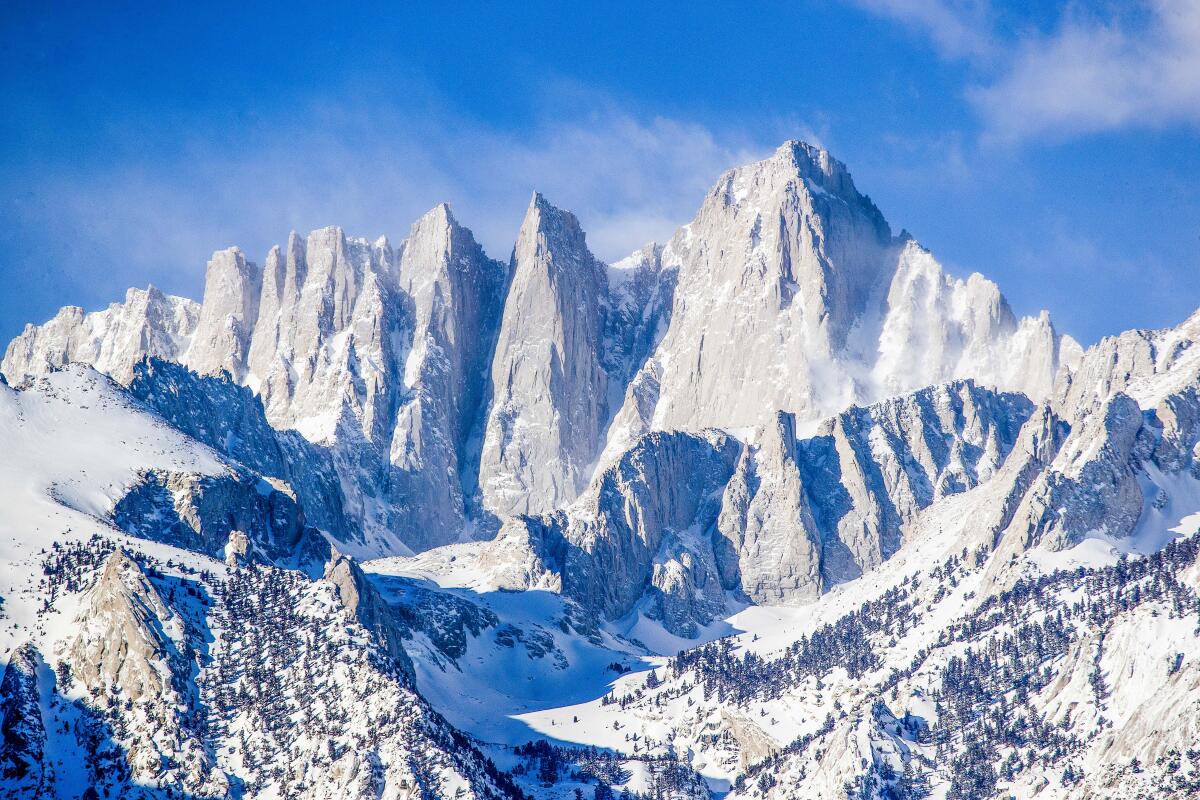
62. Climb California’s highest peak, Mt. Whitney
Bonus tip: You don’t have to go all the way. Instead, do a day hike (no permit required) from Whitney Portal to Lone Pine Lake and back, a 6½-mile round trip that includes about 1,900 feet of elevation gain and often stiff winds.
— Mary Forgione

63. Sip and savor aboard the Napa Valley Wine Train
The train covers about 18 miles, running north alongside California 29 from the city of Napa through Yountville and Oakville to St. Helena. Depending on which tour you choose, you might ride from two to six hours, or take tea or a multiple-course meal, or stop to taste at up to two wineries. You will be very comfortable, and you will pay roughly $200 to $700 per person. So yes, it’s a splurge.
Bonus tip: To spend less time and money (but still live well), head for the oldest winery in the Napa Valley: Charles Krug in St. Helena, founded in 1861 and owned by the Mondavi family since the 1940s. Tastings (by appointment) start at $45, or $75 with a tour.
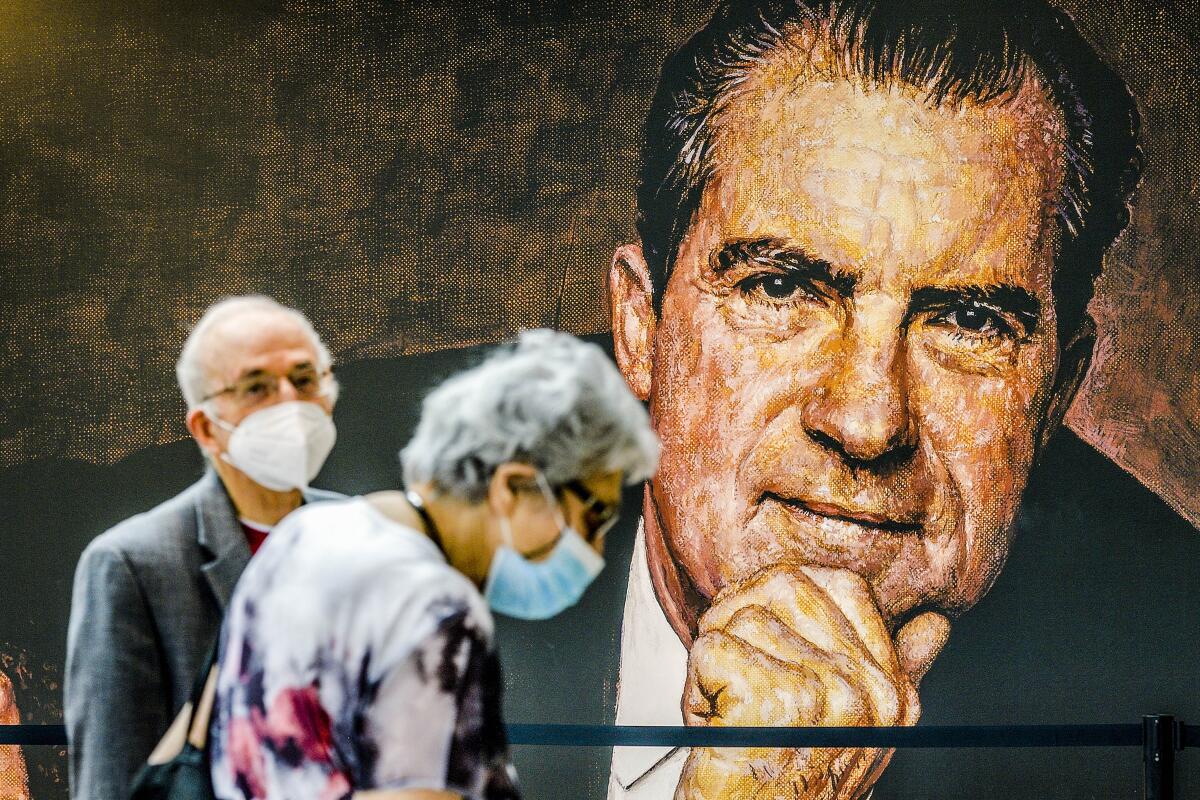
64. Rise and fall with Richard Nixon at his presidential library
As shown in dozens of exhibits on the 9-acre site, Nixon negotiated the U.S. withdrawal from Vietnam, created the Environmental Protection Agency and, in a 1972 visit, made a major diplomatic breakthrough with China. But operatives of his campaign were caught breaking into Democratic National Committee headquarters (in the Watergate office complex), and then Nixon and top aides were caught trying to cover it up. His own secret tapes sealed his fate. He is the only U.S. president to resign.
Nixon and his wife, Pat, are buried here next to the modest home where Nixon was born, which is now part of the library grounds. She died in 1993; he died in 1994.
Bonus tip: In 2018, the National Archives finished digitizing all 4,042 reels of Nixon’s infamous White House tapes. Whether you’re in the library or on a computer at home, you can now eavesdrop on the president as he makes phone calls, confers with Secretary of State Henry Kissinger, considers dropping Spiro Agnew as his vice president and ponders relations with China and India.
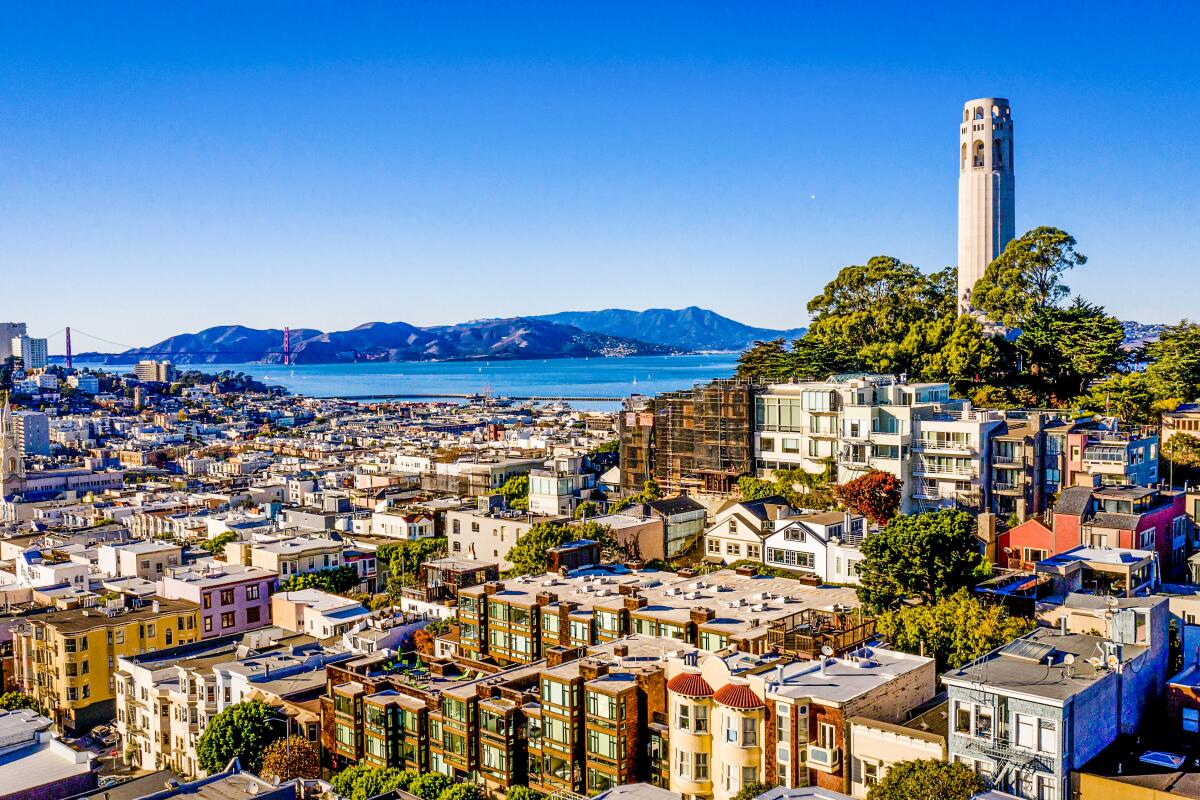
65. Taste Italy in North Beach
When hunger strikes, get a big, messy sandwich at Molinari Delicatessen (established 1896) and eat it on a bench in Washington Square. Or linger over coffee at Caffe Trieste (since 1956). Or dig into prizeworthy pies at Tony’s Pizza Napoletana on Stockton Street.
Ready to burn off a few calories? Climb the Filbert Stairs up Telegraph Hill to Coit Tower (1933), where you can admire the witty ground-level Depression-era murals. Then ride an elevator to the top of the 210-foot concrete tower for a 360-degree view of the city, bay and bridges ($10 per adult, or $7 for San Francisco residents).
Bonus tip: Columbus Avenue is North Beach’s main drag but many of the best discoveries await in the alleys and side streets, including Green Street, where Sodini’s, Sotto Mare and other eateries have outdoor dining.
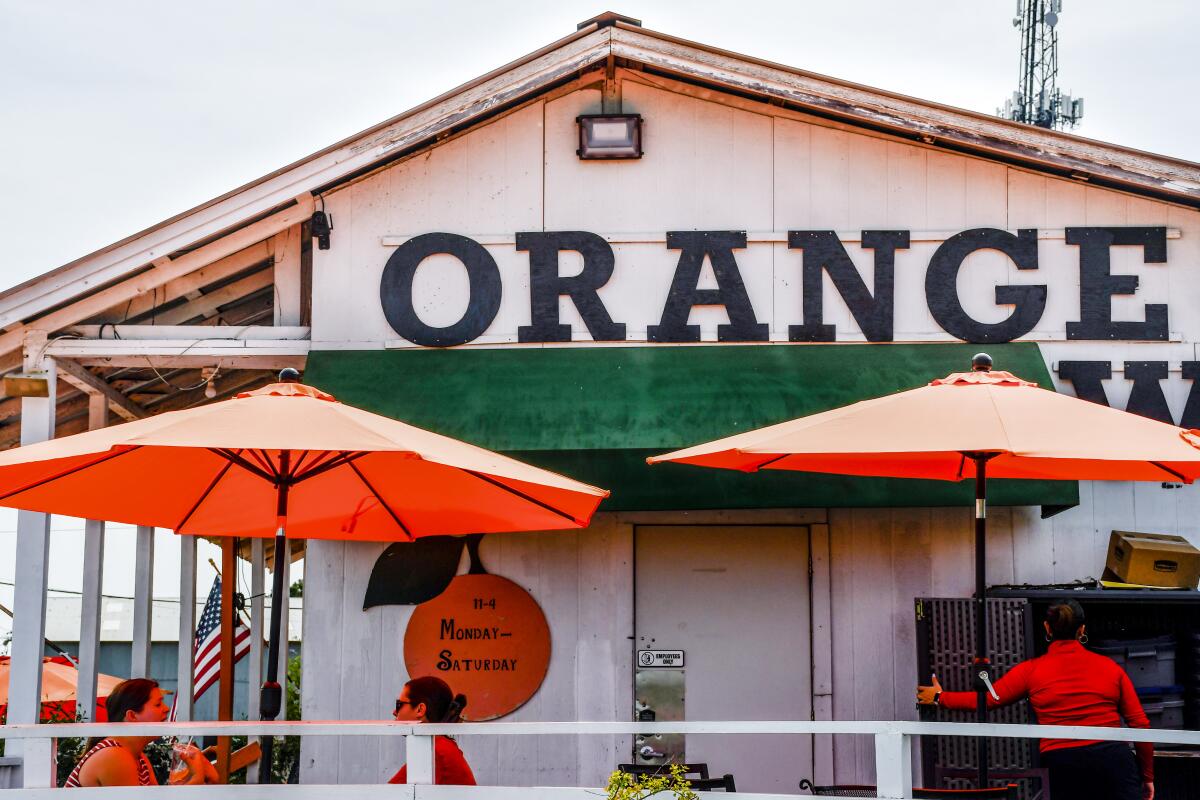
66. Gobble grove-to-spoon ice cream at Strathmore’s Orange Works Cafe
It’s a family business. The Orange Works rotates other homemade, farm-fresh ice cream flavors too, including persimmon, pomegranate and cantaloupe. There are milkshakes and smoothies. There’s a Visalia location too, though I’m uncertain of its moral authority.
Bonus tip: If you’re headed from anywhere in Southern California to Sequoia National Park, you will likely drive via I-5 and highways 99 and 65. Orange Works is right there on Highway 65. Just remember that it’s closed on Sundays.
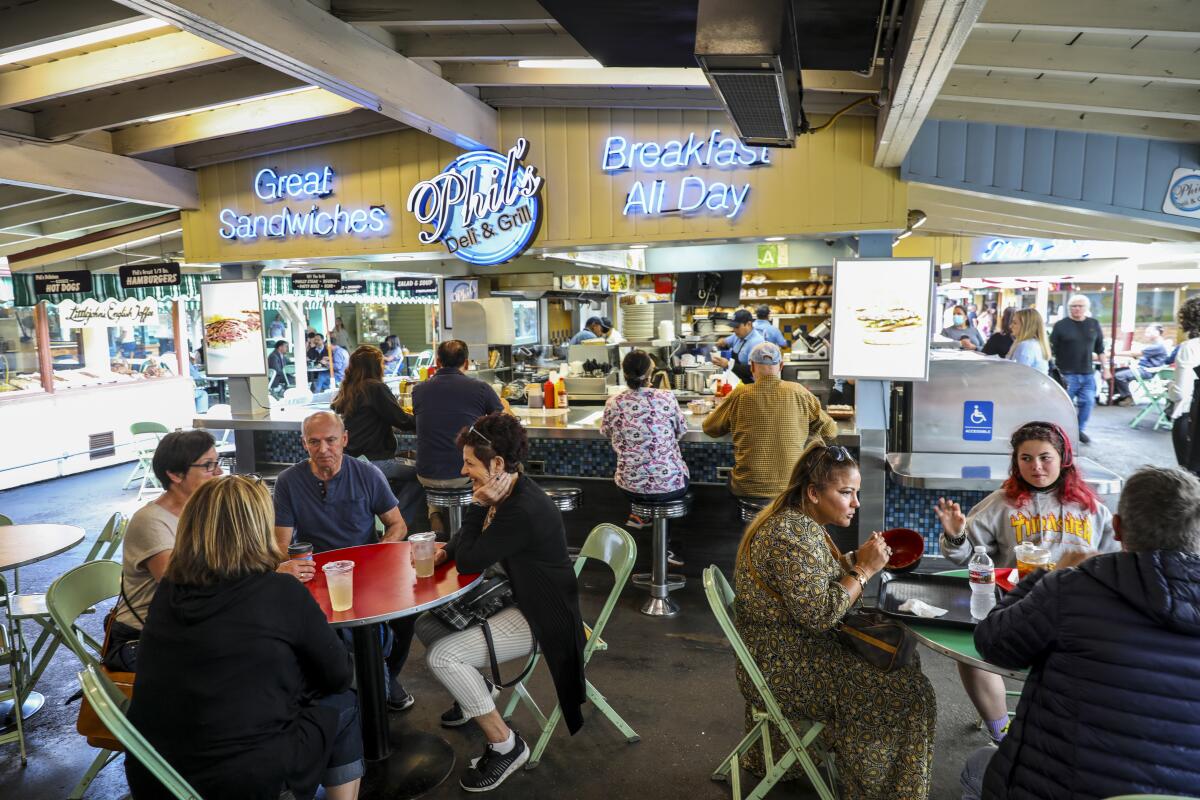
67. Dunk doughnuts at L.A.’s Original Farmers Market
Of course you’re hungry. For all things French, try Monsieur Marcel Gourmet Market. For tacos, Trejo’s. For pie, Du-par’s (since 1938). And if you really do want to dunk a doughnut, Bob’s Coffee and Doughnuts (stall 450) has been at the market approximately forever. Most doughnuts cost 95 cents.
If you’re traveling with teens or you want a full-blown shopping excursion, you’ll also need to head next door to the Grove, whose burbling fountain, circling trolley and national-brand retailers exert a gravitational pull on buyers, browsers and hangers-out for miles in every direction. (Its dozen-plus restaurants and 14 movie screens don’t hurt, either.) The Grove has more parking and foot traffic but the market has seniority.
Bonus tip: For more old/new contrasts, wander among the teen-seeking streetwear shops on Fairfax Avenue between Beverly Boulevard and Melrose Avenue — the Hundreds and Solestage, for instance — and you’ll find they’re neighbored by older Jewish markets and restaurants, mostly notably Canter’s, which is open all hours and a few years older than the Farmers Market.
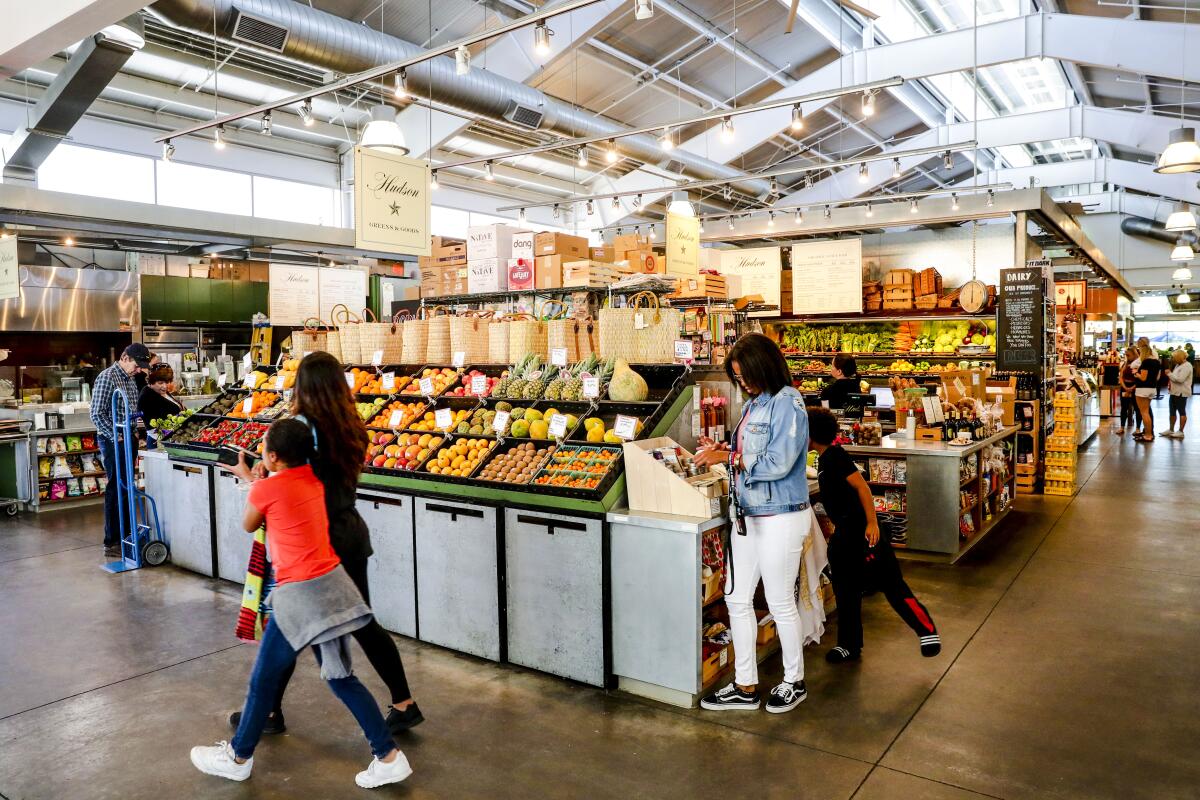
68. Peruse the pickles at Oxbow Public Market
The Oxbow Public Market, which datees back to 2007, has about two dozen merchants and restaurants. They offer buffalo and duck tacos (C Casa), sushi (Eiko’s), American comfort food (Gott’s Roadside), local seafood (Hog Island Oyster Co.), house-made bagels and pickles (Loveski Deli) and organic local produce (Hudson Greens & Goods). For variety’s sake, there’s a little bookshop, too. The market is open until 9 every night, though individual shop hours can vary.
Bonus tip: The market is about two blocks southeast of the start of the Napa Valley Wine Train and two blocks southwest of the CIA at Copia, which is not a spy shop but a dining-and-education venture of the Culinary Institute of America.
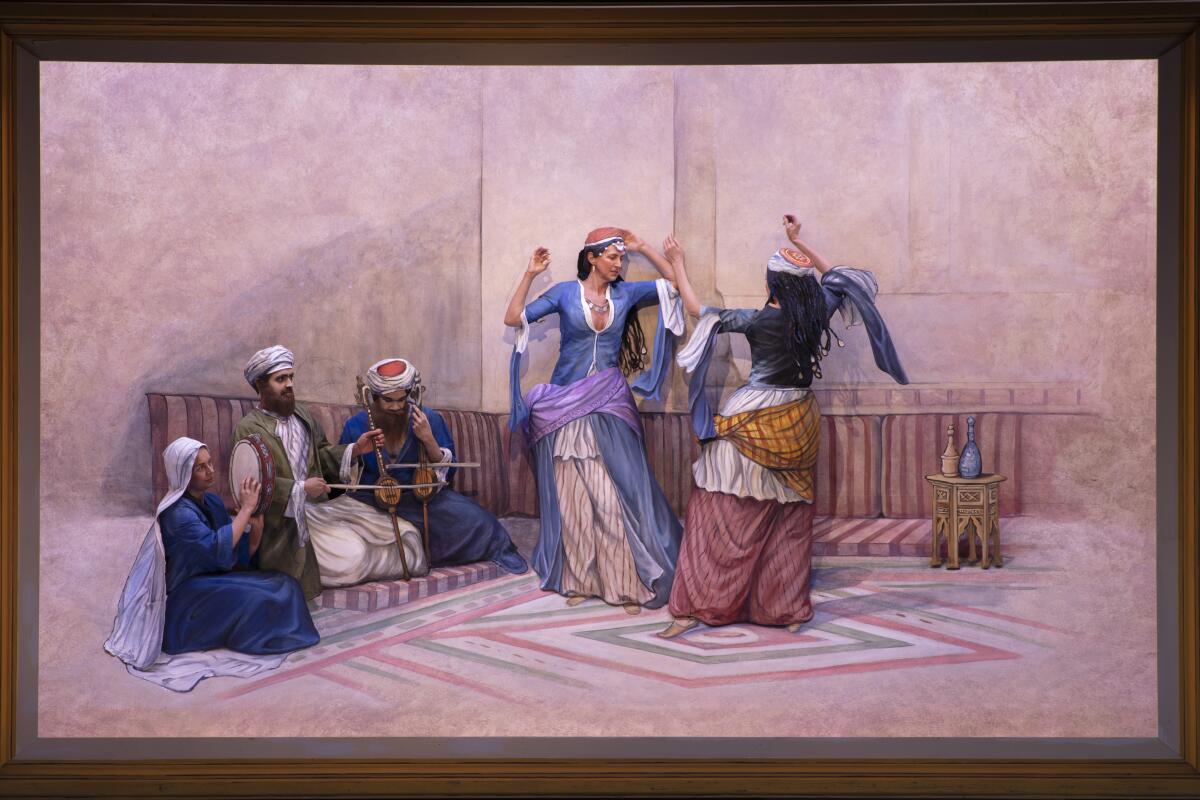
69. Gawk at the living art of the Pageant of the Masters
The ritual has its roots in 1932, when area artists were looking for a spectacle to lure Olympics visitors from Los Angeles. It has evolved into a strangely potent, family-friendly night of entertainment in a 2,600-seat amphitheater. The theme of the 2022 pageant, which runs July 7-Sept. 2, is “Wonderful World.” Tickets cost anywhere from $40 to $280 for a seat. Parking is usually difficult, and the pageant has no dedicated adjacent lot, but there is an app to help you find a spot. Expect to do some walking or waiting for a shuttle.
Bonus tip: Living artists need to eat too. Hence the annual juried Festival of Arts Fine Art Show (July 5-Sept. 2 in 2022) and summer and winter events by Laguna Beach’s Sawdust Art & Craft Festival, which feature scores of local artists and makers presenting their works in a village setting (yes, there’s sawdust underfoot) with snacks and live music on three stages. There are classes you can sign up for too.
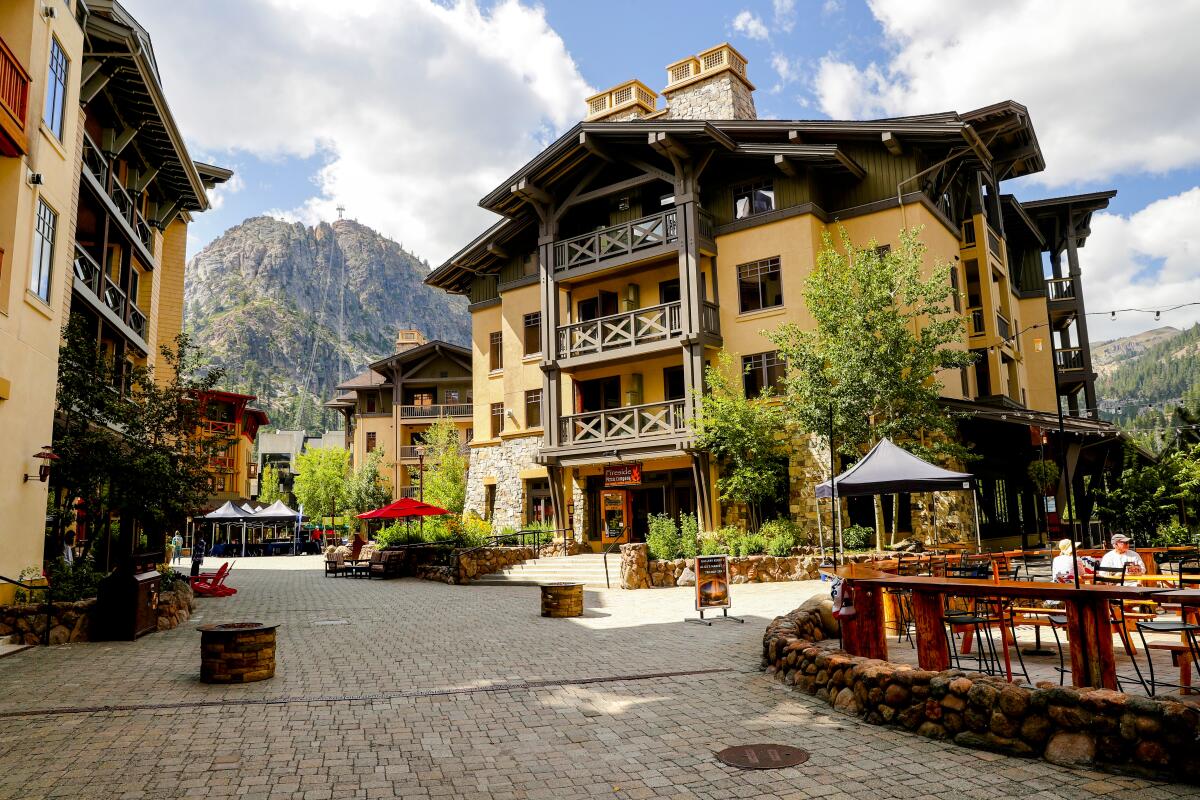
70. Ski or board on the path of Olympians at Palisades Tahoe
One is Olympic Valley, with 29 lifts, 170 trails, nearly 3,600 navigable acres, five terrain parks and a proud history as the site of the 1960 Winter Olympics. But never mind that. Just look at the way its aerial tram dangles above a majestic, forbidding pile of boulders known as Tram Face.
The second mountain, a seven-mile drive away, is the Alpine Meadows area (13 lifts, 100 trails and 2,400 navigable acres). Because of its location, locals say it has the longest potential ski season of any local resort. For snow conditions on California slopes, check snowpak.com, onthesnow.com or skicalifornia.org.
Bonus tip: In the Village at Palisades Tahoe, you’ll get hearty portions at Tremigo Mexican Kitchen and Guinness on tap at the Auld Dubliner a few steps away. If you’re splurging, PlumpJack Cafe (Thursday-Monday, 3-9 p.m. in winter) does dinner and aprés-ski food and drink.
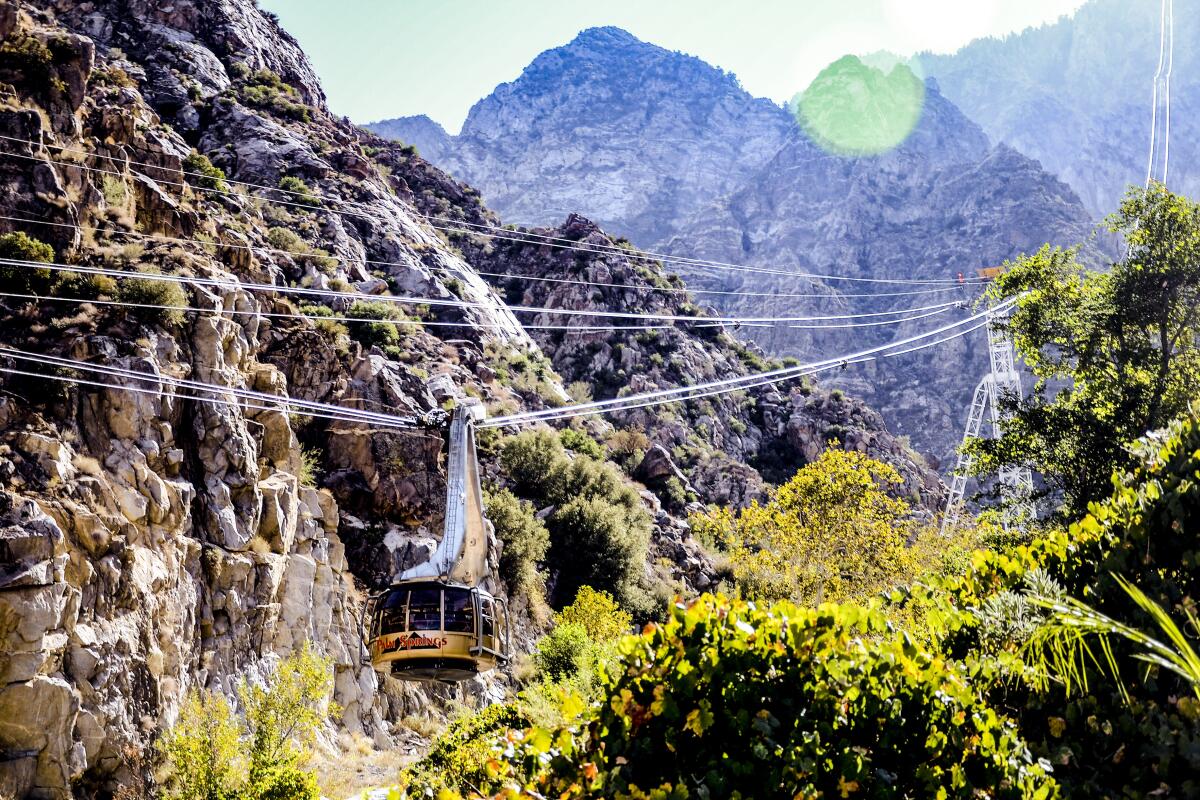
71. Zip from desert floor to mountain snow on the Palm Springs Aerial Tramway
Back in 1935, a man named Francis Crocker proposed a tram ride to connect the Coachella Valley desert floor to the upper slopes of Mt. San Jacinto. Twenty-eight years later, the Palm Springs Aerial Tramway opened.
After parking ($10), you step into Valley Station (elevation 2,643 feet), pay $28.95 per adult ($16.95 per child ages 3-10) and board the gondola, having made sure there’s snow up high.
Then you begin the climb up Chino Canyon in a slowly rotating gondola (with open windows and a capacity of 80 passengers). It’s a 2.5-mile trip to Mountain Station (elevation 8,516 feet), where it’s typically 30 to 40 degrees cooler than at Valley Station.
The last tram up leaves at 8 p.m., so there’s time to catch sunset or dusk. There are a couple of restaurants at the top: Peaks is fancy, Pines is a cafeteria, and both are open for lunch and dinner. The Lookout Lounge, also up top, serves beer, wine and cocktails until 5 p.m.
Bonus tip: Once there’s a good amount of snow, the Mountain Station-adjacent Winter Adventure Center will open, offering rental snowshoes and cross-country skis at $18-$21 per day. Call or consult the website to check the Adventure Center status.
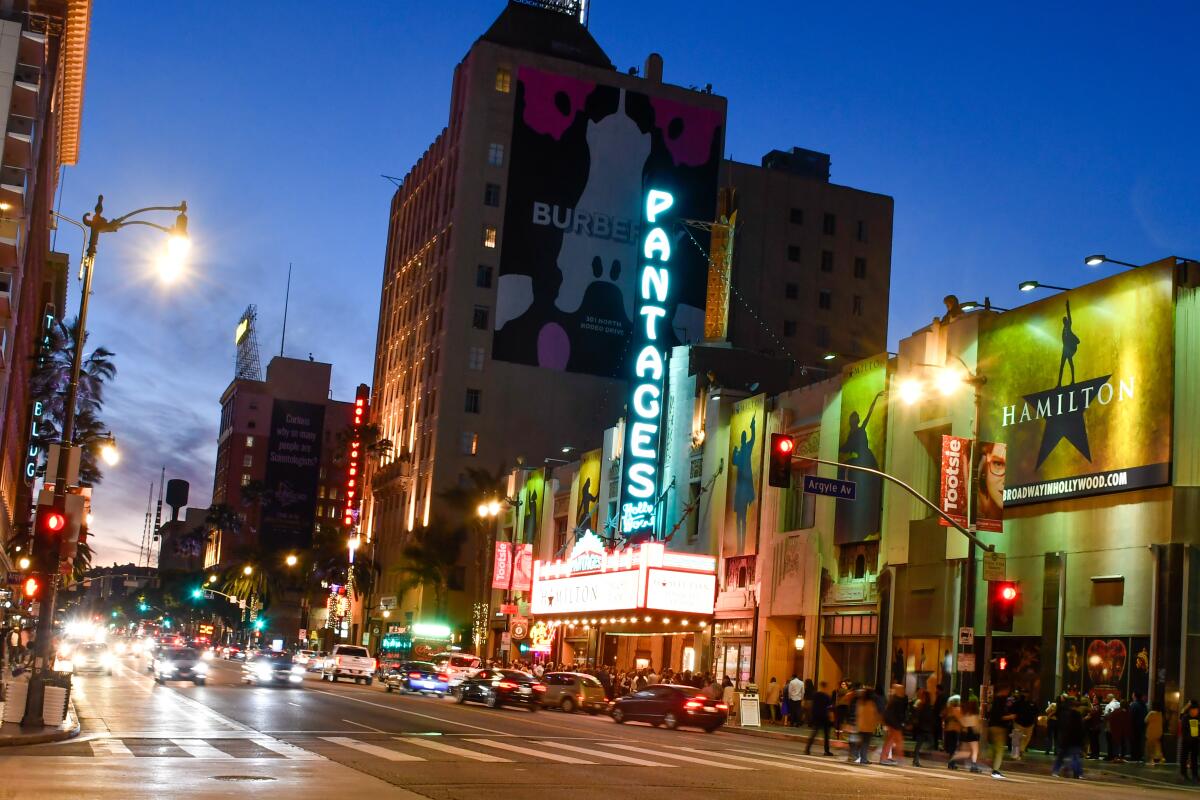
72. Frolic at the Pantages
But the touring shows that land here are usually top-drawer. (“Hamilton” played the Pantages for ages. Starting in June: “Pretty Woman: The Musical” and “Moulin Rouge!”) Next door to the theater, take a moment to admire perhaps the coolest piece of neon in the city: the sign of the Frolic Room dive bar. Inside, it has a wonderful celebrity-studded mural by caricaturist extraordinaire Al Hirschfeld on its east wall, celebrating the showbiz types who used to hang out in that same snug, dim space.
Bonus tip: You can’t beat the vinyl and CD browsing (new and used) at Amoeba Hollywood, half a block east of the Pantages. A few blocks to the west (across from Musso & Frank), you can step into stage and cinema history at the easy-to-overlook Larry Edmunds Bookshop (founded in 1938), which bulges with books, posters, scripts, photos and Hollywood ephemera.
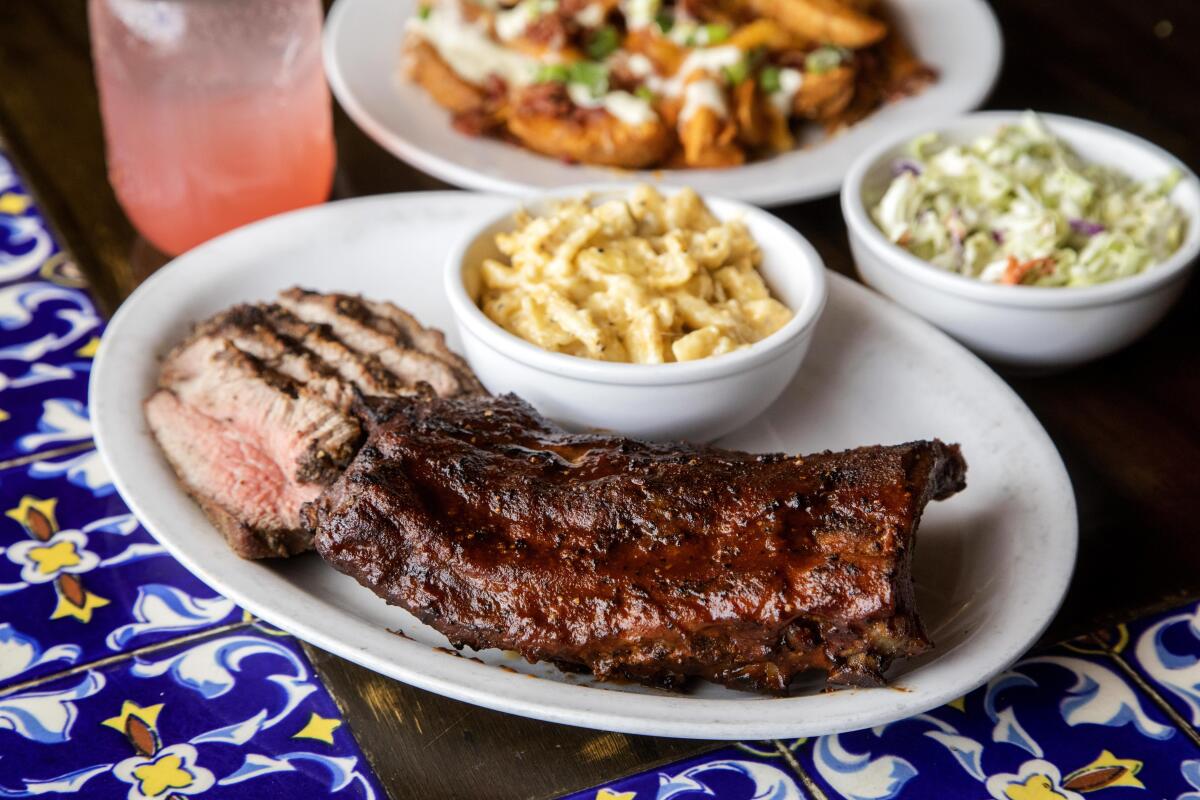
73. Smell the grill and hear a band at Pappy & Harriet’s desert roadhouse
The joint, about 15 miles west of Joshua Tree National Park’s west entrance, was built as a movie-set cantina in 1946 and has operated under its current name since 1982. But it feels as native as a creosote bush.
Steaks are cooked on an outdoor grill, beer is served in Mason jars and all meal service (hearty portions) is first come, first served — so expect lines on weekends. There’s one stage outdoors, another indoors. Pappy’s is closed Tuesdays and Wednesdays.
Bonus tip: You’ll want time to nose around the rest of Pioneertown, all of which was built as a movie set. It’s edging its way back toward becoming a true Western town with a motel, saloon, twice-monthly drive-in theater and (once a long-running kitchen upgrade project is done) a vintage six-lane bowling alley.
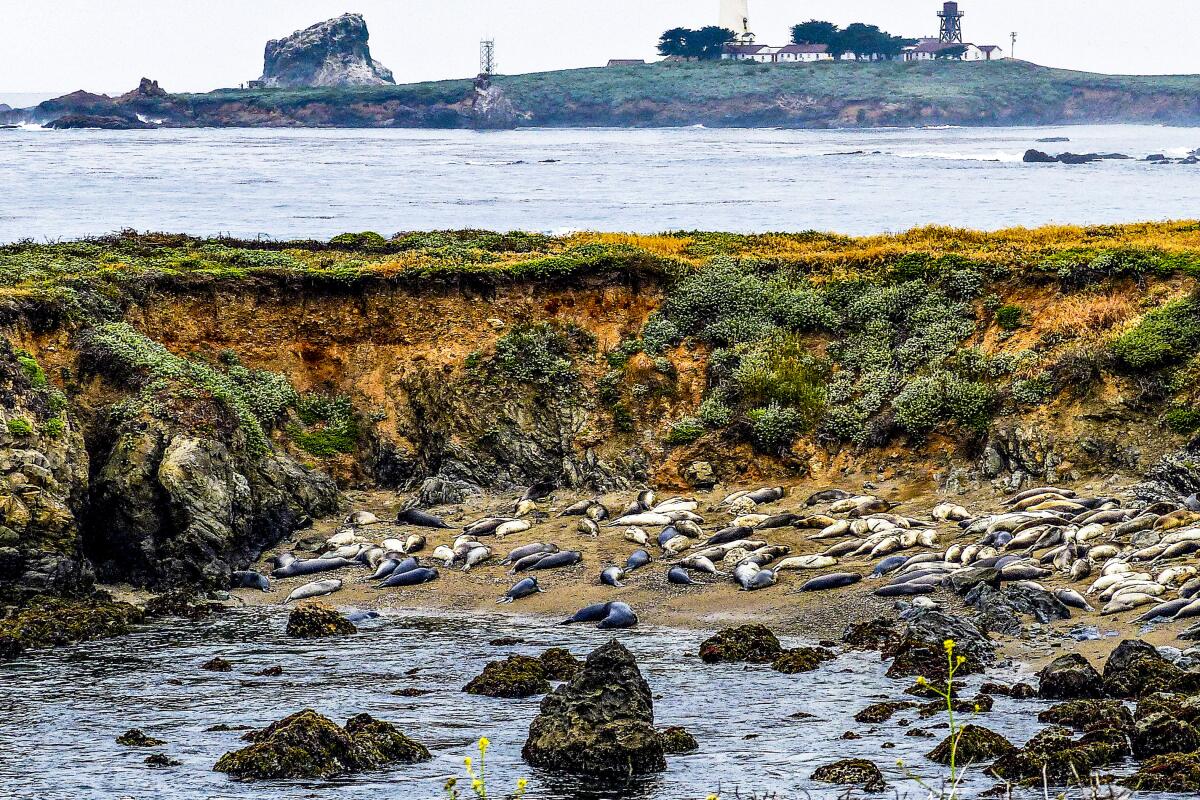
74. Marvel at the massive elephant seals near San Simeon
So, of course, you want to see, hear and smell it all. Depending on the month, you may arrive at the Piedras Blancas Rookery to find hundreds of these seals basking, sparring, giving birth or mating on a ridiculously beautiful stretch of state-controlled undeveloped coastline seven miles north of San Simeon. (Need a preview? Here’s a live beach cam feed.)
There’s a parking lot and boardwalk (wheelchair-accessible), usually patrolled by volunteer docents. Stay at least 25 feet away from the seals. No dogs, no drones.
The beasts are called elephant seals because of the large proboscis grown by the adult males (which get up to 18 feet long and 5,000 pounds). In November, thousands of the males begin showing up (and skirmishing) on the beach after months at sea. In December, pregnant females start gathering in “harems” around dominant males. In January and February, the females typically give birth, followed by the resumption of mating a few weeks later. In March, the adult males leave, having lost up to 40% of their body weight in fasting, fighting and fornicating. Females and weanlings leave later, returning to molt in spring and summer.
Bonus tip: Nineteenth-century fishermen nearly wiped out these creatures, using their blubber for lamp oil and lubrication. Elephant seals also are common at Año Nuevo State Park in Santa Cruz County and Point Reyes in Marin County.
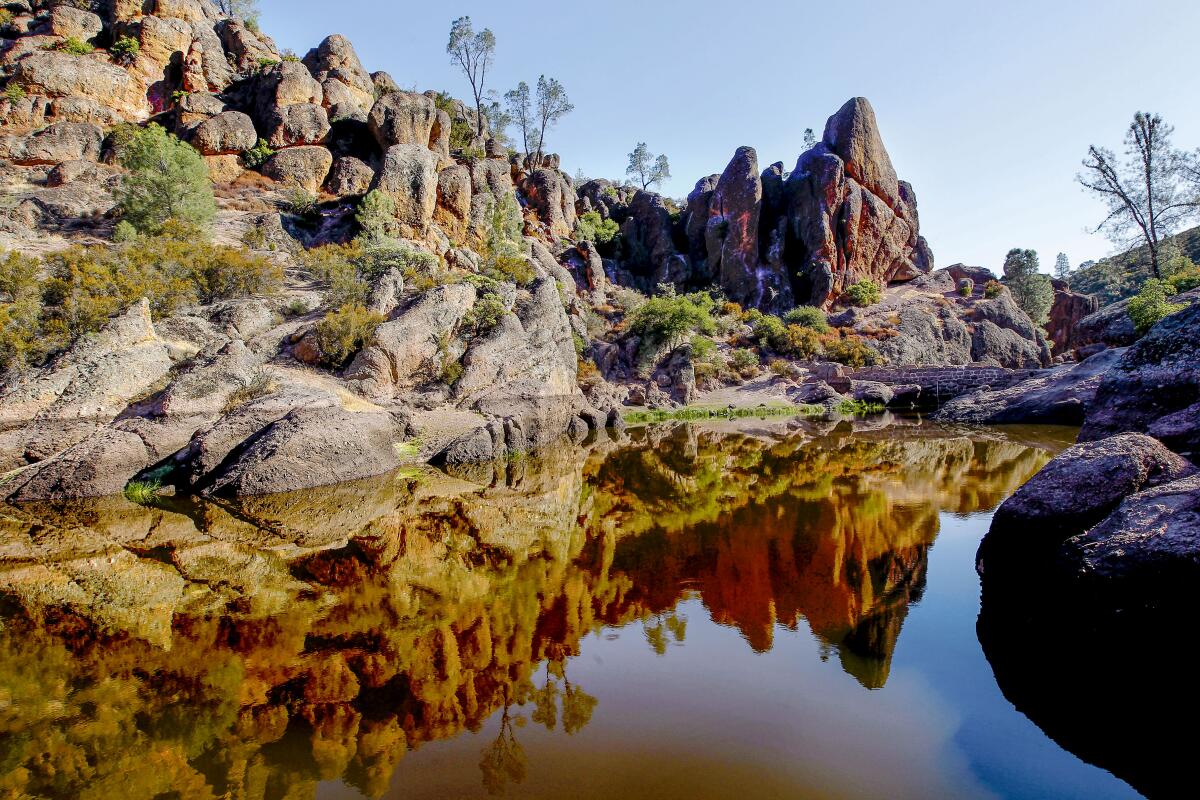
75. Creep through caves and chase condors at Pinnacles National Park
What it doesn’t have is easy infrastructure. There are fewer than 400 parking spaces, and no roads connecting its east and west sides. Only the east side has camping.
But each side has trails that lead through talus caves under stacked boulders, and those trails climb to cliff-clinging paths with big views. The skies overhead are often busy with condors, turkey vultures and other raptors. Head for Balconies Cave on the west side, Bear Gulch Cave on the east. Go to the west side, near the town of Soledad, if you’re making a day trip from Paso Robles or Monterey via Highway 101.
Bonus tip: Don’t go in summer. It gets dangerously hot, and that’s when the caves are usually full of bats and closed to people. In cooler months, the bats hibernate and hikers are usually allowed inside. (Call or check the website for the status of the caves.)
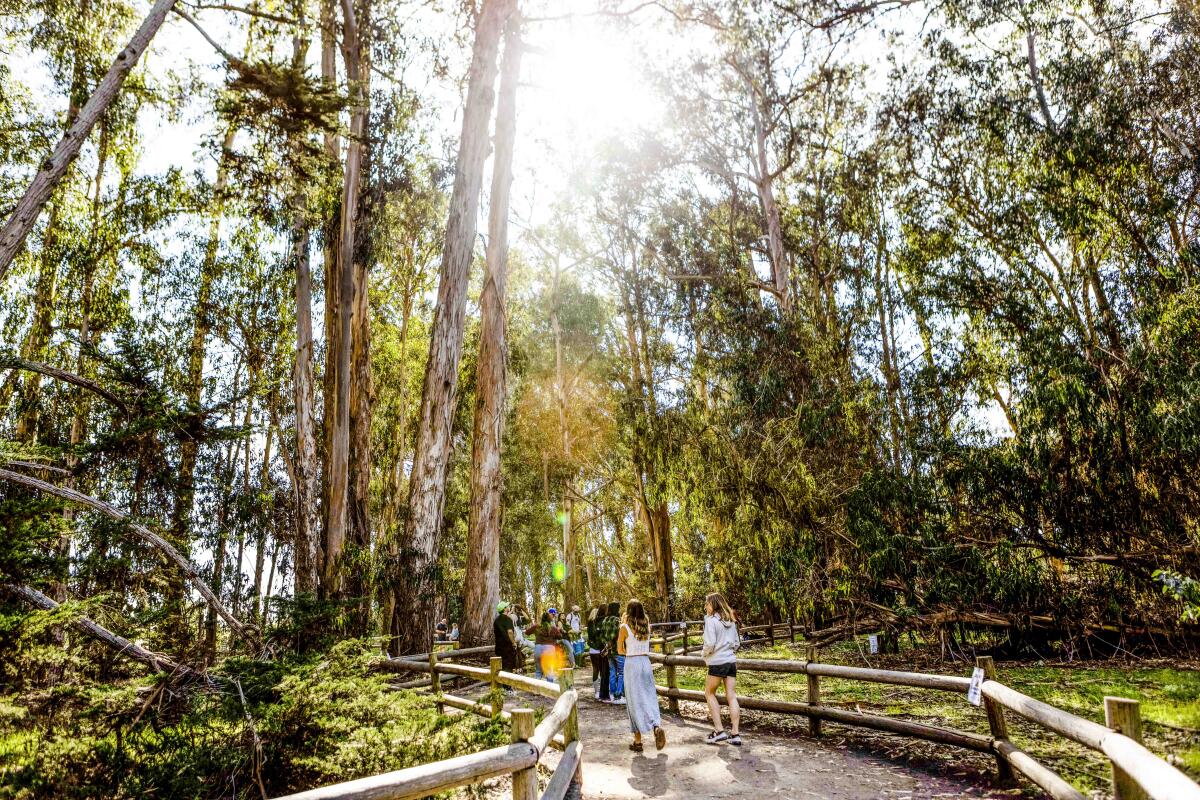
76. Hang with flighty royalty in a Pismo Beach butterfly grove
The grove is free and open sunrise to sunset. Be sure to give the creatures space. And remember that their future is iffy.
Monarch butterfly populations have been dropping dramatically for years. And the grove, a short stroll from the shore, is an unprepossessing cluster of eucalyptus and cypress trees. But look closely.
Those dirty leaves you see? They might be monarch wings. When the sun comes out, their orange hues blaze and you realize how many butterflies you’re looking at. Even if the sun doesn’t come out, docents often have a telescope trained upon the biggest clumps of butterflies.
The monarch season at this grove usually runs November through February (as it does in groves of Goleta and Pacific Grove). Annual counts have shown a 90% drop in monarchs over the last 25 years, until last winter’s unexpected surge.
Bonus tip: The Xerces Society for Invertebrate Conservation has advice on how to help monarchs, including butterfly-friendly plants you can grow in your yard.
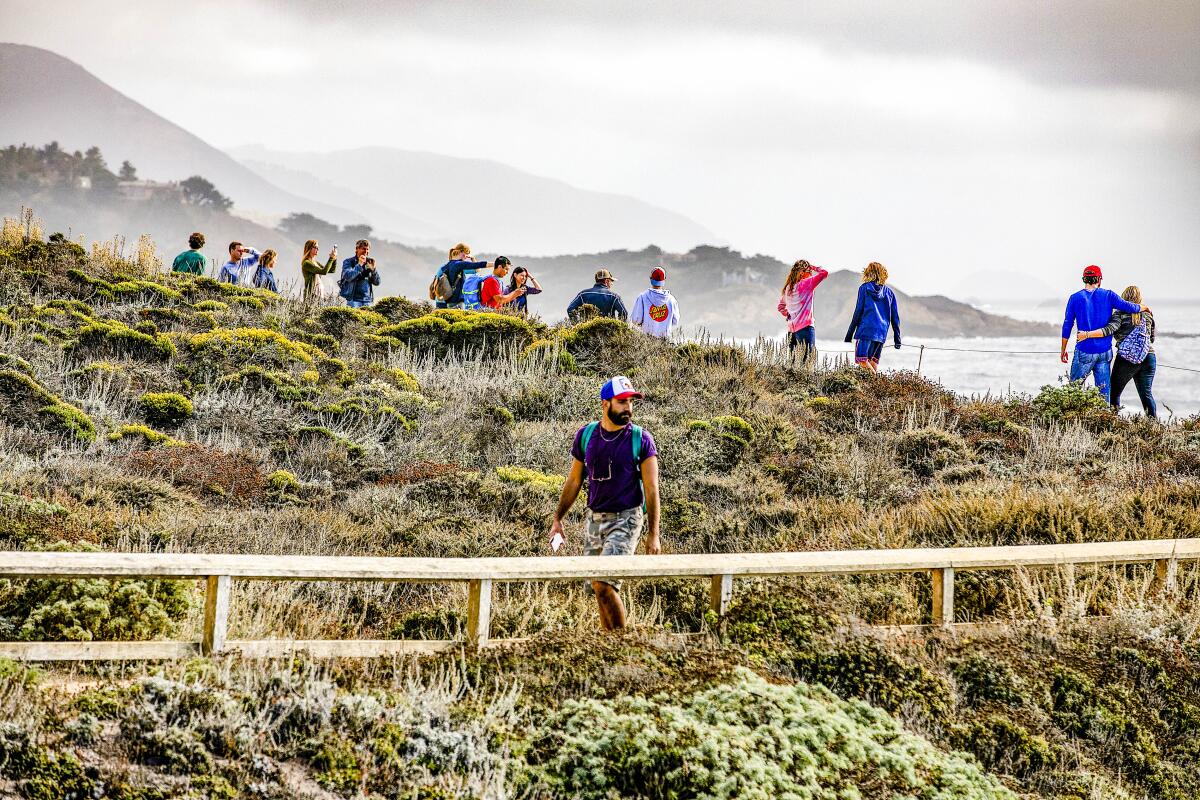
77. Greet a grizzled veteran at Point Lobos
It used to be a working shoreline. Soon after the Gold Rush, Chinese immigrants arrived to fish. Later came whalers, Japanese and Portuguese fishermen and an abalone cannery. Since 1933, the state has owned the land. Take the 1.4-mile North Shore Trail between Whalers Cove and Sea Lion Point and keep an eye out for Old Veteran, a gnarled and grizzled Monterey cypress that clings to a clifftop. Check out the blufftop Whalers Cabin, built by Chinese fishermen long ago, now a compact cultural museum.
At Weston Beach, remember acclaimed photographer Edward Weston, who made images here from the late 1920s to the late 1940s and whose ashes were scattered here in 1958. Don’t be startled if you encounter SCUBA divers; for them, Point Lobos is the gateway to the abundant Monterey Bay National Marine Sanctuary. Admission is $10 per car; the 150 parking spaces often fill up, inspiring the frugal and the tardy to park along the shoulder of the highway. It’s open 8 a.m.-7 p.m. No dogs or drones.
Bonus tip: “Come in the winter when it’s stormy and no one’s out here,” Edward Weston’s grandson, photographer Kim Weston, told me several years ago. “It’s an amazing piece of land.”

78. Wander a San Luis Obispo canyon full of designers’ dreams
Here’s what happened: In the 1950s, when Cal Poly was beginning to earn a reputation as a formidable school of architecture, designer and futurist R. Buckminster Fuller gave a stirring lecture about geodesic domes. So five students built one on campus.
In 1963, the university moved the dome out to Poly Canyon on the northeastern edge of the campus. Since then, the canyon has become a one-of-a-kind testing ground that now holds more than 20 experimental projects. The idea, Architecture School Dean Christine Theodoropoulos says, is to give students an understanding that comes only “when you touch the materials.” The canyon is busiest in April, when the school’s Design Village event invites competitors to build temporary structures. This year, organizers had to cope with an accumulation of pandemic-era graffiti.
Still, it’s a singular place, and it’s open to hikers. It’s a hike of about 2.5 miles from campus to the first structure and back. Park in Visitor Parking Structure 131. Don’t be surprised if you meet cows or horses or students snoring in hammocks.
Bonus tip: Don’t miss my favorite structure, which looks like a whitewashed Gumby playing Twister. It’s called “Hay Bale Arch” and it went up in 2004.
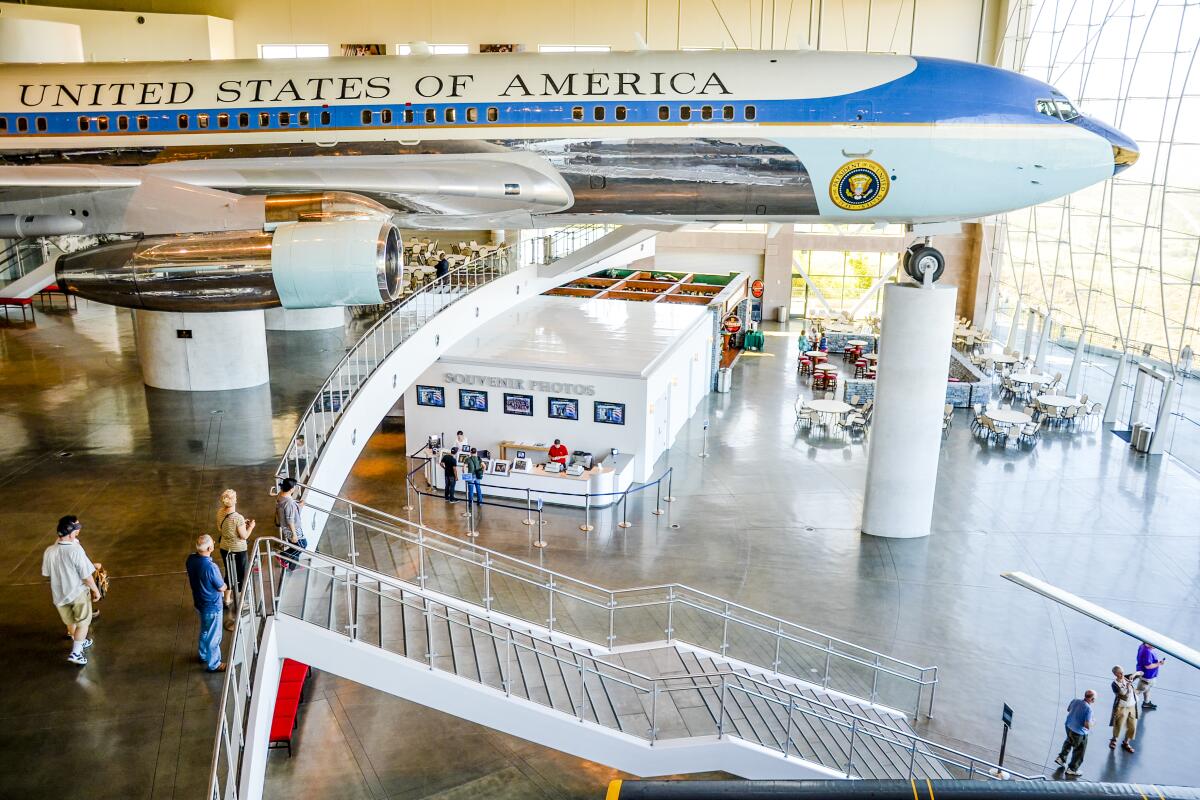
79. Wave like POTUS from the Reagan Library’s Air Force One
Through Oct. 9, a temporary exhibit explores “The Secrets of World War II.”
Bonus tip: Before you admire the museum’s big chunk of the Berlin Wall, read Reagan’s “Mr. Gorbachev, Tear Down This Wall” speech, delivered in Berlin on June 12, 1987.

80. Stalk Ricardo Breceda’s metal beasts in Borrego Springs
Breceda, a Southern California sheet-metal sculptor commissioned by local philanthropist Dennis Avery, has since 2008 placed about 130 rusty works in the flatlands around the hamlet of Borrego Springs. The collection includes bighorn sheep, horses, dinosaurs, a lonely Spanish padre, a scorpion the size of a Subaru and the artist’s magnum opus, a 350-foot-long Loch Ness Monster of the sand.
That serpent — actually a medley of five segments rising from the sand — lies along Borrego Springs Road, 2.3 miles north of Christmas Circle. Many other Breceda beasts are nearby. For a detailed map, stop by the Anza-Borrego Desert Natural History Assn. store near Christmas Circle. Before or after beast-hunting, lie low at Casa del Zorro, cruise along Palm Canyon Drive (Borrego Springs’ main drag) or get a cool beverage at Carlee’s.
Bonus tip: Anza-Borrego Desert State Park, California’s largest, surrounds Borrego Springs. Its most popular hike, the Palm Canyon trail, a three-mile loop, is a tad shorter and darker since 2020, when someone set the trail’s oasis on fire, charring dozens of palms. Rangers have roped off the trees to ease their recovery (which is going well), so instead of entering the oasis, hikers admire it from a nearby overlook, then turn back to complete the loop.
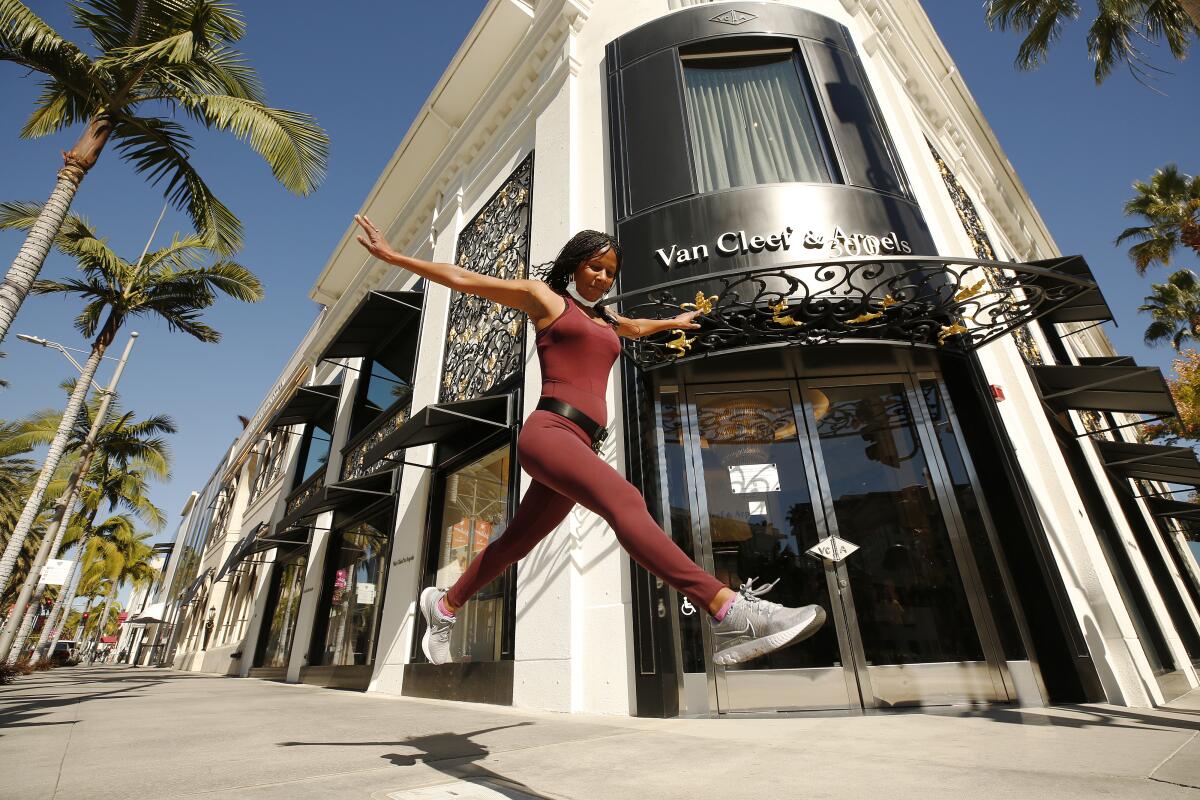
81. Shop and gawk on Rodeo Drive
Bonus tip: Parking can be as tough as making that first $10 million. Street spots are metered at $2 per hour, with multiple structures nearby.
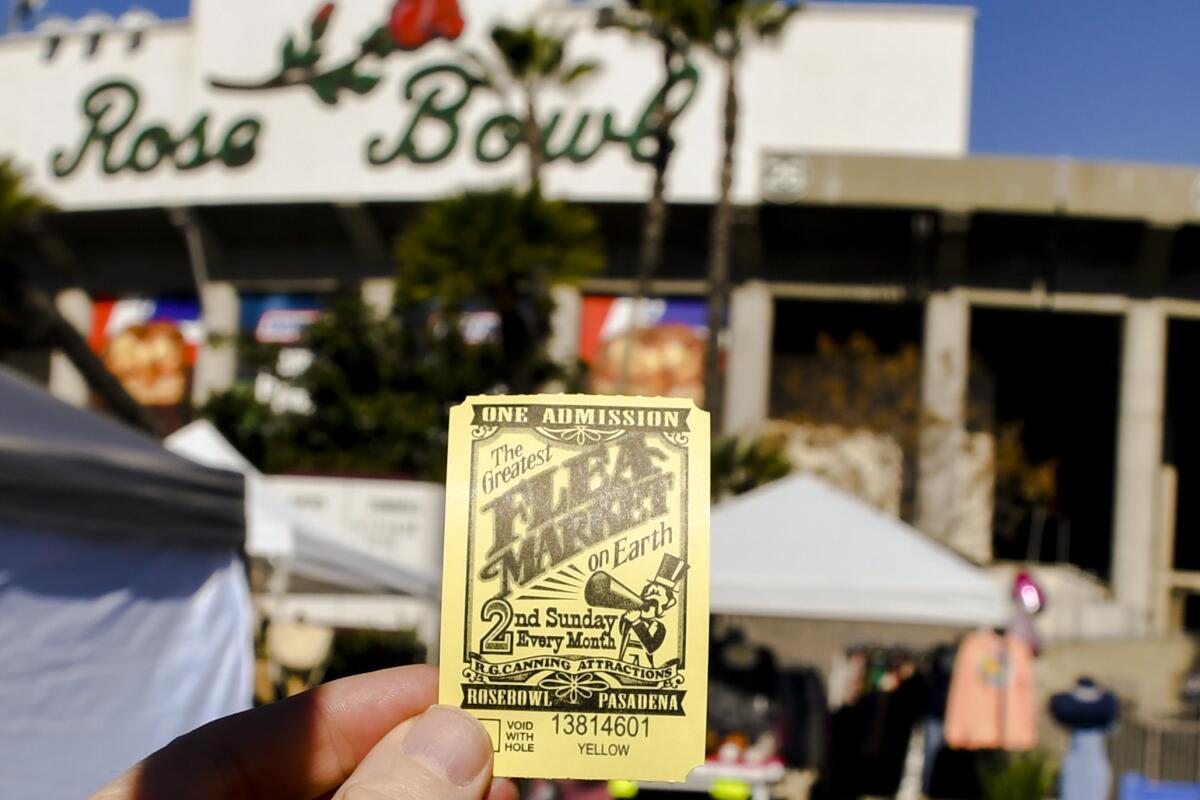
82. Haggle at the Rose Bowl Flea Market
One recent Sunday, I found Fiestaware, siesta wear, disco balls, antique awls, molas, colas, Elvis on velvet, Buddha on a pedestal, Jesus on a cross, Jello molds, foam fingers, maps, caps, stones, phones, pliers, flyers, carpenter’s tools, costume jewels, two old seats from the Los Angeles Memorial Coliseum, hot dogs for $2 and (I should have bargained harder) water for $5.
Entry is $12 per person for buyers, or $20 for early admission. The most convenient parking lot costs $15, with free spaces a bit more distant.
Bonus tip: The outfit that runs the Rose Bowl Flea Market, R.G. Canning Attractions, also runs the Beaumont Outdoor Market (every Wednesday, Saturday and Sunday with some holiday exceptions; 50 cents to enter) in Riverside County.
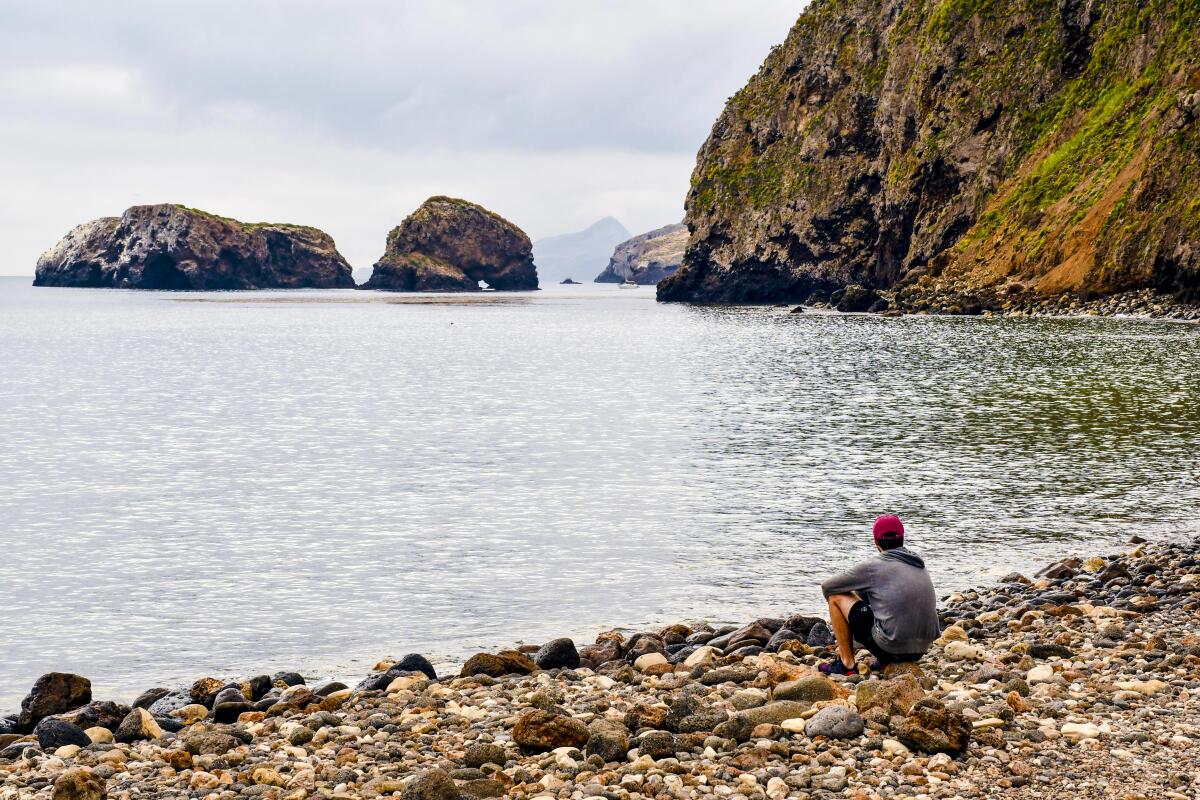
83. Kayak the sea caves (and fend off the foxes) of Santa Cruz Island
The island’s Scorpion Anchorage, where most visitors arrive, is about an hour’s boat ride via Island Packers from Ventura Harbor. (That’s also where the park’s visitor center is.) You can camp (one campground, 31 sites), and you can kayak in sea caves with a guide and rented vessel from Channel Islands Adventure Company. Or hike to Smugglers Cove and back, imagining when the island was a working ranch. Nowadays, the park service controls about a quarter of it, including Scorpion Anchorage. The other three-quarters of Santa Cruz are owned by the Nature Conservancy, which scorns visitors.
Whether you’re camping or just picnicking, keep an eye out for island foxes: The once-embattled population is now so numerous and bold that one may well take a run at your picnic table. Lock up your food.
Bonus tip: There’s another channel island handy, tiny Anacapa, where you can find a 1932 lighthouse, spectacular views, two miles of trails, a minuscule campground (seven sites, no water) and enough swooping, shrieking seabirds to give Alfred Hitchcock pause. It’s due to reopen in summer after a three-month closure for construction of a new dock.

84. Disappear into the scenery at Sea Ranch
From its start in the 1960s, the development has tangled with some environmental groups. Many say frustration over Sea Ranch helped provoke the creation of the California Coastal Commission in 1972. Yet the project also has won design prizes from the American Institute of Architects.
Nobody denies that these handsome homes are in the middle of a beautiful place. It includes six publicly accessible trails, a links-style golf course and an iconic curvy chapel of stone, redwood and stained glass by artist-designer James Hubbell. Rental homes typically go for $225 to $700 nightly. All of Sea Ranch’s roads and most of its trails are private and intended for use only by owners, renters and their guests.
Bonus tip: The Sea Ranch Lodge, a focal point for the community and people passing through, reopened its dining room (dinner, Thursday-Monday), cafe (snacks, breakfast and lunch, daily), bar and general store Oct. 1 after a closure and ownership change in late 2018. In spring 2023, management hopes to reopen the lodge’s 17 guest rooms.
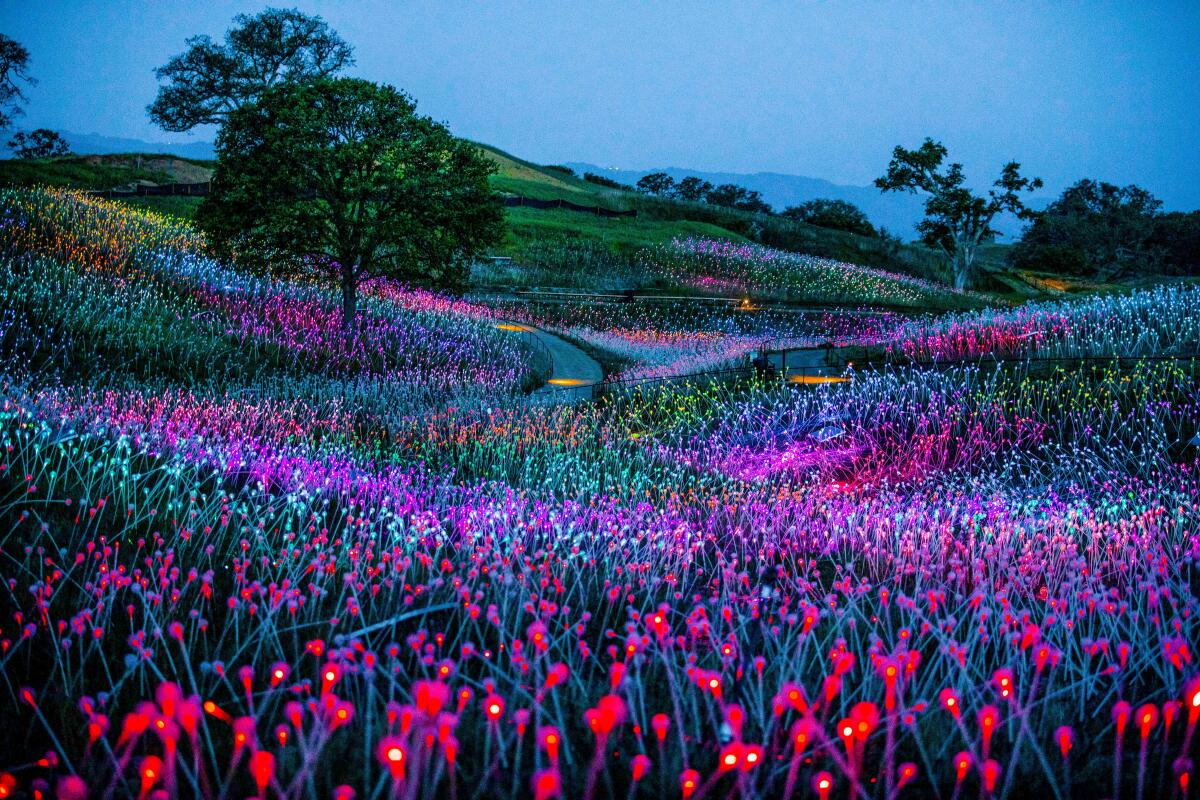
85. Get lit (or illuminated) at Sensorio, Paso Robles
The glow-in-the dark artwork by Bruce Munro began in May 2019 with “Field of Light,” a 15-acre walk-through installation illuminated by 58,000 stemmed spheres with optic fibers inside. Munro has added “Light Towers,” 69 colored towers made of more than 17,000 wine bottles. Their colors change to music.
The lights are big fun, especially the original Field. But really, half of the fun here is just being in those hills while sunset and dusk color the night sky, throwing the oaks into silhouette. Just remember to dress in layers.
Tickets start at $47 for adults, $25 for children. Sensorio sets up Airstream trailers selling beer, wine and spirits. For dinner, Sensorio has a casual kitchen serving corn dogs, burgers, sandwiches and desserts, and a Ricky’s Tacos food truck serves an array of Mexican dishes.
Bonus tip: Between forays to the restaurants and tasting rooms of greater Paso Robles, take a morning stroll (before it gets hot) around grassy Downtown City Park, across the street from the Paso Robles Inn.

86. Cross Oculus Bridge at SFMOMA
Once inside, tread the Oculus Bridge catwalk, which hangs four floors above the San Francisco Museum of Modern Art’s lobby. Next to it stands artist Olafur Eliasson’s “One-Way Colour Tunnel,” which sparkles like purple ice. On the free area of the ground floor, you’ll see Diego Rivera’s epic 1940 mural “Pan American Unity,” on loan from City College of San Francisco through summer 2023.
And if the museum seems bigger than you remember, it is. Its 2016 expansion tripled exhibition space. Ongoing shows focus on American abstraction and German art since 1960. Special exhibitions include “Artists and the WPA,” through July 24, and, through June 26, one comparing 20th century modernists Paul Klee and Lee Mullican.
Adult admission is $25. Closed Tuesdays and Wednesdays.
Bonus tip: Just around the corner from SFMOMA on Mission Street stands the Museum of the African Diaspora.
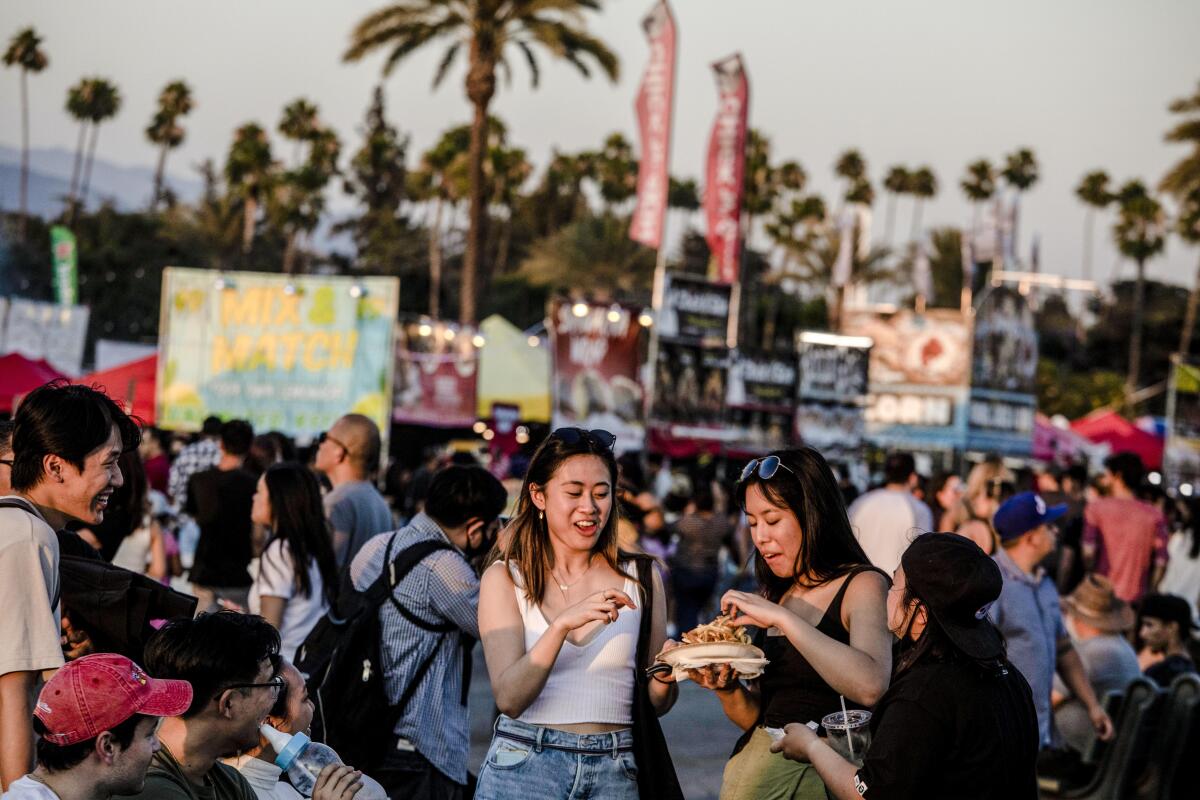
87. Chow down at a 626 Night Market
The event, created by Taiwanese American Jonny Hwang in 2012, is inspired by the varied after-dark marketplaces that thrive throughout Asia and named for the area code of heavily Asian San Gabriel Valley. But it’s not just traditional street food. It’s also a sort of snack lab, full of hybrids and experiments (though not so full of places to sit down). Wandering a mini version of the market in Santa Monica last month, I wound up trying macadamia nut ice-brew coffee, which nicely washed down the bulgogi dumpling from a stand nearby. The pho tacos, snorkel-shaped Hawaiian honey cones and red velvet cake infused with red wine? Maybe next time.
In its early years at Arcadia’s Santa Anita Park racetrack, the market grew to include as many as 250 vendors and 100,000 guests in a long weekend, then paused, shrunk and rearranged itself to endure the pandemic. It returns to Santa Anita July 1-3, July 8-10, Aug. 26-28 and Sept. 3-5.
The 626 Night Market, which also includes clothing, jewelry and crafts, will alight at these other sites in 2022:
— The Alameda County Fairgrounds in Pleasanton May 27-29 and July 29-31.
— The OC Fair & Event Center in Costa Mesa June 17-19.
Admission and parking prices vary by location, ranging from free to $10 each.
Bonus tip: The market seems to have found a winter-spring home in the 310 — specifically, parking lot 27 in downtown Santa Monica. Early this year, the market team staged a series of five “mini” events there — featuring about two dozen food and drink vendors, nine retailers and a bar — from February through April.
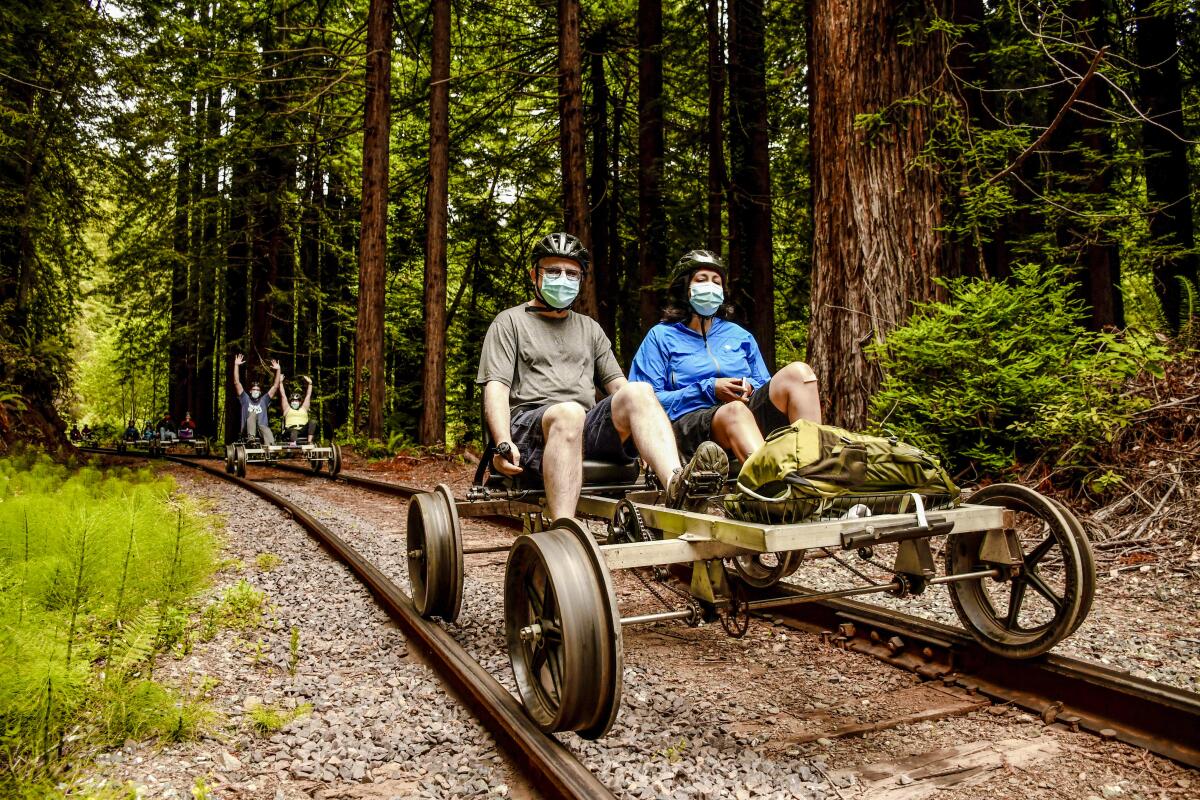
88. Pedal past redwoods on Skunk Train tracks
Bonus tip: If you’re a thrill-seeker, there’s a longer, wilder, pricier railbike adventure — first a mile of hiking, then a 25-mile round-trip pedaling excursion through old-growth redwood forest. The route flanks the Noyo River and sometimes crosses it. In fact, you’ll cross 12 wooden trestle bridges. In warm weather, you might even take a dip in the river. Prices start at $495 per bike.
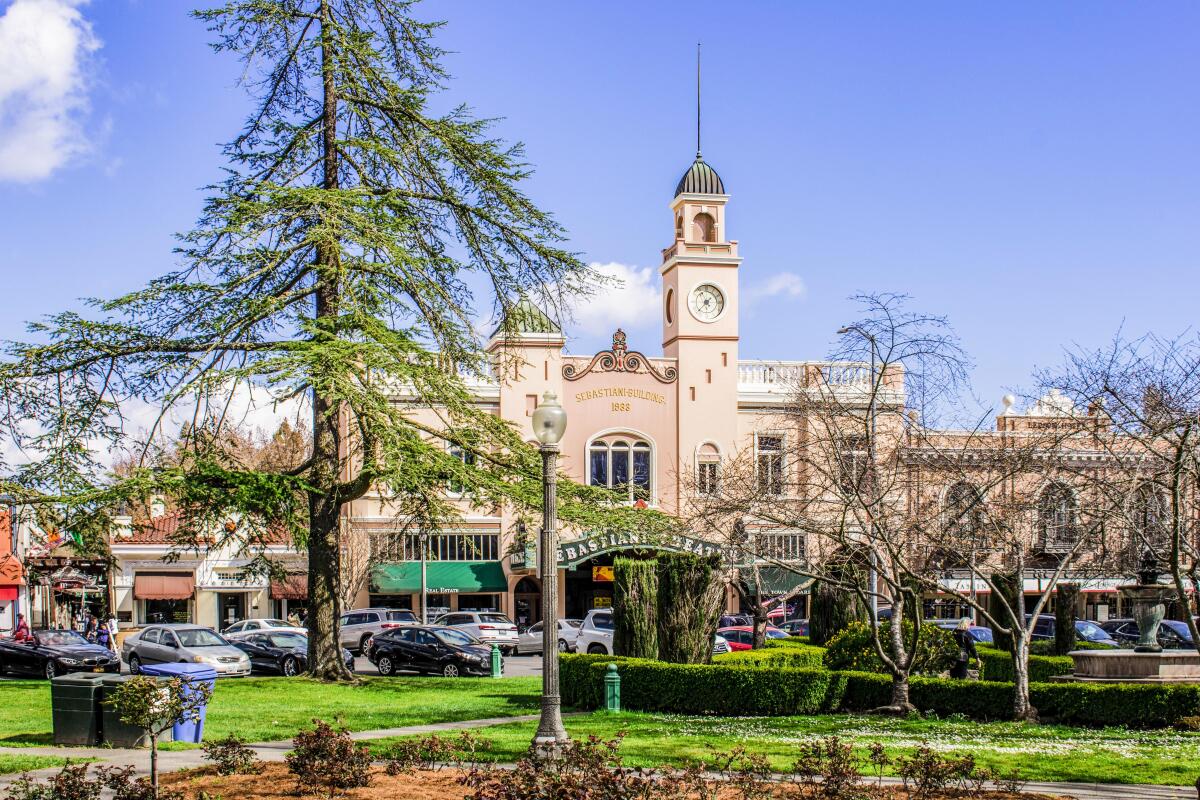
89. Remember the Republic of California in Sonoma’s Plaza
This didn’t last long, but it gave someone time to design a flag with a bear. And it underlined Mexico’s vulnerability. By 1848, the U.S. had grabbed control of Alta California, including Sonoma, in the Mexican War.
Now Sonoma County is at the heart of Northern California wine country, with more than 425 wineries, and there’s still a bear on the state flag. Downtown Sonoma (population: about 10,700) is filled with bistros, tasting rooms and shops. On my last visit, I liked the country-French fare and feel of the Girl & the Fig at the plaza’s northwest corner.
Bonus tip: Don’t miss the Sonoma State Historic Park, which includes Mission San Francisco Solano de Sonoma, founded in 1823. You’ll find a commemorative display, added in 1999, listing names of the baptized native “neophytes” buried in the cemetery — more than 800 of them. At most California mission cemeteries the native dead go unnamed, but the keepers of the Sonoma mission, a unit of the state park system, made this gesture of respect a priority.
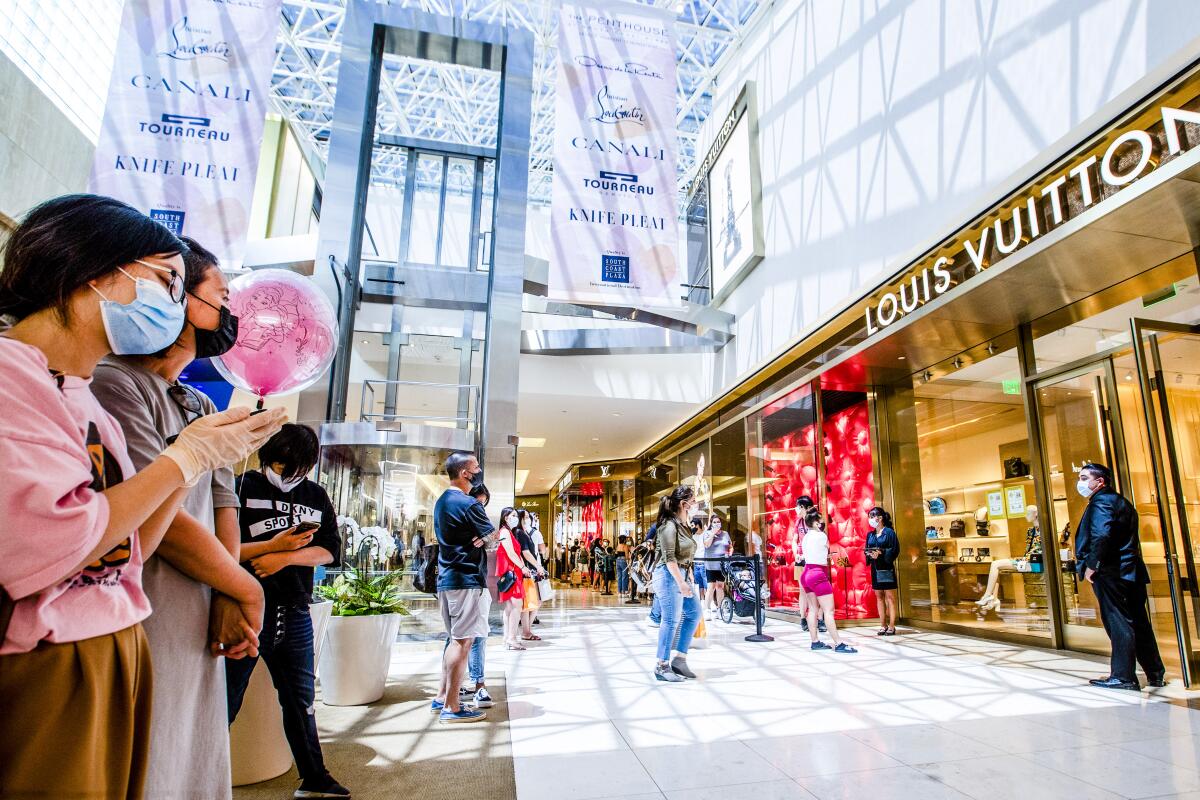
90. Spend madly (or browse for days) at South Coast Plaza
And if you prefer culture to couture, not a problem. Just across Bristol Street from the mall — which is a word the mall people hate, by the way — you’ll find Segerstrom Center for the Arts, which includes venues for classical performances, opera, musicals, pop music and ballet. Traveling productions like “Tootsie” and “Come From Away” play the campus’ largest venue, 3,000-seat Segerstrom Hall — which is not to be confused with the 1,954-seat Renée and Henry Segerstrom Concert Hall (where the Pacific Symphony often plays). The 300- to 600-seat Samueli Theatre is in the same building. South Coast Repertory, also on campus, offers several productions yearly in its theaters.
Bonus tip: The Orange County Museum of Art, formerly of Newport Beach, is scheduled to open its long-awaited new main building at Segerstrom Center in fall 2022. (And it will be free.)
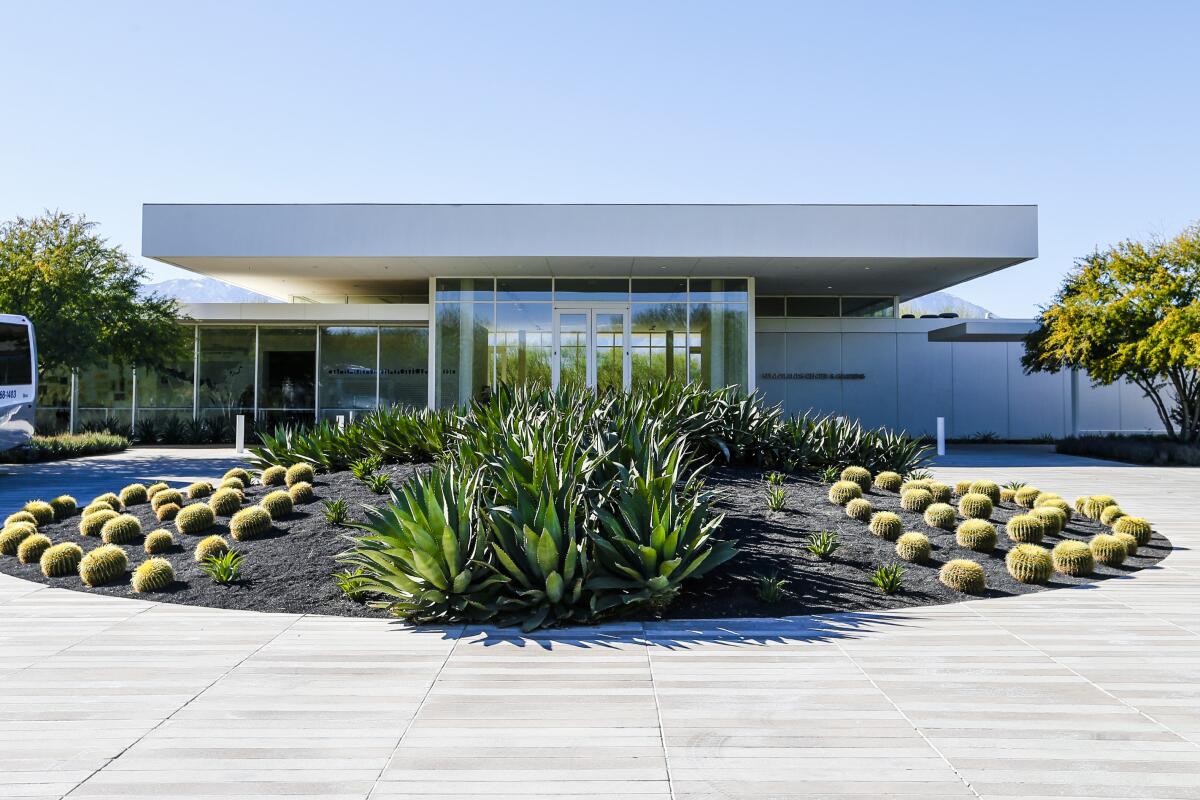
91. Bask in modernist glory at Sunnylands
Sunnylands is a sleek, vast estate that I think of as the White House of Midcentury Modernism. It was the winter playground of Walter and Leonore Annenberg, whose holdings included the hugely powerful (once upon a time) publication TV Guide. Walter Annenberg served as an ambassador for former President Richard Nixon. Leonore Annenberg oversaw protocol for former President Ronald Reagan. They commissioned architect A. Quincy Jones and built the estate (200 acres, 11 lakes) in 1966.
In 2012, after the couple’s deaths, the Annenberg Foundation opened the 15-acre Sunnylands Center and its succulent gardens, including a cafe, gift shop and reflecting pools, to free public visits, Wednesday through Sunday. From fall through spring you can tour the main home or the rest of the estate, but you’ll need a timed ticket, reserved up to a month in advance. (The property closes in summer months.) A $50 house tour (90 minutes) is one of four available.
Bonus tip: For a relatively cheap thrill, grab lunch from the cafe, sit back on the patio and imagine you’re Frank Sinatra on the brink of his fourth marriage. (Yes, that happened here in 1976. The bride was Barbara Marx, Zeppo’s ex.)
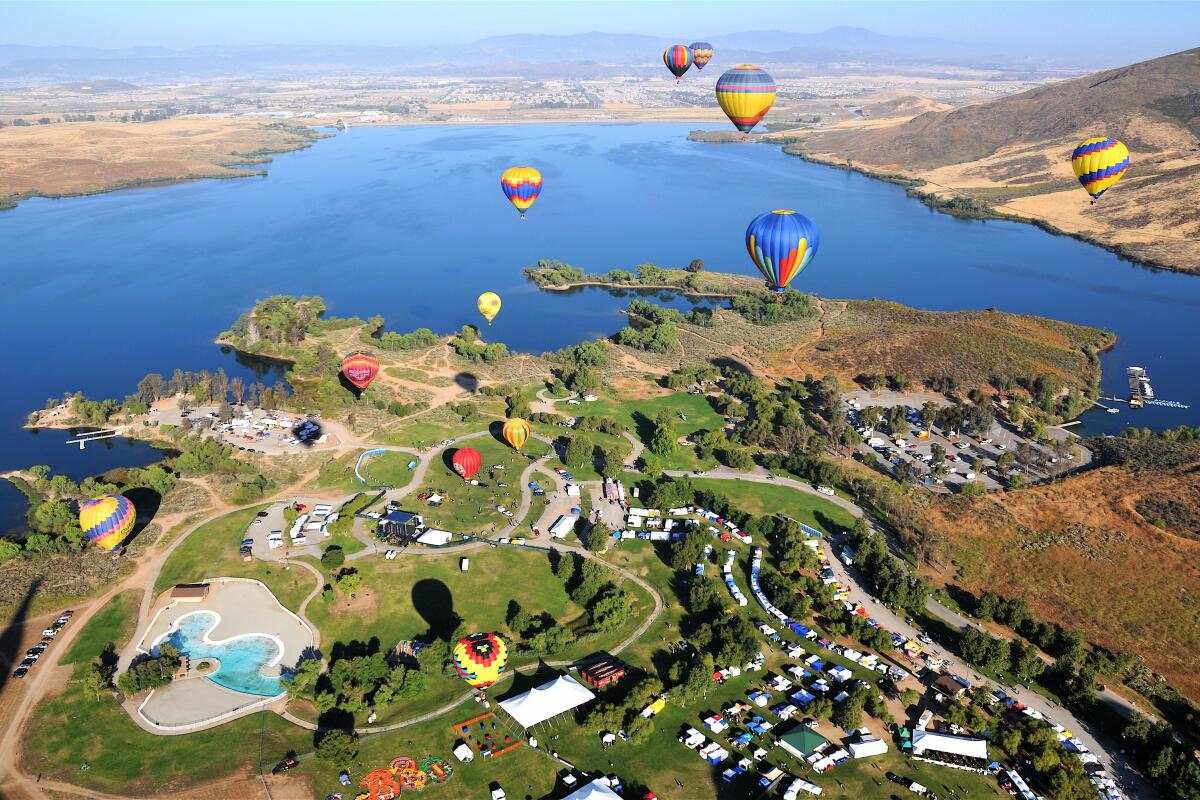
92. Float over Temecula wine country
Yes, you have to get up early, because the wind dies down in the early morning. But it’s a great time for photos. Several balloon companies operate in the area, including California Dreamin’ and A Grape Escape. Weekend shared group flights start at about $200 per person. On a typical flight, you’ll get up to 2,000 feet high and feel the heat (and hear the roar) of the overhead burners that control the balloon’s altitude.
Bonus tip: One ballooning company, Magical Adventure, offers a “mile-high flight” for about $1,250 that is “exactly what you are thinking, naughty one. … You provide the music and any bedding. We separate the pilot compartment from the passenger cabin with a privacy screen.”
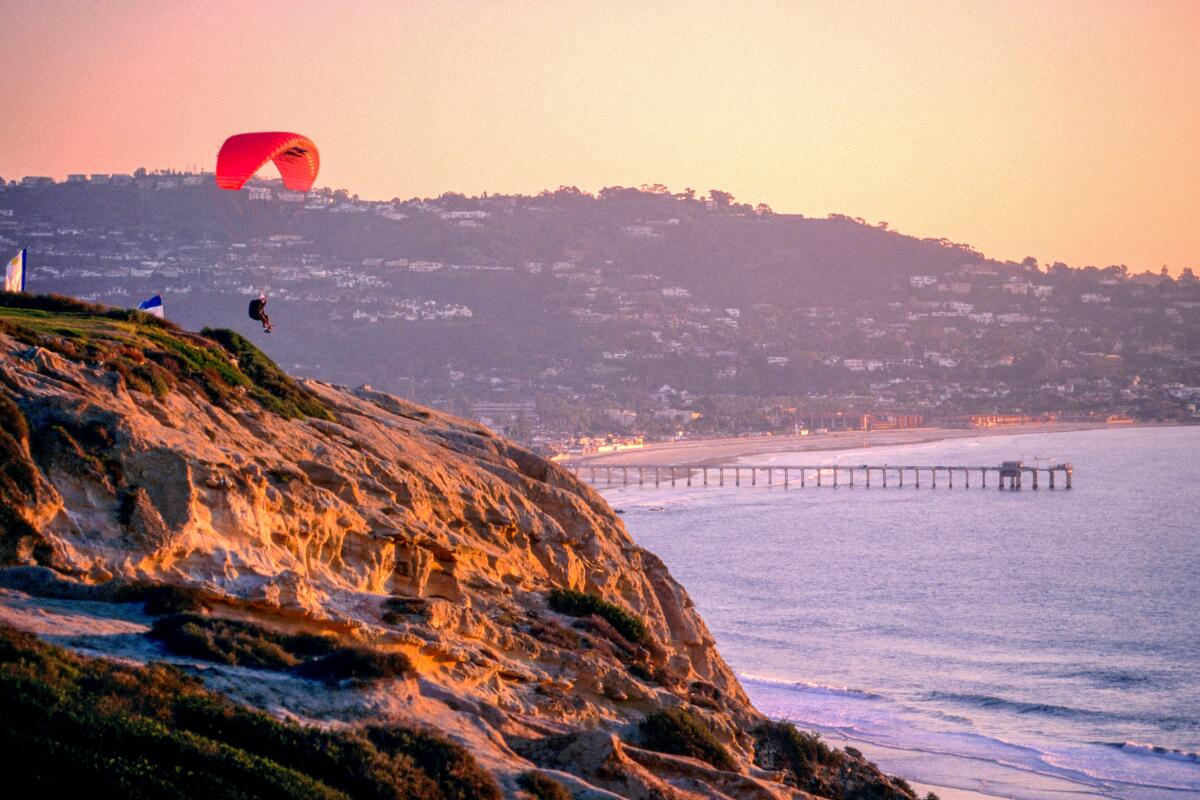
93. Soar (or have a sandwich) atop the Torrey Pines cliffs
Grab breakfast or lunch at the Cliffhanger Cafe (nothing more than $9.49), settle in at a picnic table and watch the action in the air. There are live bands on Saturday afternoons (April through October). See the shoreline about 200 feet below? That’s Black’s Beach, accessible by a steep, half-mile trail. (It has a nude zone.)
Sail planes were taking off here as early as the 1920s. In 1930, Charles Lindbergh glided on these winds. Hang gliders joined in the 1970s, then paragliders, then tandem paraglider flights ($175-$255).
Bonus tip: Next door you’ll find the Salk Institute, whose austere, ultra-symmetrical building has made it an architectural landmark. And on the inland side of North Torrey Pines Road, you have the UCSD campus, including the many playful outdoor artworks of its Stuart Collection and, playing straight man, the brutally top-heavy geometry of its Geisel Library.
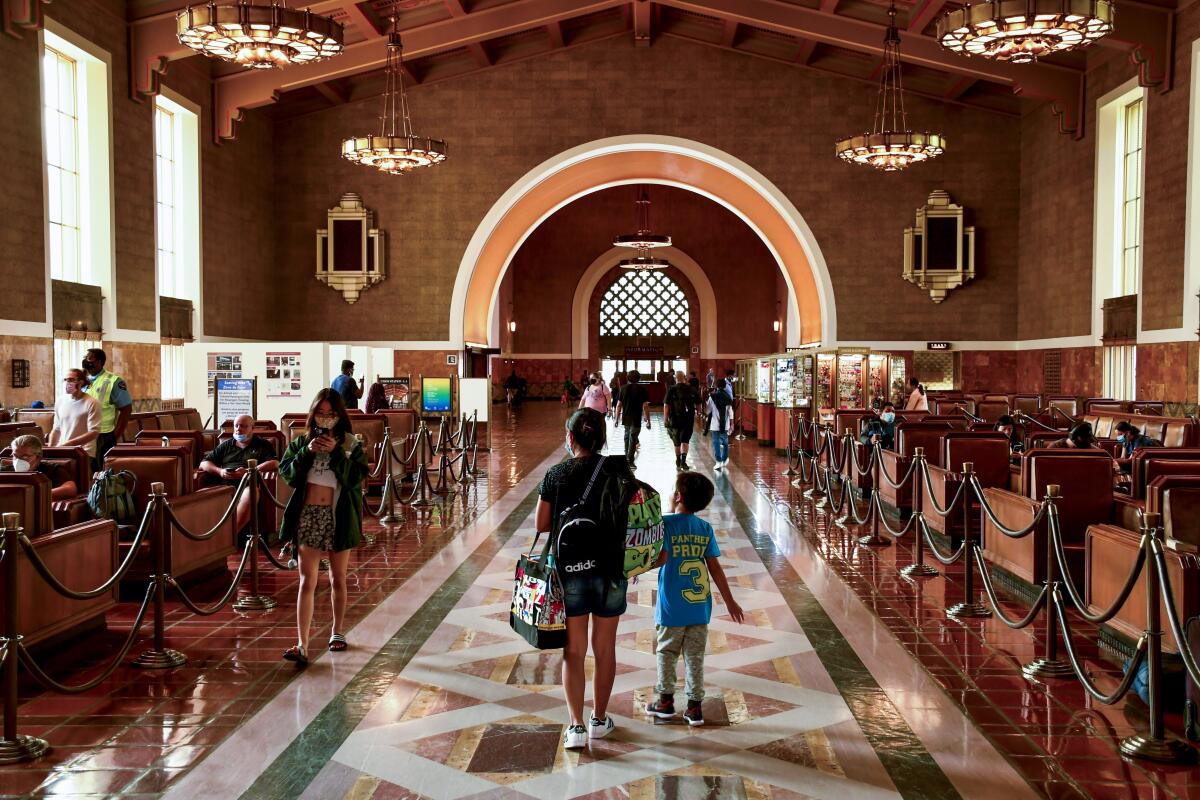
94. Haunt the halls of the last grand train station in America
Until it’s time to roll, get dinner or a drink at intimate Traxx or the cavernous Homebound Brewhaus (in the space where a Fred Harvey Restaurant stood in the old days). Or gawk at the high ceiling, the grand arches and the 286 built-in mahogany chairs (reserved for ticket-bearing travelers) in the waiting area. If you’re lucky, the L.A. County Metropolitan Transportation Authority has scheduled a performance or exhibition. (Remember the 2021 Oscars? Maybe they weren’t everyone’s favorite but they were staged right here.)
Bonus tip: Across Alameda Street stands Olvera Street, the mostly Mexican marketplace that was created in the 1930s to add an air of romantic nostalgia to one of the city’s oldest streets. Results: mixed. The pedestrian walkway is lined with souvenir vendors, eateries and a handful of intriguing shops like Olverita’s Village. The street is part of the 44-acre El Pueblo de Los Ángeles Historical Monument, which includes LA Plaza de Cultura y Artes and the Chinese American Museum. The city of Los Angeles (population: 3.9 million) really did start here in 1781, when 44 newcomers of Native American, African and European heritage arrived after a long walk from what is now northern Mexico.
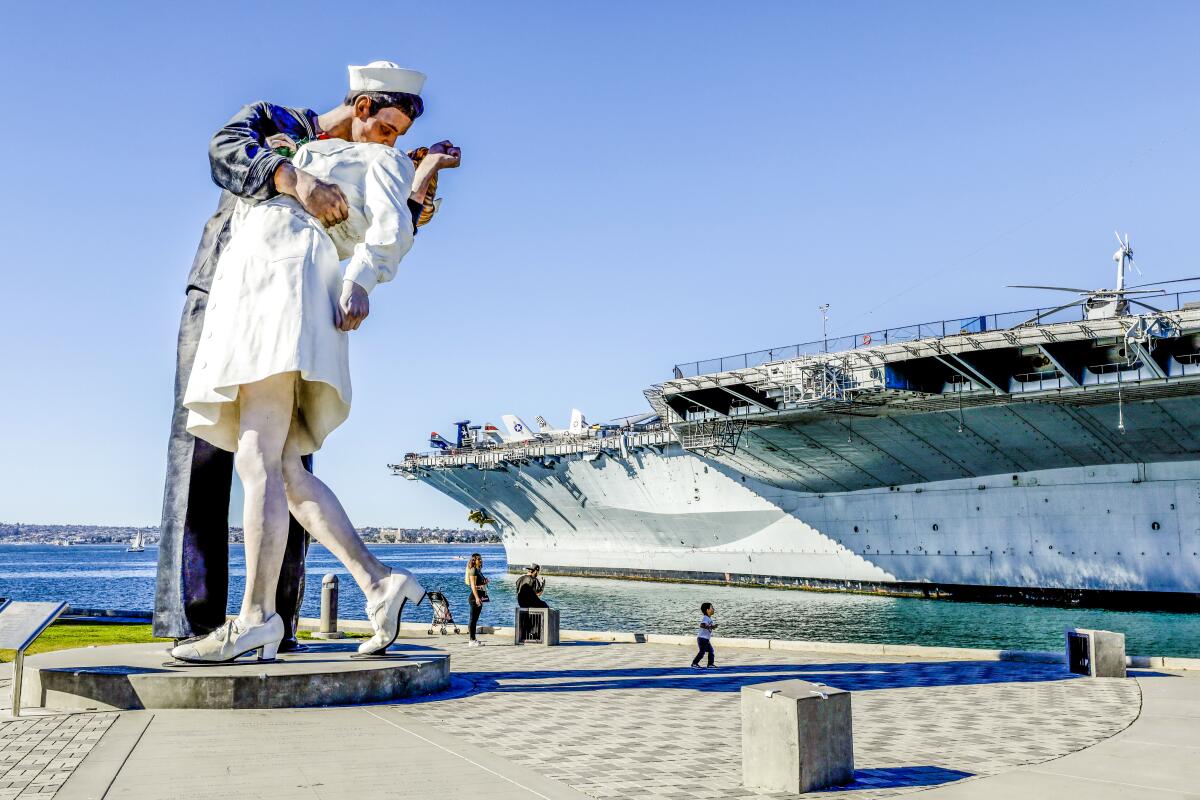
95. Pace the flight deck of the USS Midway
Bonus tip: Just a mile north of the Midway along the Embarcadero, the Maritime Museum of San Diego has gathered 10 historic vessels for your inspection. The marquee attraction is the Star of India, an iron-sided 1863 windjammer built on the Isle of Man. Museum staffers take it out once or twice a year, thus supporting their claim that the Star is “the world’s oldest active sailing ship.” Adult admission is $20.
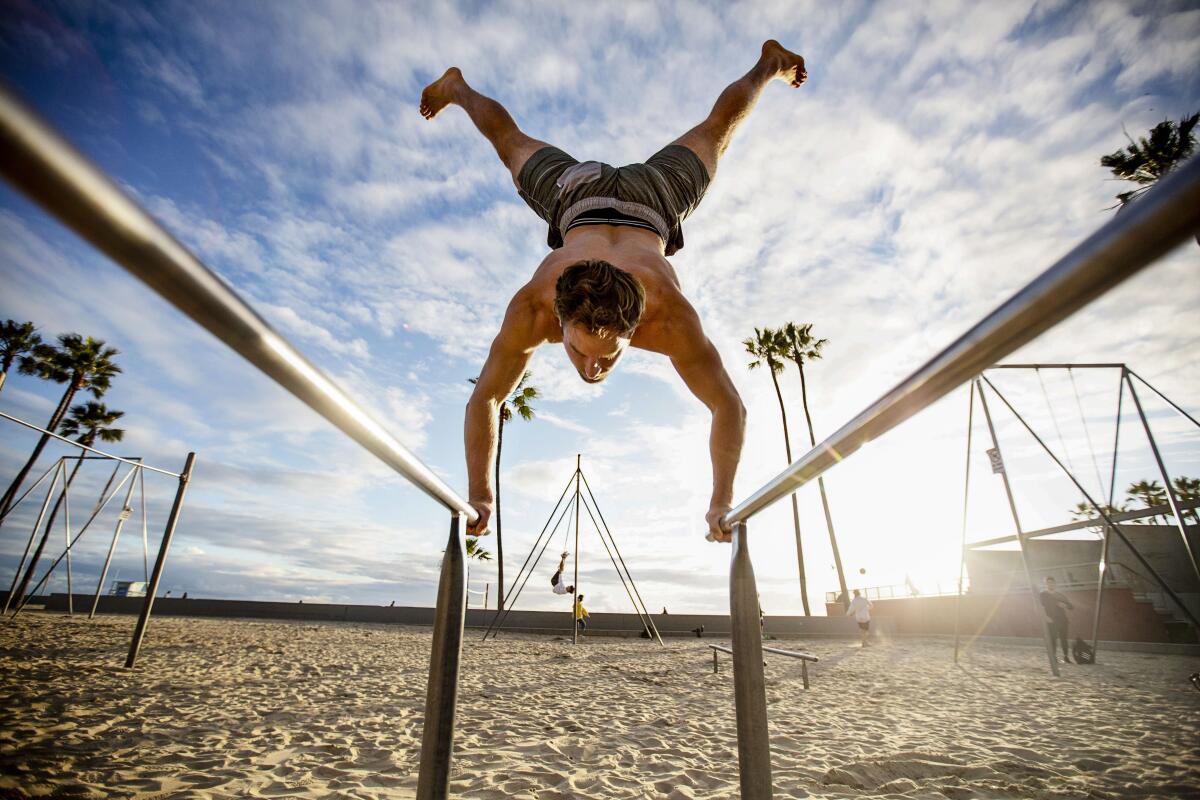
96. Walk, bike or flex your muscles on the Venice Beach boardwalk
Take in the careening teens at the Venice Skate Park, the cyclists, the busy basketball courts, the fishing pier, Muscle Beach bodybuilders and the quirky Small World Books. Check out the Sunday evening Venice Electric Light Parade. Save time (or another day) for the canals just south of South Venice Boulevard and the upscale restaurants, galleries and shops along Abbot Kinney Boulevard. Depending on the block, and on the latest chapter in the city’s struggles to help house the homeless, you may find many tents or not.
Parking can be tough but there are three nearby county lots. Get there early.
Bonus tip: The Sidewalk Cafe (at Horizon Avenue) is a prime place along Ocean Front Walk to sit and watch people. The Venice Ale House (at Rose Avenue) is another.
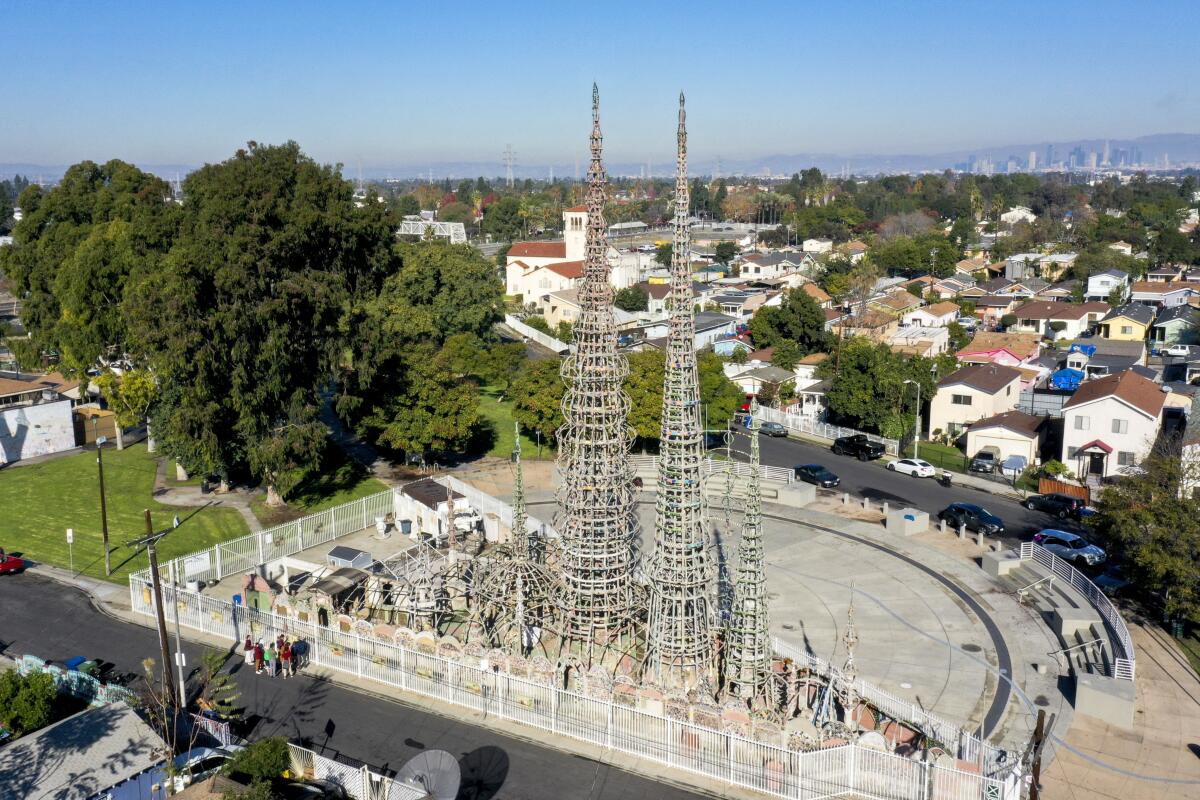
97. Crane your neck at Watts Towers
Sabato (Simon) Rodia, an immigrant from Italy, started this backyard project in 1921 and spent 33 years putting up Watts Towers, using rebar, concrete, cast-off tiles, bottle caps and bits of colored glass (especially blue Phillips’ Milk of Magnesia bottles). He walked away in 1954 and died in 1965. Yet his towers survive (despite recurring neglect and incompetence by public agencies), and they have inspired many local children to pursue creative careers (including celebrated assemblage artist Betye Saar, jazz great Charles Mingus and rapper-philanthropist Nipsey Hussle). It’s now protected as a state historic park and neighbored by a community arts center. The area inside the triangular property’s walls is closed indefinitely for restoration work, but you can see plenty from outside the fence.
Bonus tip: To learn more about Black culture in South Los Angeles and beyond, head to the California African American Museum in Exposition Park (eight miles north of the towers) or Eso Won Books in Leimert Park (12 miles northwest).
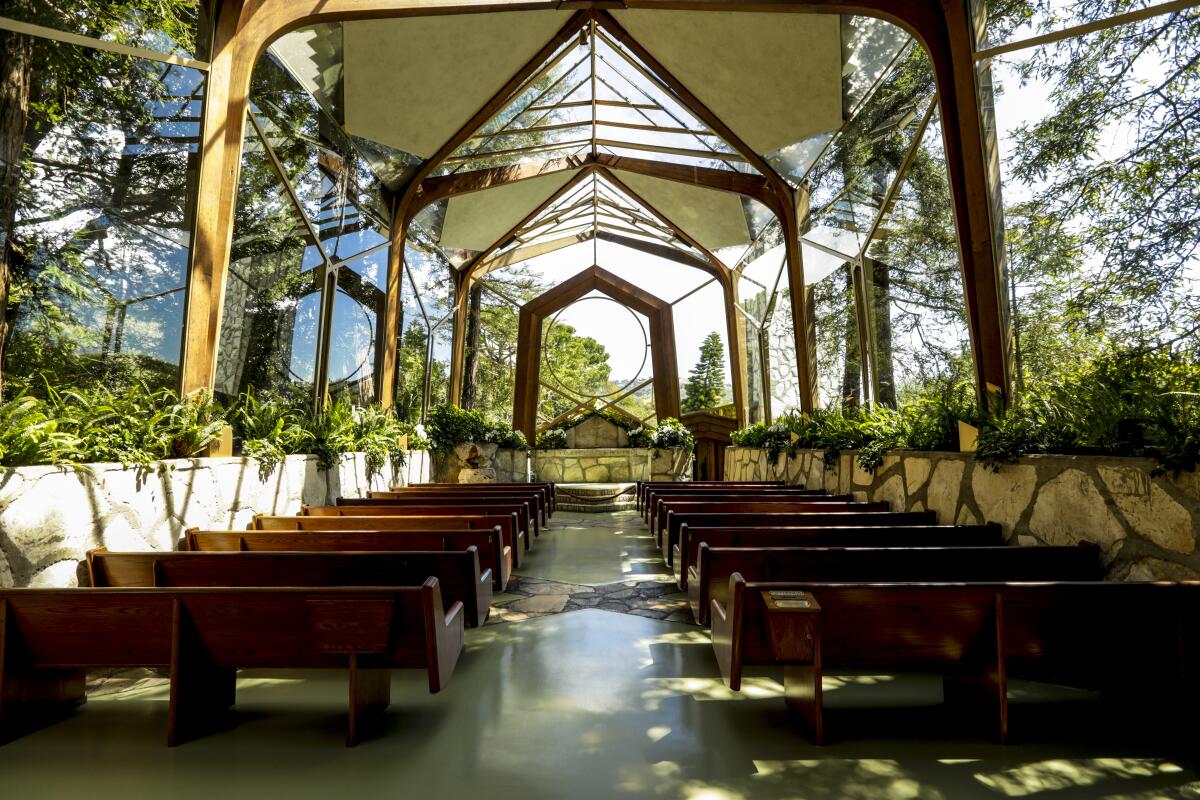
98. Stand inside (and feel the outside) at Wayfarers Chapel
Designed by Lloyd Wright for the Swedenborgian Church and opened in 1951, Wayfarers Chapel’s glass walls and ceiling effectively make the surrounding redwoods a part of its architecture. The result is a “tree chapel” that uses locally quarried stone and blurs distinctions between inside and outside, spirituality and nature. Many architects call this style Modern Organic. Whatever language you prefer, it’s nice to see the sky and greenery from inside the sanctuary, and location scouts seem to agree: The Rancho Palos Verdes landmark has shown up on television offerings from “The Bachelorette” to “Lucifer” and “The O.C.”
Want to book a Saturday afternoon wedding in 2022? That’ll be $6,400 for up to 100 guests, if there’s a day still open.
Bonus tip: The chapel grounds are open daily from 9 a.m. to 5 p.m.; the visitor center, Thursday-Sunday, 10 a.m. to 5 p.m. Because the chapel books its weddings, baptisms and memorials at 10 a.m., noon, 2 p.m. and so on (especially on weekends), the best way to get inside the sanctuary is to show up at 9 a.m., 11 a.m., 1 p.m. or 3 p.m. — the odd hours — when visitors are allowed for up to 30 minutes. Drones are banned.
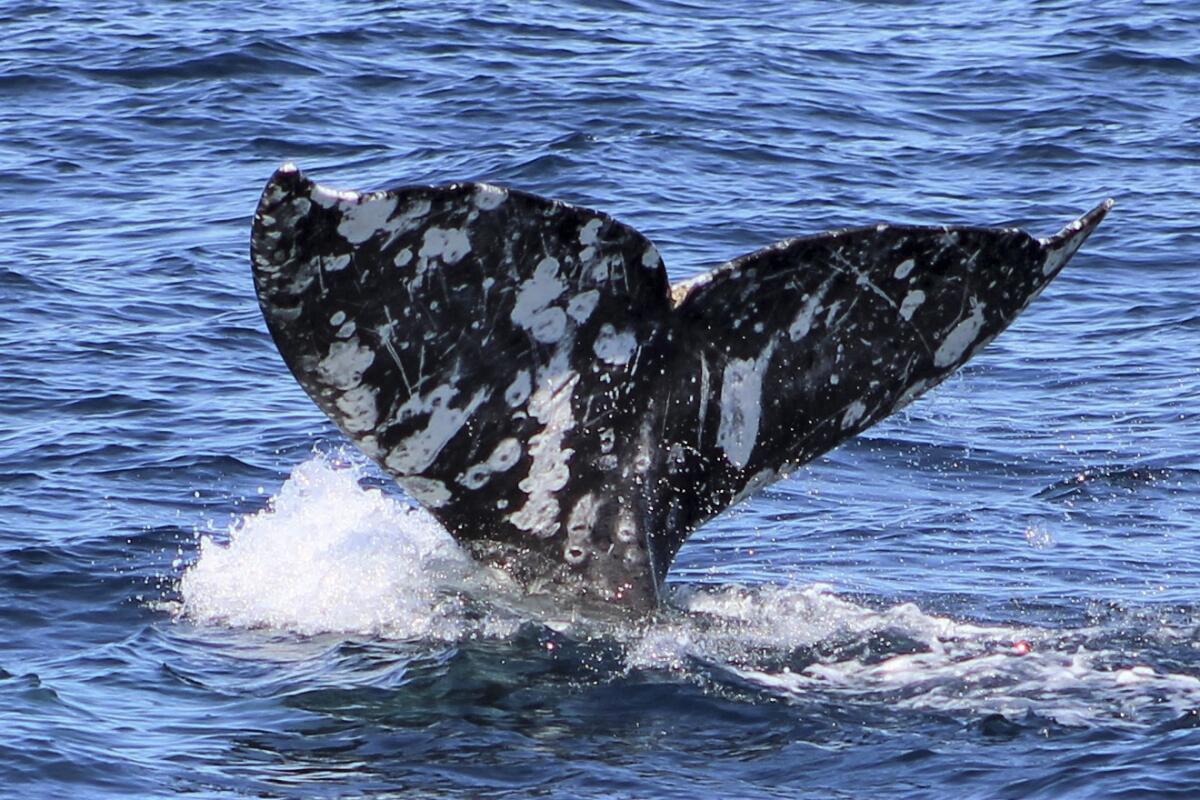
99. Sight whales off the San Diego coast
If you don’t want to wait until winter, blue whales swim through the same coastal waters May through November. Also, as San Diego Whale Watch likes to remind people, sightings of fin whales, humpback whales and minke whales are possible year-round. And whenever you go out, you may come across pods of dolphins, sometimes hundreds, leaping in the surf. Several dolphin species are common in these waters.
Winter whale excursions typically last two to four hours and cost $40 to $55 per adult. On any of those boats, you should hear plenty about the wonders of Eschrichtius robustus (the gray whale), which grows up to 49 feet long, often migrating 10,000 miles (round trip) in a year.
Bonus tip: San Diego also has a few strong spots for whale watching from land, especially Torrey Pines State Natural Reserve in La Jolla and Cabrillo National Monument on Point Loma.
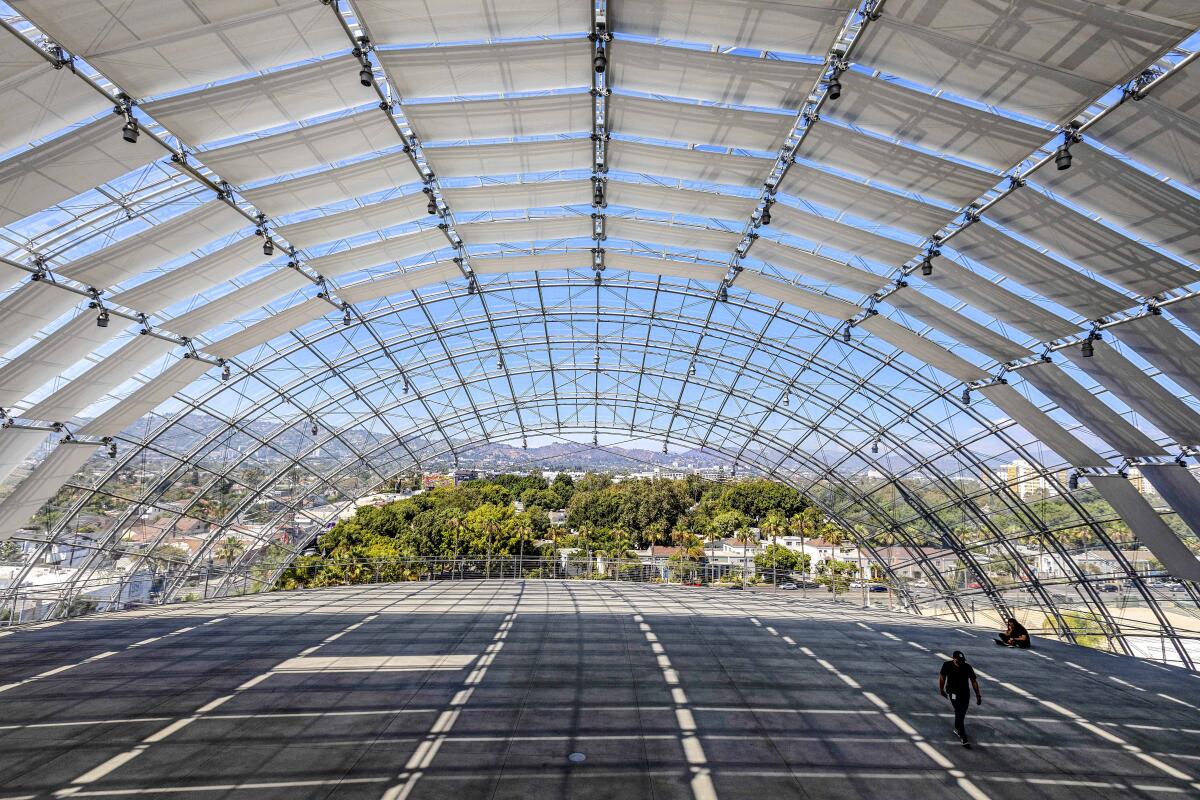
100. Queue up for movies, art, tar pits and cars on Wilshire Boulevard’s museum row
The six-level museum occupies a former May Co. department store, and includes a domed theater designed by Renzo Piano. This year’s exhibitions include a history of Black cinema, the invention of the SteadiCam and the art of backdrops. Admission (by timed reservation) is $25 for adults. For another $15, you can hear your name announced onstage in the museum’s “Oscars Experience.”
Meanwhile, the Los Angeles County Museum of Art next door is partially open while undergoing reconstruction. At no cost, you can walk beneath the “Levitated Mass” boulder and take a selfie at the “Urban Light” lampposts. LACMA’s new main building is to open in 2024. So is a Metro subway station a few steps away at Wilshire and Fairfax.
Bonus tip: That’s a full day of museum-going already. But a few steps farther east, you find the goo and bones of the La Brea Tar Pits & Museum. Across the street from the Academy Museum (beneath that odd exterior of irregular metal bands) is the Petersen Automotive Museum. Two blocks east, still on Wilshire, there’s Craft Contemporary, a museum dedicated to “the potential of craft.”
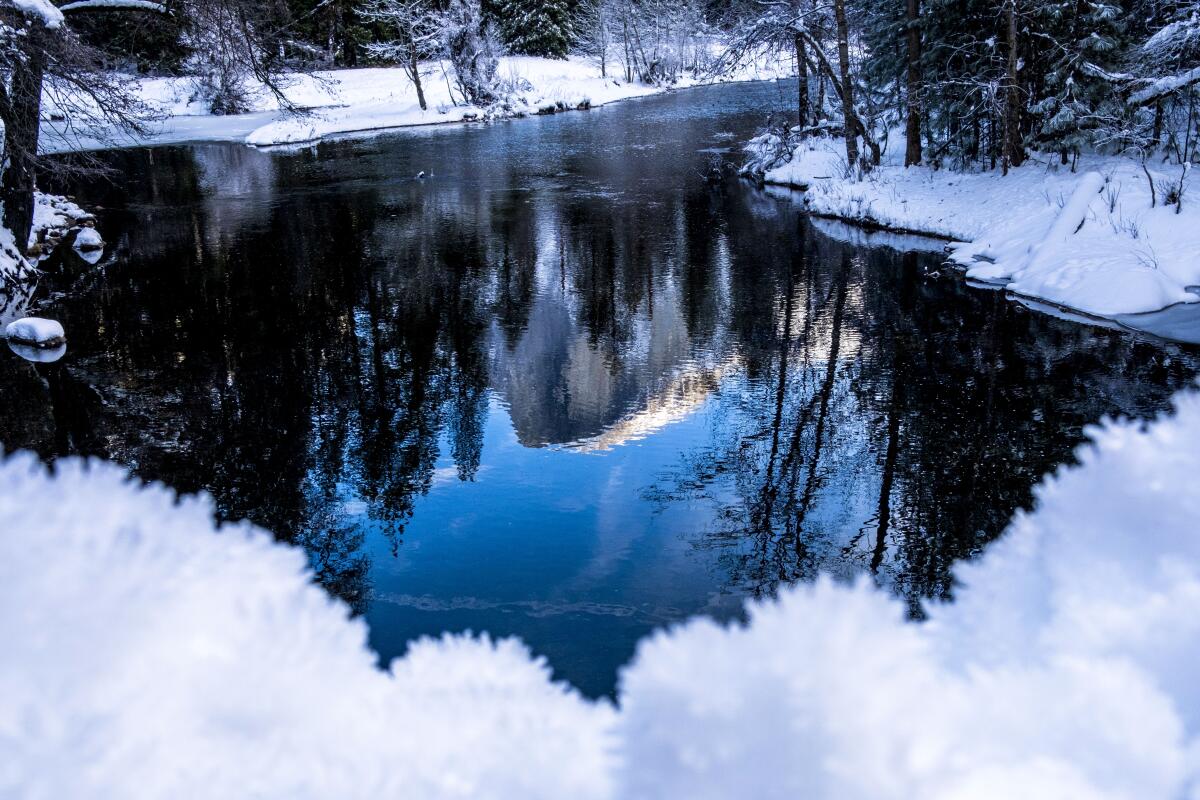
101. Feel small in Yosemite Valley
Yes, it’s worth the advance planning. Yosemite Falls, the great spigot of Yosemite Valley, is North America’s tallest waterfall, a 2,425-foot medley of cascades. Cower at the bottom or climb the Yosemite Falls Trail to Columbia Rock (two miles round-trip). Or try the Mist Trail to the top of Vernal Falls. Or just meander through the grand public rooms of the Ahwahnee Hotel (where overnight rates start around $590). If the valley doesn’t make you feel small one way or another, it may be time to seek professional guidance.
Bonus tip: Remember, the valley is just six square miles in an 1,187-square-mile park. If you can, drive into the high country via Tioga Road (which usually opens in late May or June) to Olmsted Point, Tuolumne Meadows and Tenaya Lake. Unfortunately you can’t drive to the spectacular view at Glacier Point in 2022, because the road is being repaired.
Sign up for The Wild
We’ll help you find the best places to hike, bike and run, as well as the perfect silent spots for meditation and yoga.
You may occasionally receive promotional content from the Los Angeles Times.
